|
|
Post by codystarbuck on May 9, 2021 17:48:17 GMT -5
ps The "matron" of the club, as seen on the splash page, looks a little like Bette Davis, though the hair color is too dark. I suspect the artists were working from either black and white photos or the film. It kind of feels like a composite of Davis and Joan Crawford, though she didn't have a mole like that, either. Might just be an addition by the artist.
|
|
|
|
Post by codystarbuck on May 13, 2021 17:59:01 GMT -5
Young All-Stars #6 Dan the Dyna-Mite gets the cover and it appears to have been chili night, for the All-Stars! Creative Team: Roy & Dann Thomas-writers, Brian Murray (1-4), Howard Simpson (5-24) & Michael Bair (24-26)-pencils, Malcolm Jones III & Bob Downs-inks, Jean Simek-letters, and an empty space is the colorist. On the letters page (carried on the inside of the cover, front & back) Roy says they will have rotating pencils, between Brian, Howard and Michael, with a 4th involved. They will work on specific storylines, then trade off. This is not dissimilar to how Sandman was penciled. I do have to say, given the fact that the title of this book sounds like a movie from the 1930s or 40s, Roy missed a chance to title this issue "Young All-Stars of 1942!" Should have consulted me, Roy.  Synopsis: Synopsis: Neptune Perkins has followed Sandy out onto Cahuenga Blvd, looking for the others and Sandy says he say Arn & Fox leave and Dan & Fury follow, but has no idea where they went (plus he throws verbal jabs at Perky). They soon find out, as Dan, Betty and Ronnie (yes, Betty and Veronica, it only just hit me as she was only called Ronnie in the previous issue and she's a redhead) come roaring in and recap the fight with Axis Amerika. 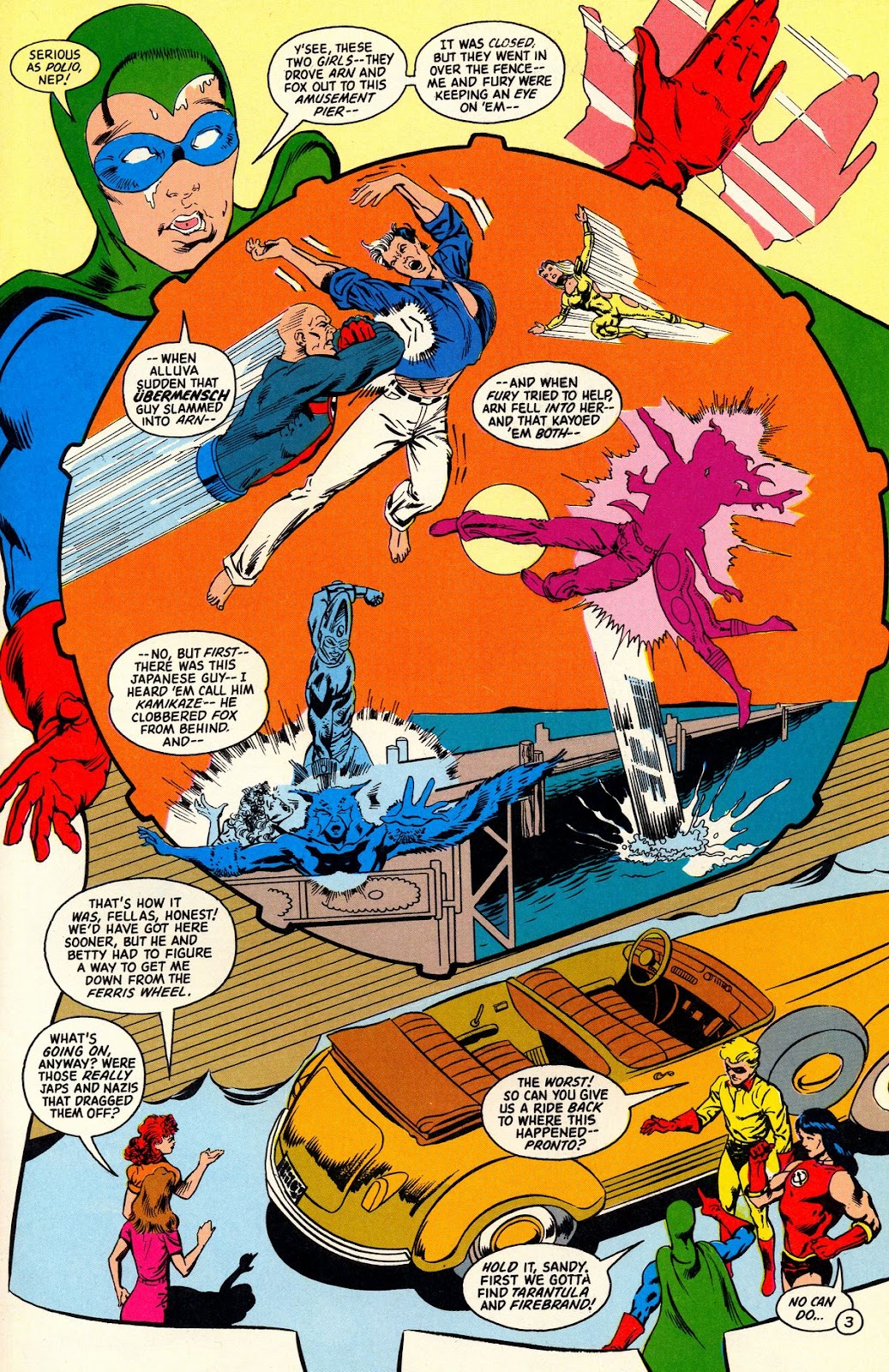 Dan thinks they should find Tarantula and Firebrand, but Perky says they have been dragged off by politicians and they don't have time to hunt them down. Ronnie is keen to drive them wherever they need to go, but Betty has had enough, until she is goaded enough into coming along. Perky says to take them to the Santa Anita racetrack. Ronnie drives them and the guys break into the compound and find Miya and eventually (after much arguing) convince her to help, though only after she hears about Kamikaze. She knew him when the Japanese scientists gave her her powers. 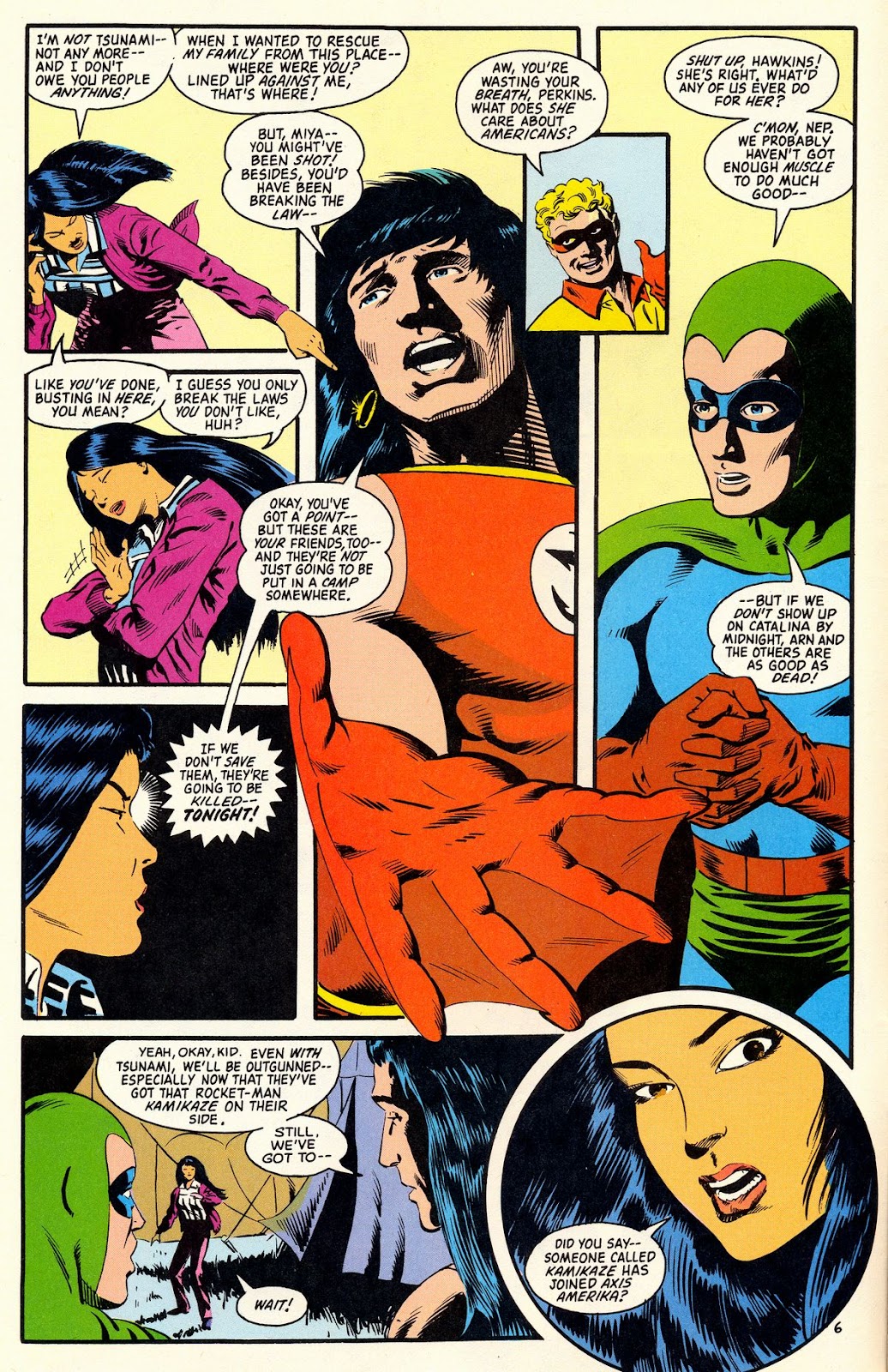 Her mother brings her costume (though you'd think a 1940s mother would disapprove of how much skin it shows off) and Tsunami rejoins the rest. Ronnie takes them to the airport and they leave in the All-Star plane, with Sandy at the controls. it seems Sandman has been teaching him to fly a plane. They head for Santa Catalina, which is now a military training ground and off limits to civilians (since Pearl Harbor). Perky directs Sandy to head for the highest point of the island, as an airstrip had been cleared there, before the war. It has been blocked by obstacles, to prevent its use by the enemy and they spot an inky black cloud over it, which Dan points out is just like Santa Monica, when Axis Amerika attacked. sure enough, before you can say Wagner, here comes Gudra and Kamikaze... 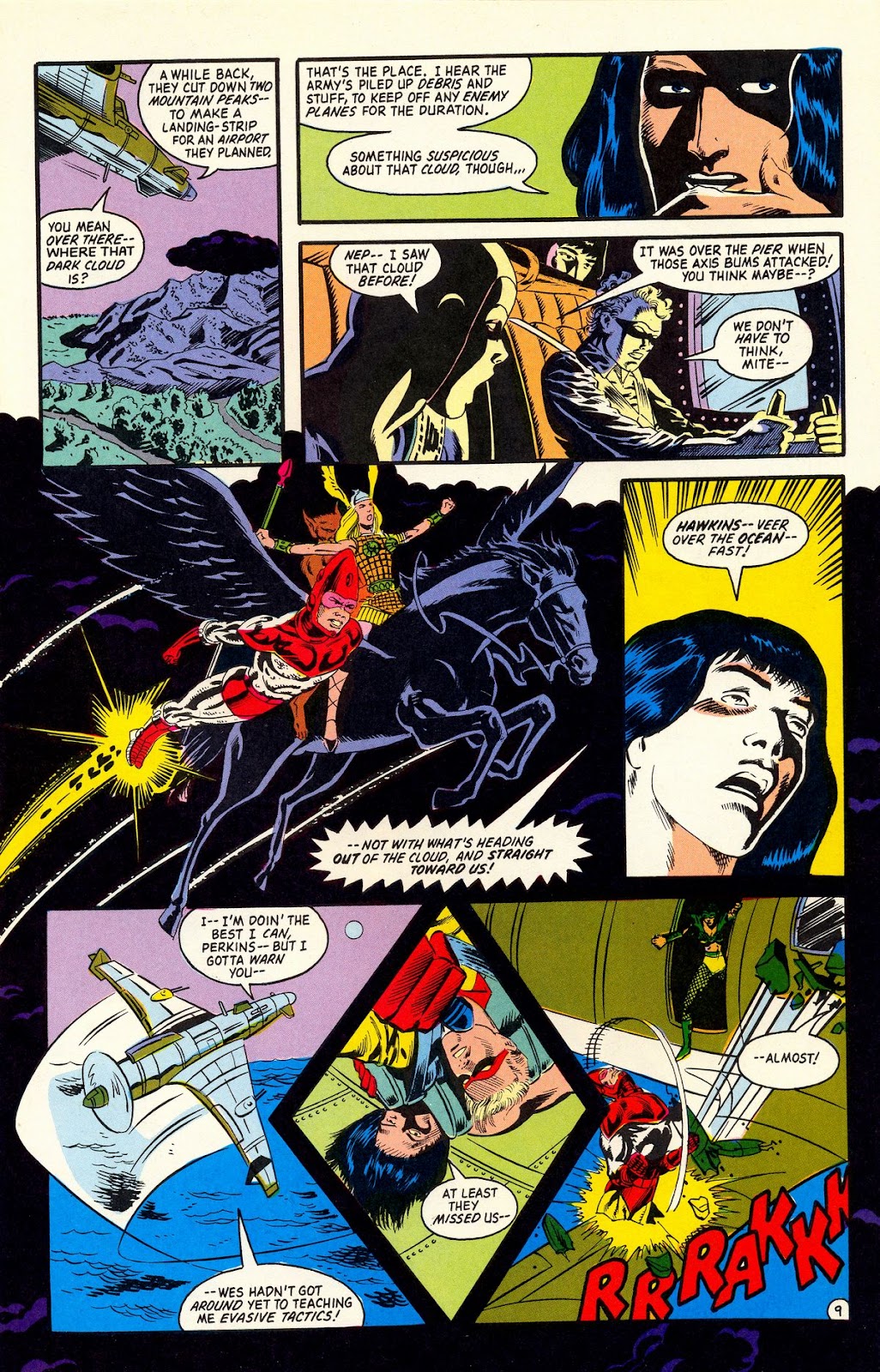 Kamikaze hits the starboard wing, then Tsunami leaps onto him and drags him down to the water (overloading his rockets, while Perky dives onto Sea Wolf, who is riding behind Gudra. The rest of the troop watch from below, as we see Flying Fox, Arn and Helena all restrained. Fox is tied to the propellers of a large bomber (not a B-17 and it doesn't really look like any actual aircraft), while Helena, in her normal form, is chained to the ground (which would make Marston proud) and Arn is encased in concrete (though they stopped short of encasing his entire body and suffocating him). 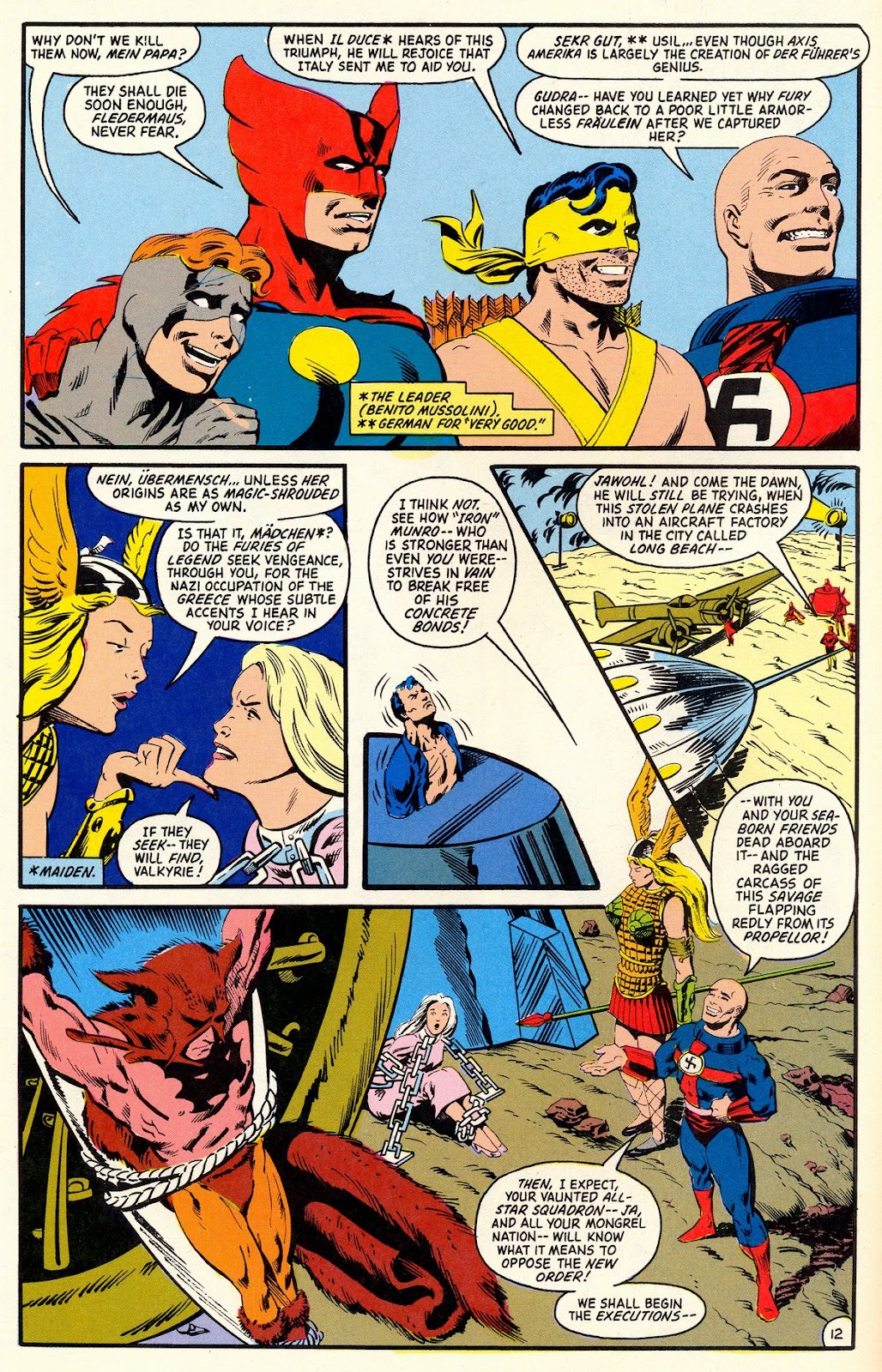 They haven't learned why Fury reverted to Helena, when she fell unconscious, but Ubby says their dead bodies will be put in the plane, which will be crashed into a Long Beach aircraft factory, as a big middle finger to the US. Right back atcha, pal! Perky evades Wolfie underwater, but he can't breathe underwater, so time is running out. He leads Wolfie into the wreck of an old galleon and right into a mast, which knocks him out and he transforms into a human, who is carried back to the surface by Perky. Tsunami hits Kamikaze with her namesake, which knocks him loopy, but not out of the game. He gets away. Ubby taunts Arn, saying he knows he is the son of Hugo Danner and that they are "brothers," whatever that means. Fledermaus taunts Helena and spits in her eye, like the creepy little Nazi he is, much to papa Horned Owl's joy. 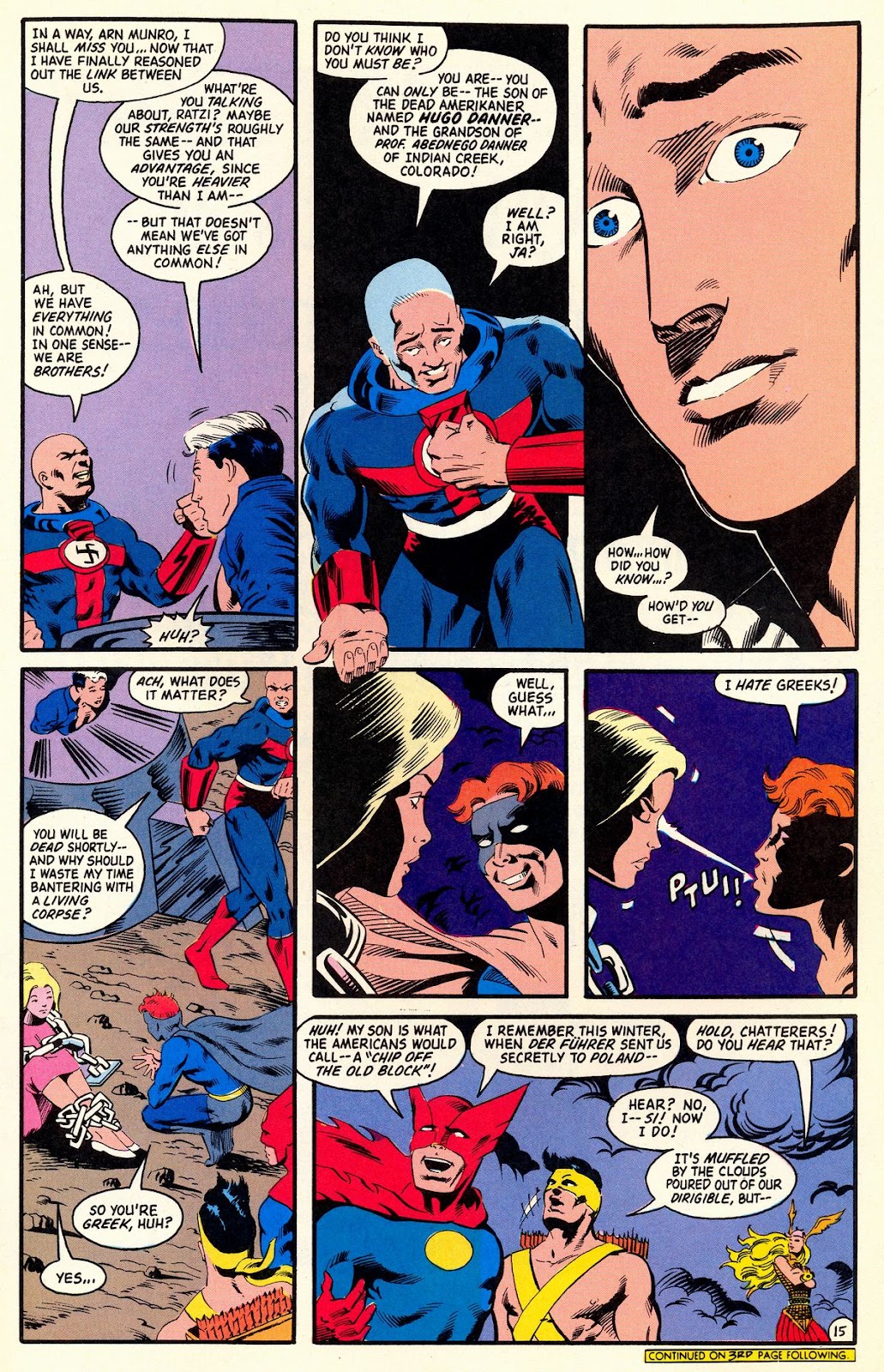 They are interrupted by a roar and Sandy crashes the All-Star plane into the Nuremburg, while he and Dan bail out. The plane ignites the hydrogen in the Nuremburg and it is toast, though Howard Simpson has, apparently, never seen the footage of the Hindenburg to see what happens to a dirigible when its lifting gases are ignited). Dan just happens to notice that he had put Tex's ring on his other hand and suddenly has the inspiration to bang them together; and, wouldn't you know it? He explodes! 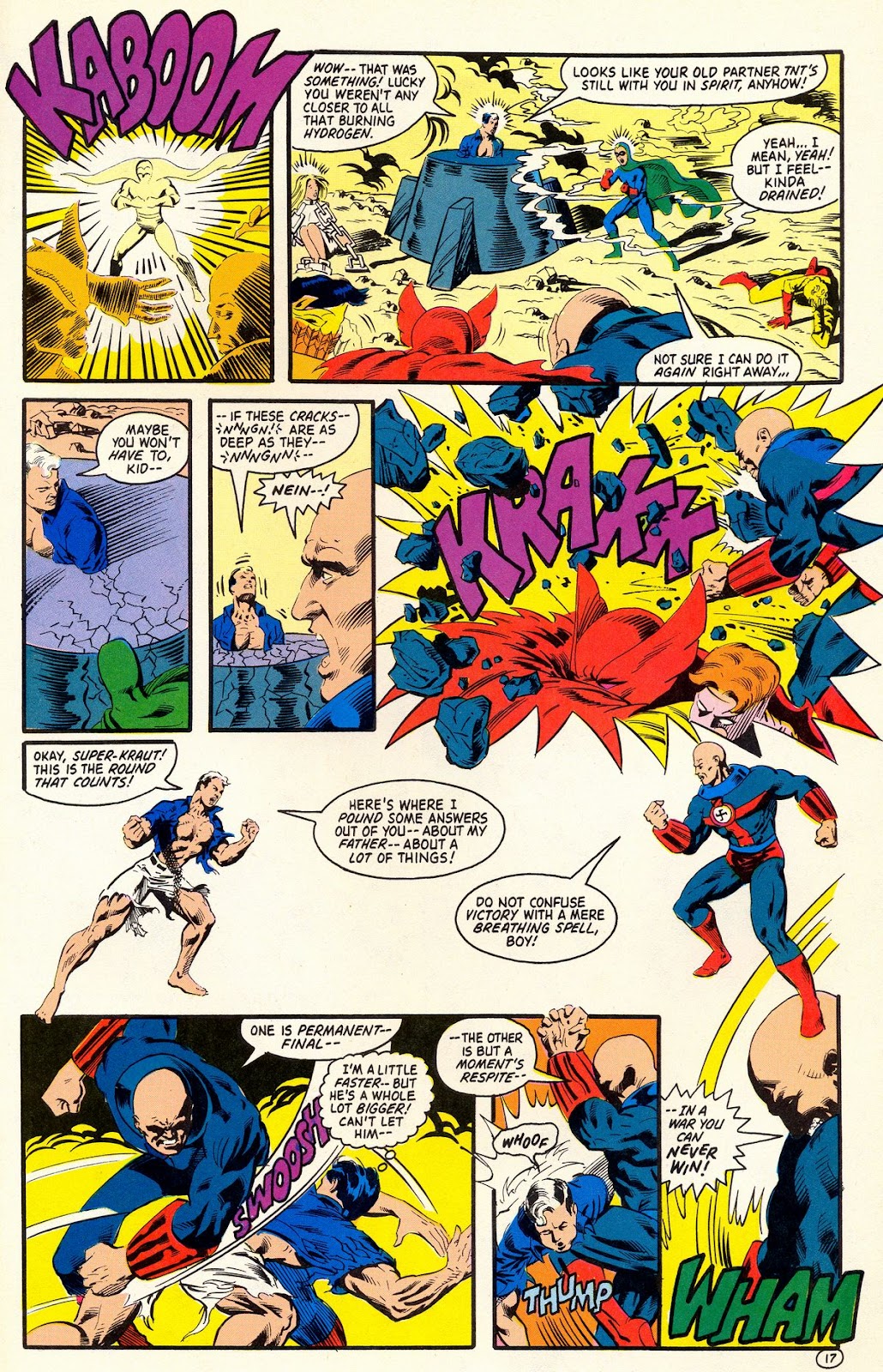 The explosion flattens everybody and weakens the concrete holding Arn, just enough, for him to break loose and attack Ubermensch. Ubbie is bigger, but Arn is faster. Still, Ubby leaps away and Arn has to fogo chasing him to stop Usil (the archer, not Paul Atreides) from firing an arrow through Sandy's head. Fledermaus snares Dan in his Batrope and puts the boot in, until Gudra tells him to go help his pop. She then is about to stick Dan with her spear when Helena transforms again and breaks free of her chains and then further transforms into Tisiphone, the Blood Avenger and taunts her with the Greek civilization vs the Germanic, while swatting her across the sky, to land, unconscious, on her winged horse, who hi-yos away. Tisiphone isn't done yet and seems to be up for killing whoever is handy, including Arn. 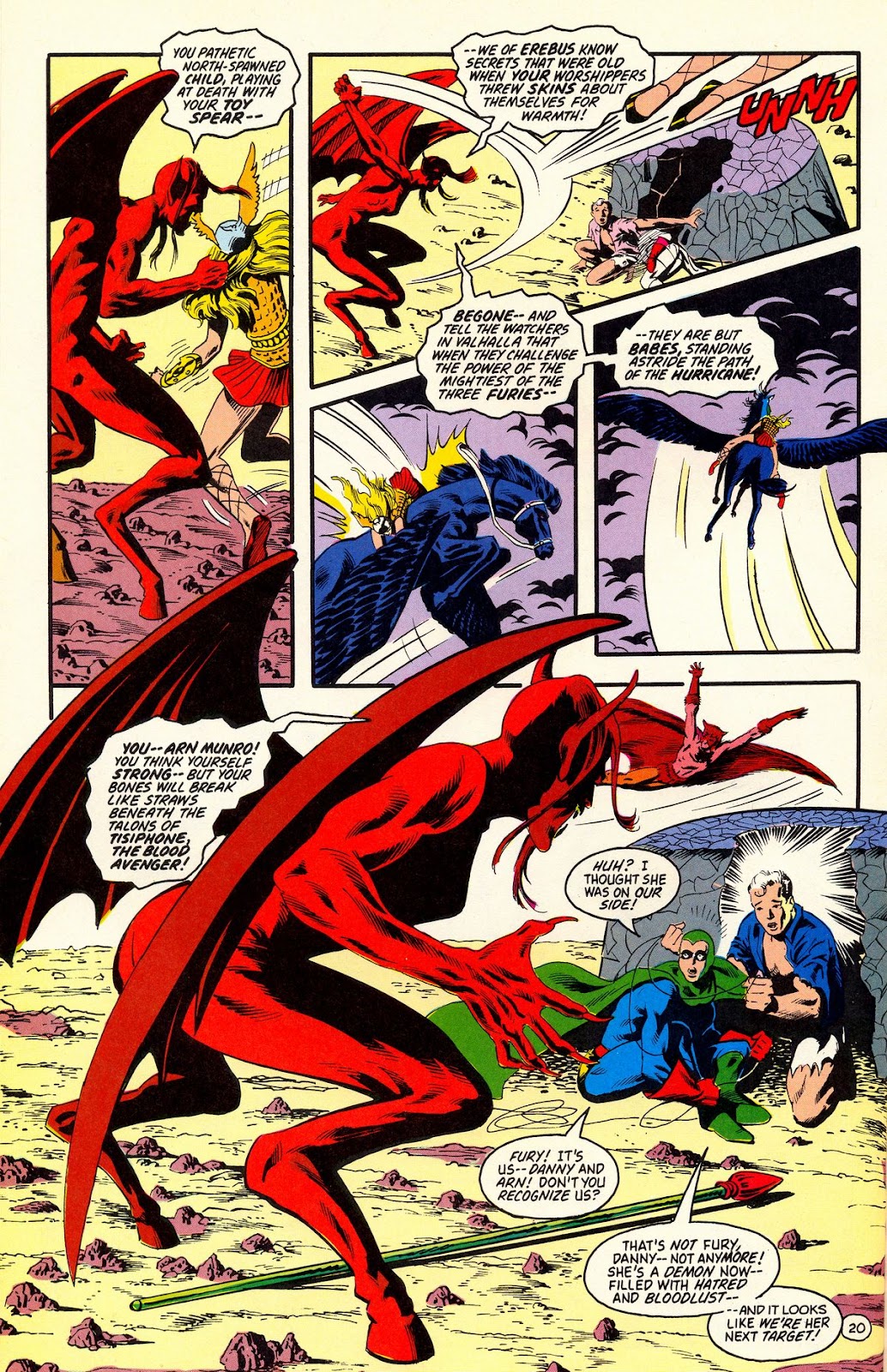 I'm not gonna go for the obvious joke here; she's too damn scary! Fledermaus ambushes Sanday and tries to barbecue his face on some burning wreckage, when Tsunami douses everything with a wave, allowing Sandy to KO him with a kick. Everyone tries to stop Tisiphone; but, it takes Arn, with a sleeper choke and some soothing words to put her down and cause her to revert to Helena. 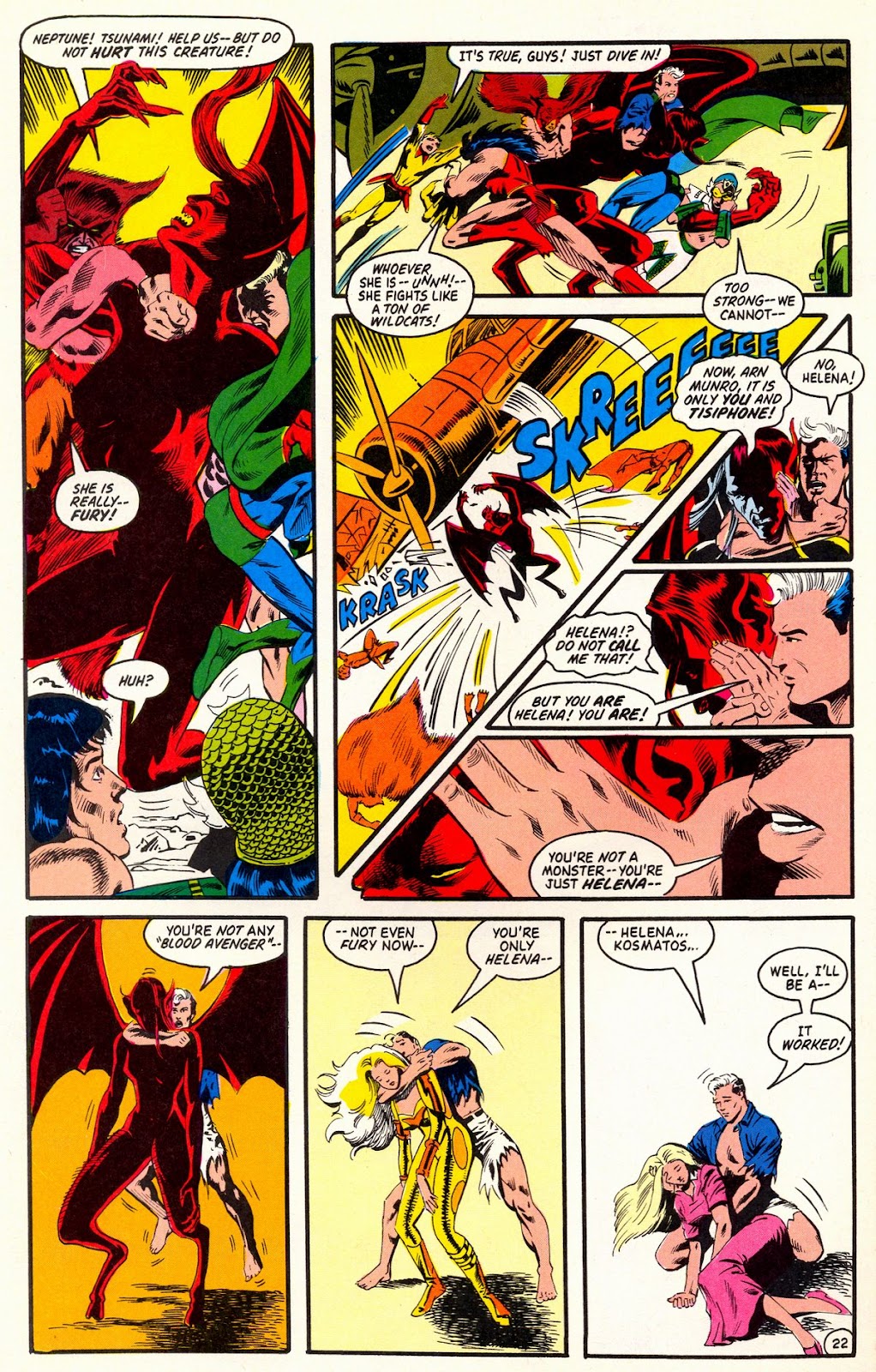 Things quiet down, as they realize what's inside of Helena (Flying Fox explains things, since he seems to have the inside scoop on magical gateways and possessions). Sandy apologizes to Tsunami, after she saved him from being bacon and she hugs him. This is interrupted by Horned Owl (too hard to type Grosshorn Eule, so I'm going with English), who swears vengeance, since his kid was killed by the debris that crushed him, in the fight. He isn't a threat, so they focus on Helena waking up, with no memory of what happened. We cut to New York, where Fiorella LaGuardia introduces the All-Star Squadron and its newest members, to a crowd at a baseball game (not sure if it is the Yankees or the Giants; don't think it's the Dodgers). In the last panel, we see that they are being watched by Tigress, a future member of the Injustice Society (as Huntress, her original name, which gets retconned a bit and Roy came up with Tigress). Thoughts: So, Roy wraps up his debut storyline and it's a pretty good wrap-up to a pretty good debut. Not quite as impactful as the All-Star Squadron debut; but, not bad. Once again, we do see a problem with the sheer number of people involved in production, as there is a jarring shift in the art, from Brian Murray to Howard Simpson. Murray was the more experienced, working in animation, while Simpson was a rookie. Michael Bair handles the tail end, at the ballpark, which looks slicker than some of Simpson's pages. Simpson shows promise; but, he struggles with anatomy and faces, at certain angles and his pages are a bit crowded (might be a problem with Roy's scripts, though I don't know if Roy was working plot (aka Marvel Method)or script method. Some of the layouts are kind of crowded with panels. Murray's show a bit more creativity, at the start, which makes it a bit more visually interesting. Simpson's are more traditional, though not the boring 9-panel grid that Shooter so loved. He has some good angles, in the action, so he shows promise. he just needs to get some more drawing time to refine his work (and probably some guidance, like Todd McFarlane got from Dick Giordano). Simpson has his mechanics wrong when Arn tries to choke out Tisiphone. To execute a proper sleeper choke, the forearm needs to be under the chin and across the throat, while the other hand presses downward on the head, placing more pressure on the throat from behind, as well as in front, cutting off the airway. Looks to me like Howard has only seen the pro wrestling version of things. where the free hand would be across the opponents forehead, rather than at the back of the head, so that the wrestler isn't actually choking his opponent. Given that this is a comic book, that's probably a good thing (imitative acts and all that). The cat is out of the bag, amongst her friends, in regards to Fury being controlled by Tisiphone and the Furies (sounds like a Heavy Metal band); so, the team is likely to be wary of her losing control. Flying Fox provides an outline of things, though there is no way he could now any of what he says with certainty, which is a weakness of some of Roy's work on these things. Just because Fox's powers are magical, in nature does not mean he has an immediate insight into how the Furies work, given they are from another realm (unless Fox's magic is tied to the same realm). It just doesn't feel like earned knowledge. The team has come together (Arn remarks that they are now Helena's family); so, we should see them as a more cohesive unit, going forward (apart from the usual in-fighting you would expect from an ex-Marvelite, like Roy). The big reveal, in all of this, is that Arn Munro is actually the son of Hugo Danner (and grandson of scientist Abednego Danner). That explains his abilities (explanation in the Historical Notes); but, the question is what is Ubermensch's connection? He says they are like brothers, which suggests Hugo had some part in Ubermensch's birth, either biologically or metaphorically. That mystery will probably be at the heart of Arn's story, as the series progresses. Axis Amerika is a bit of a mixed bag, in my book. Obviously, Roy made them stand-ins for the Justice League: Ubermensch is superman, Gudra is Wonder Woman, Horned Owl and Fledermaus are Batman & Robin, Sea Wolf is Aquaman, Usil is Green Arrow, Kamikaze is probably less direct, since he is mostly there to contrast Tsunami. Horned Owl and Fledermaus are pretty one-dimensional (evil nazi Batman and Robin) and Fledermaus is now dead. Usil is even more one-note and stereotyped. Seems like he is just there to be the token Italian (guess there were no Hungarians or Romanians in Axis Amerika, or right wing Dutch, French, Norwegian or Ukrainian). Ubermensch is tied to Arn; so there is that mystery. Gudra is tied to Teutonic Gods, which gives her a certain dimension. Sea Wolf's werewolf status has possibilities, though the name is a bit dumb. i assume Roy was trying to invoke the U-Boat wolfpacks; but, wolves aren't aquatic creatures. Besides, who would want to work with a guy who always smells like a wet dog? Even Nazis. So, storywise, the series has some stuff going for it, apart from continuing All-Star Squadron. Even though part of the impetus , for Roy, is to replace Superman, Batman, Wonder Woman and Aquaman in the Golden Age, he is more focused on creating new characters, with hints of the old, then grafting the old onto some new mannequin. I wish he had been more focused on the same in Infinity, Inc, as he seemed to go off on tangents to link to Golden Age stories far too often. The letters page on the inside back cover ends with a banner that says "Millennium is Coming." I liken it to a warning, that, in hindisght, should have said, ?Millennium is Coming. Run!" Historical Notes: Unless anyone has any great desire for me to continue the monthly recaps of the Post-war era, I will dispense with them and stick to historical specifics within the issue. First up, "Iron" Monroe. It is revealed in the letters page that Roy's inspiration for the name came from two sources. the first was a story in Astounding magazine, "The Mightiest Machine," by Joseph W Campbell (editor of the magazine and a writer in his own right), which featured a character named Aarn Munro (with two As). Roy had been reading a book about the history of Astounding and came across a reference to the story, though he had not read it. He liked the sound of the name. he then came across a mention of a minor 1940s comic character, Iron Munro, who was a Flash Gordon type adventurer, in the future (as a letter writer brings up), though Roy doesn't know much about him and Jerry Bails' Collector's Guide: the First Heroic Age has no mention of him. He asks readers for more info, in a rare turn of events. In the story, Ubermensch opines, and Arn confirms, that Iron Munro is the son of Hugo Danner. If the name isn't familiar, then you have probably never read Philip Wylie's novel, Gladiator, which inspired the birth of Superman (among other influences). The novel was written in 1930 and tells the story of Abednego Danner, a professor who lives in Colorado. He is obsessed with eugenics and develops a serum which boosts potential in animals (he injects a tadpole, then a cat, whose kittens show amazing strength). He injects it into his wife, while she is pregnant, in hopes of boosting his unborn child's potential. Their son, Hugo is born, with incredible strength. His mother teaches him to hide it, lest there be witch-hunts and he doesn't fight back against bullies, only taking refuge, in secret, in the woods, unleashing his strength. He later becomes a football star and strongman, though he accidentally kills a player, in a football game. He Joins the Foreign Legion and fights in WW1, where h proves impervious to bullets. He returns to the US and gets a job at a bank, where he has to use his strength to free someone trapped in the vault, but his boss eyes him with suspicion, rather than gratitude. He later joins an expedition to Latin America, where he cries out for a purpose and is struck down by lightning. The novel is quite intriguing and has a depth missing from the simpler Superman tales of Siegel and Shuster, though it feels like Wylie got stuck with the ending and settled for a literal Deus ex machina as God strikes Hugo down. Roy had partially adapted the tale in the pages of Marvel Preview magazine, in two parts, but was never able to finish it. Hugo was strong and bulletproff, able to leap great distances; but, not invulnerable. Much of his abilities and plight informed Superman, as did Wylie's When Worlds Collide, with a story of a rocketship ark to take survivors away from a doomed planet. Added to that was Edgar Rice Burroughs John Carter, who could leap great distances on Mars (Barsoom) and was physically stronger; and, Lester Dent's Doc Savage, the hero of the pulp novels. Savage was a physical and mental marvel, known as th Man of Bronze, who had a secret fortress of Solitude. Superman was called the Man of Steel and would, eventually, gain a Fortress of Solitude, in the Arctic (though, initially, it was closer to Metropolis, when first introduced). So, Arn Munro is the son of the first "superman" and his abilities parallel his father's (and the initial Superman stories). Santa Catalina Island is one of the Channel Islands, off to coast of southern California, with the island located in close proximity to Los Angeles (and is part of Los Angeles County). The island had been inhabited by natives, who mined some of the mineral wealth to trade on the mainland, especially a variety of soapstone. The Spanish conquest brought disease and the population is believed to have died out from disease. Some minor ranches had been built there and some herds of sheep were grazed there, but no major settlements, until the later 1800s. George Shatto, a real estate speculator, tried to build a resort community there, at Avalon Bay. By 1887, he had opened it to the public, complete with steamship ferry to the island. However, he soon defaulted on loans. Some of the Banning family, sons of entrepreneur Phinneas Banning, bought the land and continued development of Avalon and even expanded beyond to further develop the rest of the island. A fire in 1915 burned much of the building at Avalon and the War cut deeply into the tourist trade. The Bannings were forced to sell shares in the island to raise capital and the bulk of them were bought out, by 1919, by William Wrigley Jr (as in the gum). He put extensive capital into building up and promoting Catalina, as a tourist destination, eventually building the Catalina Casino (after initially building the Sugarloaf Casino), which became a landmark (and is seen in this issue)...  To promote tourism, Wrigley funded stunts and extravaganzas to draw tourist interests, including bringing his baseball team, the Chicago Cubs, to the island for spring training, beginning in 1921 (and continued to do so, until 1951, apart from the war years). Following the attack on Pearl Harbor, the resort was shut down and the island was taken over by the military for use as a training facility. The island's steamships were repurposed for troop transport and groups from the Army signal Corps, the US Maritime Service, the US Coast Guard and the OSS had training facilities and installations there (including a radar station). Thus, the presence of Axis Amerika should have raised alamrs on the island, though we are still in early days of its military use. We must assume that Axis Amerika landed there in secrecy. The area where Axis America is hiding had been two hilltops, which Wrigley had levelled and the canyon between filled in, to create a runway, for an airport development, in 1941. The airport would not be opened until 1946. You'd think that it would have been in use as an airstrip for the military, but Roy mentions obstacles being put there, to prevent landings by an enemy. That suggests (and Roy seemed to research these things pretty well, in general) that the airstrip was not functional, at this point. Fledermaus mentions that the Nuremburg is filled with hydrogen, because the US wouldn't sell Germany helium, from Texas. Well, certainly in 1942, when we were at war; but, Roy is referring to 1937. Airships were inflated in one of two manners: either with heated air, as in hot-air balloons) or via lifting gases, such as hydrogen or helium. Hydrogen is far more plentiful than helium and was the most common gas for airships and was used by both sides in WW1, for their dirigible airships, as well as barrage balloons and observations balloons. In 1922, the US Navy commissioned its first dirigible, the USS Shenandoah, the first airship to be solely lifted via helium. At the time of construction, its envelope contained most of the world's known helium. When the second dirigible, the USS Los Angeles was first commissioned, it's helium came, in part, from the Shenandoah. Helium is non-flammable, which gave it an advantage over hydrogen airships, especially in a military environment. the trade-off is that hydrogen has greater lifting capacity and less is required. Thus, helium airships required greater levels of the gas to lift the same mass as a hydrogen gas cell. The US Nay would build two further dirigibles, the USS Akron and the USS Macon. the Shenandoah was destroyed in an accident, while carrying out a cross-country tour of the US, when it encountered high updrafts, related to storms, in Ohio. The ship broke apart and the control car crashed and killed the crew inside. others were is sections of the airship and survived riding the pieces to the ground, including seven men in the bow, when CDR Charles Rosendahl was able to pilot it like a free balloon, to safety. The USS Akron went down in a storm, at sea, with only 3 survivors, because it had no life rafts or flotation vests, to save weight. The USS Macon went down, at sea, due to structural damage, but most survived, since it carried lifesaving equipment, after the Akron disaster. The Los Angeles survived, but was decommissioned and later scrapped for the aluminum in its structure. The Los Angeles could carry 3 aircraft, after it was modified with a hangar and the Akron and Macon had been built with an internal hanger to carry 5 Sparrowhak fighter planes (biplanes), which could be lowered on a trapeze structure to launch and would then hook onto it to land. When the Hindenburg made its journey to the Us Naval Station, at Lakehurst, NJ, one of the passengers was Captain Ernst Lehman, an executive and senior pilot of the Zeppelin Company. He was sent as n observer and had hoped to carry out discussion with the US government to obtain helium, for future voyages. The Graf Zeppelin and the Hindenburg had elaborate precautions to prevent sparks from igniting the hydrogen. The vessel even had a smoking room, with an airlock, which allowed passengers to smoke, safely (from a combustion standpoint, not a biological one) inside. They had galleys with electric ovens, to cook the food, for the voyage. However, they knew of the dangers of hydrogen, from downed airships during WW1 and from the crash of the British passenger airship R101, which crashed over France, killing 46 of the 54 passengers and crew, on October 4, 1930. The US considered helium to be a strategic asset, because of its use by the US Navy airship program. The supplies of helium were actually a byproduct of natural gas drilling, in Texas and the US controlled most of the world's supply. As such, the government was loathe to sell it to other nations, including Germany, to which it had become increasingly antagonistic, as Hitler's political actions and demands escalated. On May 6, 1937, after delays due to weather, the Hindeburg was maneuvering to making its landing (mooring, actually, with a mast, after which it would lower its internal gangways), an explosion occurred, due to an unknown cause. A fire soon engulfed the ship and it came crashing to the ground, its lifting gases consumed or released.  Out of a compliment of 97 passengers and crew, 36 were killed (less than the R101, numerically and proportionally). Ernst Lehman survived, with burns over much of his body, but he died soon after, in hospital. No definitive cause for the explosion was ever determined, though the official report listed static discharge as the the likely cause, igniting the hydrogen. Subsequent research tends to dispute this hypothesis and other theories have emegerd, including lightning strike and an engine failure, as well as combustion of the coated skin being the source of the intensity of the fire. However, each theory has faced as many criticisms of the explanation as answers to standing questions. The crash was seared into observers via the delayed-live radio broadcast of WLS Chicago report Herbert Morrison. This British Pathe newsreels includes footage of the ship over New York (headed for Lakehurst) and the landing approach, though the narration is filled with technical inaccuracies and promotes the tragic drama of the crash, rather than the actual facts, making it sound like most perished, rather than approx 2/3 survived, leading to the cultural falsehood that most, if not all perished. The main difference is the crash was caught on film and with the radio broadcast, while the R101 crashed without large numbers of witnesses. In the issue, Sandy deliberately crashes the All-Star plane into the Nurmeburg, igniting the hydrogen and destroying the airship. In all likelihood, an explosion might not have occurred from that, as much as the destruction of the gas cells and a collapse of the envelope (as well as structural damage). As it is, the Nuremburg is drawn with proportions that were more in keeping with a blimp, rather than a dirigible. As you can see in the video, the Hindenburg was quite long and tubular, with a length of over 800 ft (equal to nearly 2 1/4 football fields, laid end-to-end). The design actually reminds me of the ship of the supervillain, the Blimp, in an episode of Dynomutt....
|
|
|
|
Post by codystarbuck on May 13, 2021 18:46:10 GMT -5
ps Obviously, I forgot to mention the other popular theory, in regards the Hindenburg and the basis for the 1970s disaster movie: sabotage. No definitive proof of any sabotage has ever been uncovered nor any evidence of any group working to sabotage the vessel for any reason, political or otherwise. The 1970s movie was largely inspired by a rather bad book that pushed this theory and massaged a lot of facts and coincidences to support it, while ignoring anything and everything that refuted the idea. A&E/History Channel had a great documentary about the crash and basic airship history, back in the 90s, which poo-pooed such talk, though that was the belief of Lehman, on his deathbed and some others, particularly as natural sources of spark didn't stand up to laboratory tests. There is also an excellent coffee table reference book, the Hindenburg: An Illustrated History, by Ken Marschall and Rick Archbold. We first got it when it was published, in 1994, at B&N and I bought it when we got remaindered copies (at less than half the price of the original release). It includes an extensive history of airships and airship disasters and detailed cutaway drawings of the Hindenburg's interior sections. It also included a picture of the USS Los Angeles that demonstrated some the non-combustible issues with airships...  That's the USS Los Angeles, at its mooring mast, on August 25, 1927, at Lakehurst. A sudden gust of wind elevated the stern into colder, denser air and it kept on rising, until it reached an apex of 85 degrees. It safely righted itself and was relatively undamaged, flying the next day. The crew tried to counter the rising of the stern section, by climbing the keel, to add weight; but, could not move quickly enough to counter it before it hit the 85 degree elevation. When the Hindenburg crashed, many jumped to safety, aided by the Navy ground crew, below. others survived the crash of the ship to the ground. The actual timeframe of the crashing was relatively short and the hydrogen burned away quickly, leaving openings for people to escape. One of the passengers, Joe Spah, a circus acrobat, actually escaped by smashing a window and clinging to the framework until the ship was low enough to jump, receiving only a broken ankle. the movie depicts him jumping onto a mooring line and swinging down; but the lines would have been much further forward. In the A&E documentary, there were a few Navy airship veterans who were there that day and one described a chief petty officer, in the ground crew, who halted the men fleeing from the area and redirected them in rescue efforts, yelling "Navy men stand fast!" His efforts did much to help save passengers and crew of the ship. |
|
|
|
Post by codystarbuck on May 18, 2021 17:07:00 GMT -5
Young All-Stars #7 You know, someone needs to do 3D animation of these "running at you" covers and show the various teams colliding with each other. Creative Team: Roy & Dann Thomas-writers/pitcher & catcher, Howard Bender-pencils/left field, Malcolm Jones II-inks/center field, Bob Downs-ink assist/short stop, Jean Simek-letters/1st base, Juliana ferriter-colors/2nd base, Alan Waite-baseball advisor/batting coach Roy needing a baseball advisor suggests why we haven't seen a lot of sports-themed comics from the Bronze Age onward. Outdoors? In the sun? It'll bleach my comics! Synopsis: May 1942 (Finally!), in the Bronx, at someplace called Yankee Stadium, the All-Star Game is about to begin. The price of admission is a piece of scrap metal, as this All-Star Game is a scrap metal drive benefit, for the war effort. This is not the National League vs the American League, either; it's the Young All-Stars vs the adult All-Star Squadron! 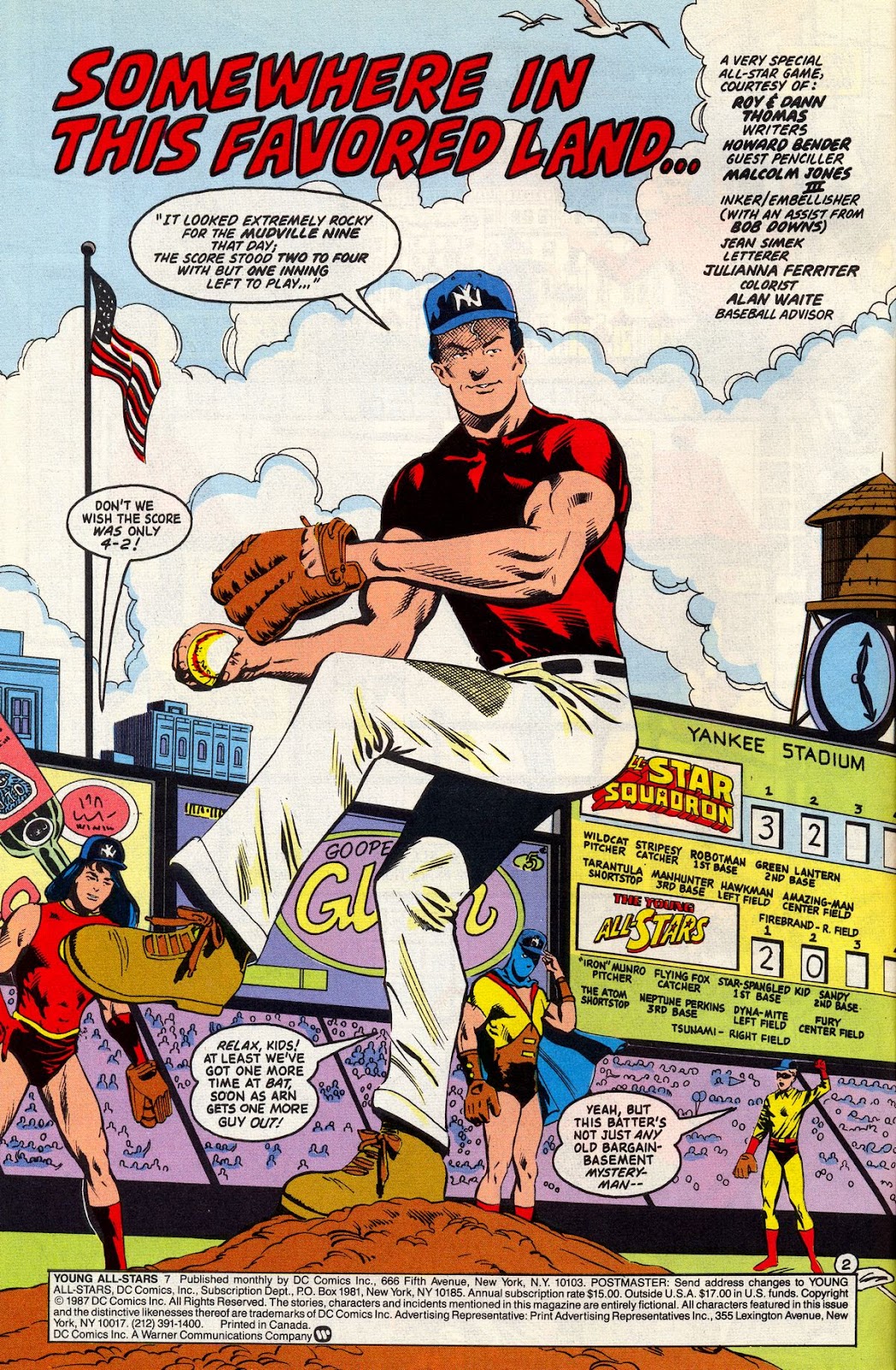 The Young All-Stars are in the field, with Iron Munro pitching. Star-Spangled Kid and Atom are playing with the Young All-Stars, to even the numbers. It's the top of the 3rd inning, with the adults still at bat and leading, 5-2. Arn is busy citing Ernest Lawrence Thayler, when he should be concentrating on strike outs! (Roy gets the opening stanza of the poem a bit wrong). Robotman is at bat and he hits one to Right Field and it looks like he is gonna get a double or a triple. Tsunami is playing Right Field and is under it, but stationary. Fury doesn't think she has it and does a Kelly Lee and the pair collide and go down, without the ball... 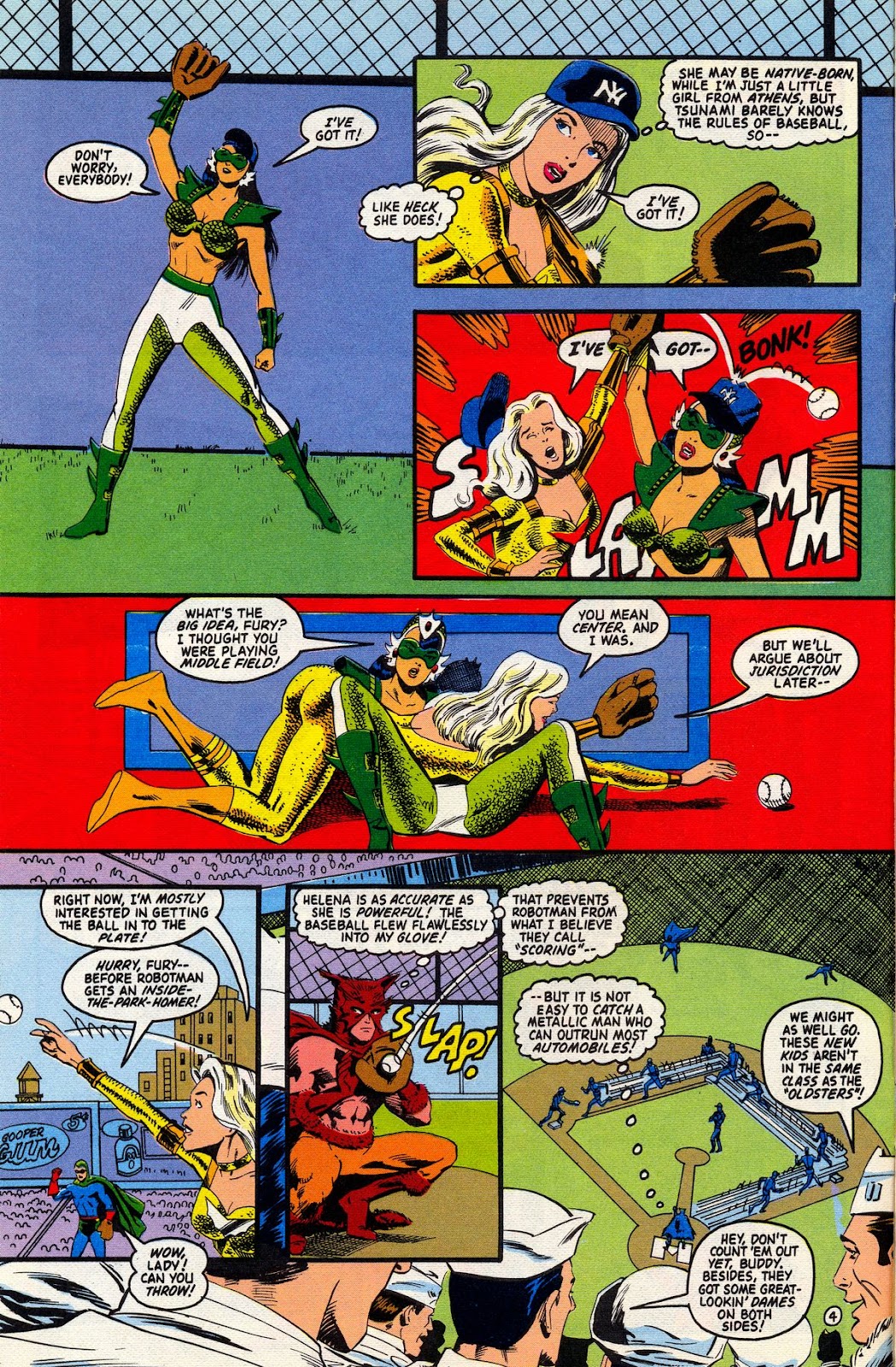 Fury grabs the ball and hurls it to home plate, where Flying Fix, the catcher, gets if and Robotman is stopped at Third. Green Lantern is up, complete with Magic Ring Bat and Arn throws a screwball and Lantern hits air, but Fox drops the ball and Robotman tags up and heads for home. Fox disappears from view and Arn heads to cover home plate, but no one has the ball. Robotman is tagged out by the reapeparing and levitating Flying Fox, who turned himself and the ball invisible. The heroes exchange places and the Young All-Stars are at bat. Wildcat does a bit of trash talking and the game takes a pause to welcome the special guest, Geroge Herman Ruth, inventor of a candy bar, or something.... 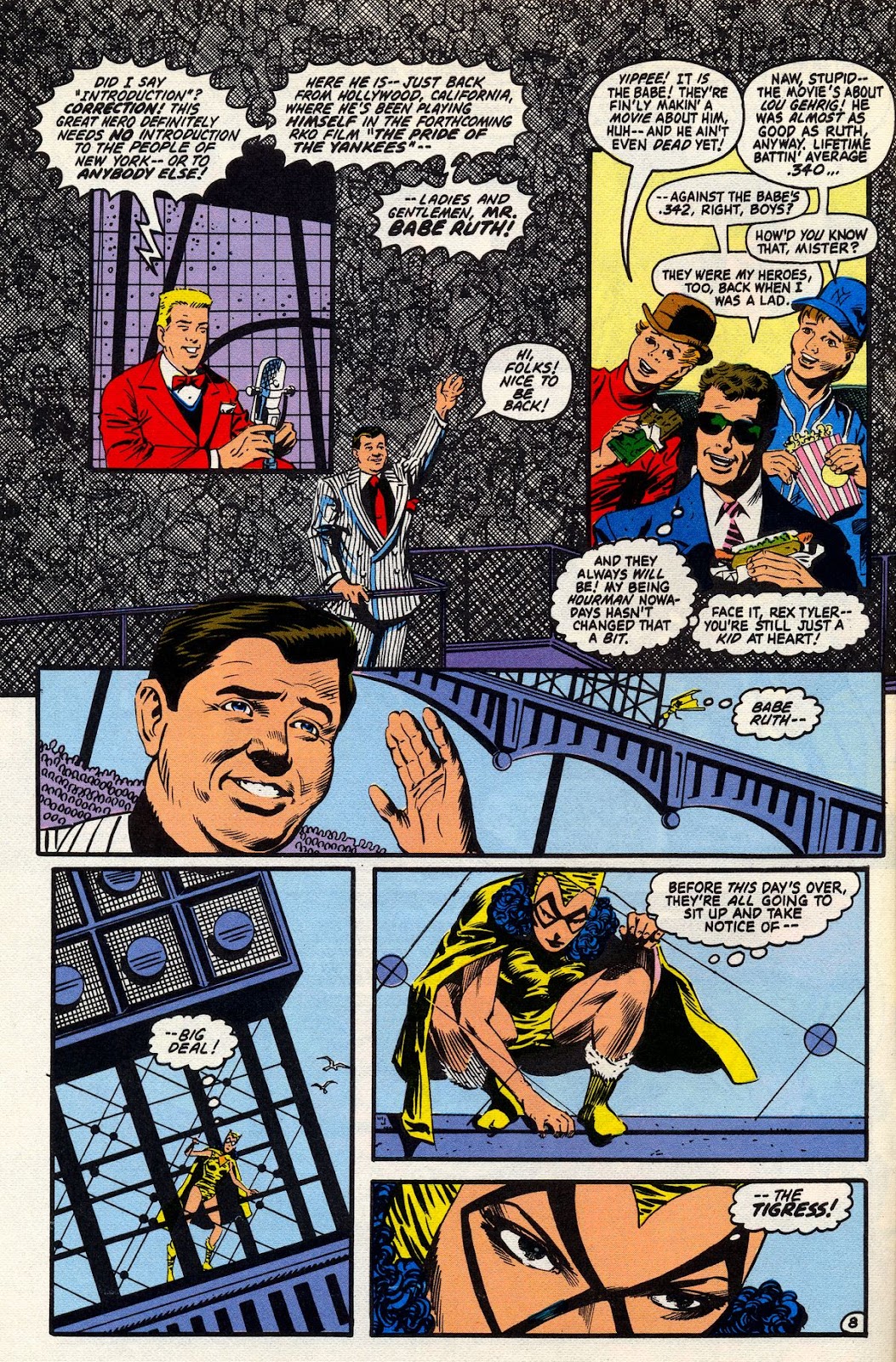 What's that?........"Babe" Ruth?....oh, he's some kind of baseball player? Hunh.....So the candy bar...... What's that?........"Babe" Ruth?....oh, he's some kind of baseball player? Hunh.....So the candy bar......Watching from the cheap seats (the really cheap seats, up in the scaffolding for the field lights) is Tigress, who swiped her costume from Linda Stirling, except that film was 2 years later and Stirling wears a leopard print; so, forget all of that. She has a striped bathing suit and matching cap; just leave it at that. Arn gives the team a pep talk, as they need 3 runs to tie, 4 to win. Sandy is up first and hits a line drive to second and Green Lantern is distracted. Luckily, Amazing Man absorbs the elasticity of his Bazooka Bubble Gum (elastic? That stuff is hard as a rock!) and stretches up to make the catch. Tsunami is up next and she strikes out, swinging like a turnstyle! Flying Fox, who has never played baseball (bet he's played hockey though, eh?), is next and he hits it down past first, where Robotman dives for it; but, Fox is safe, at First, before Robotman can get there. Atom is up next and Wildcat is cocky, but Lantern is still distracted and he leaves the game! 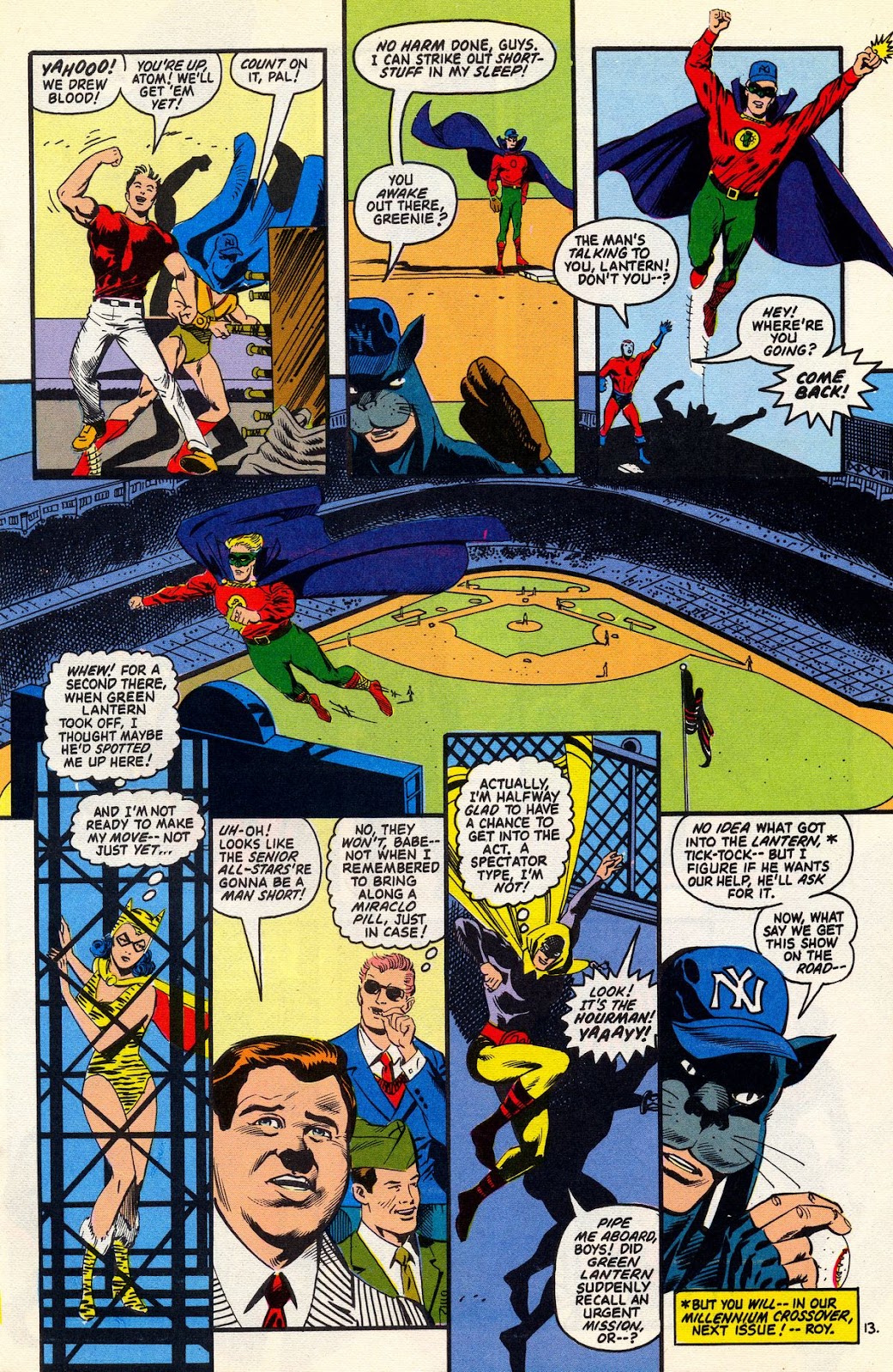 His team is stunned, and a man short! Hourman hops down from the stands to substitute. Wildcat pitches, but Atom isn't biting and walks on Ball Four. Fury is up next and wildcat thinks he has the game, as Fury had never seen baseball, let alone played. Wildcat throws and Fury hits it to Third and it takes a weird bounce and is missed by Manhunter and Tarantula. Hawkman gets it and throws to Stripesy, at home and the bases are loaded, with Arn up to bat. Arn has a chance to win the game, if he can hit a home run. Wildcat checks the runners at 1st and 3rd, gets the sign from Stripesy and throws one across the plate. Swing and a miss for Arn. Wildcat goes into his windup again and sends a sizzler across the plate and the ump calls Strike 2. Arn starts to argue but the ump gives him a warning. Arn turns his attention back to Wildcat. The count is 0 and 2 and Arn chokes up on the bat. Here's the windup......a fastball dead center...... 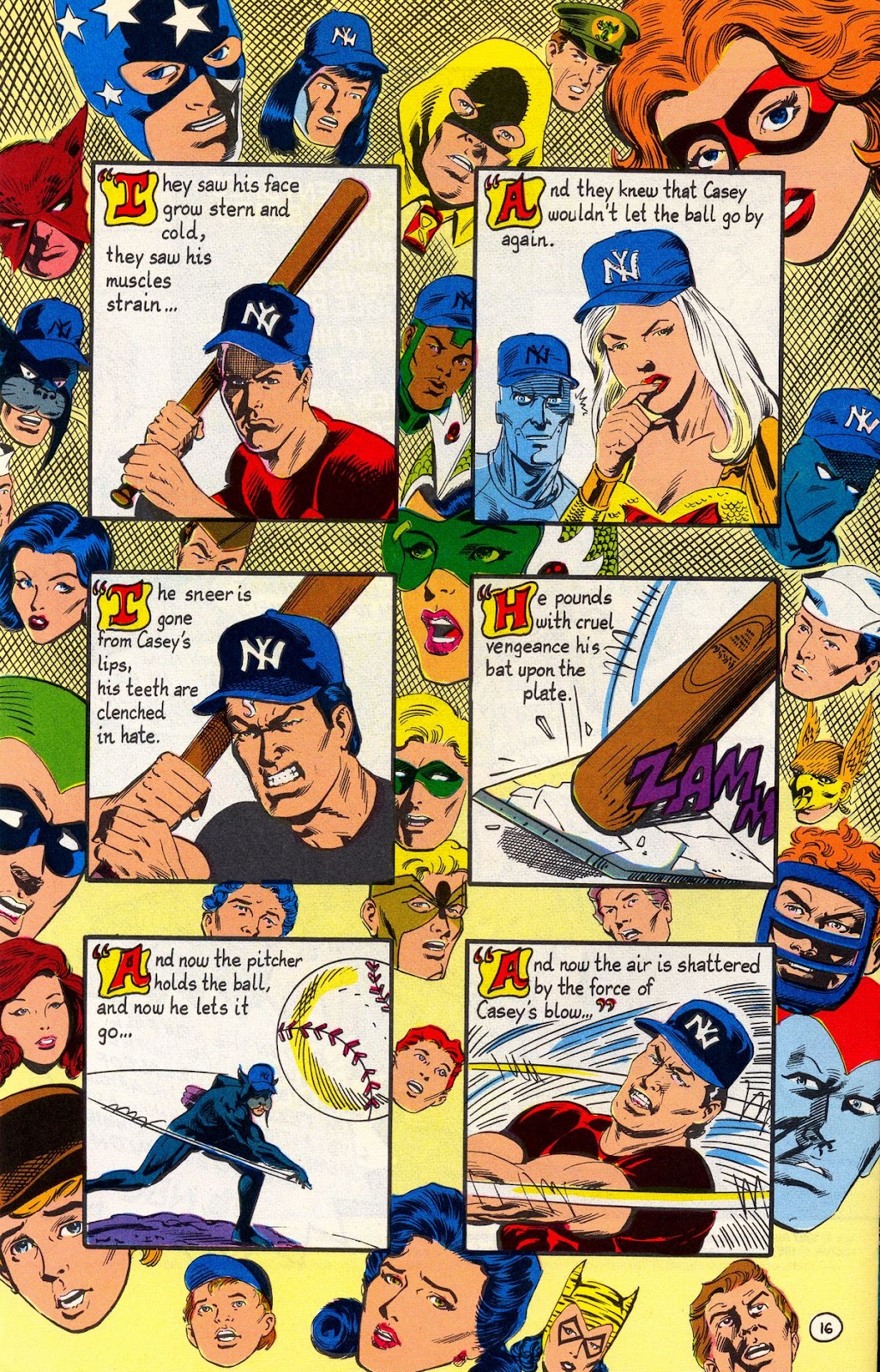 He hits a screamer that burns its way through the sky. Hawkman and Firebrand go after it as Arn rounds the bases, forcing Fury and Atom along, and then Flying Fox. They all cross home plate and the ump calls the game for the Young All-Stars, until Hawkman lodges a protest.... 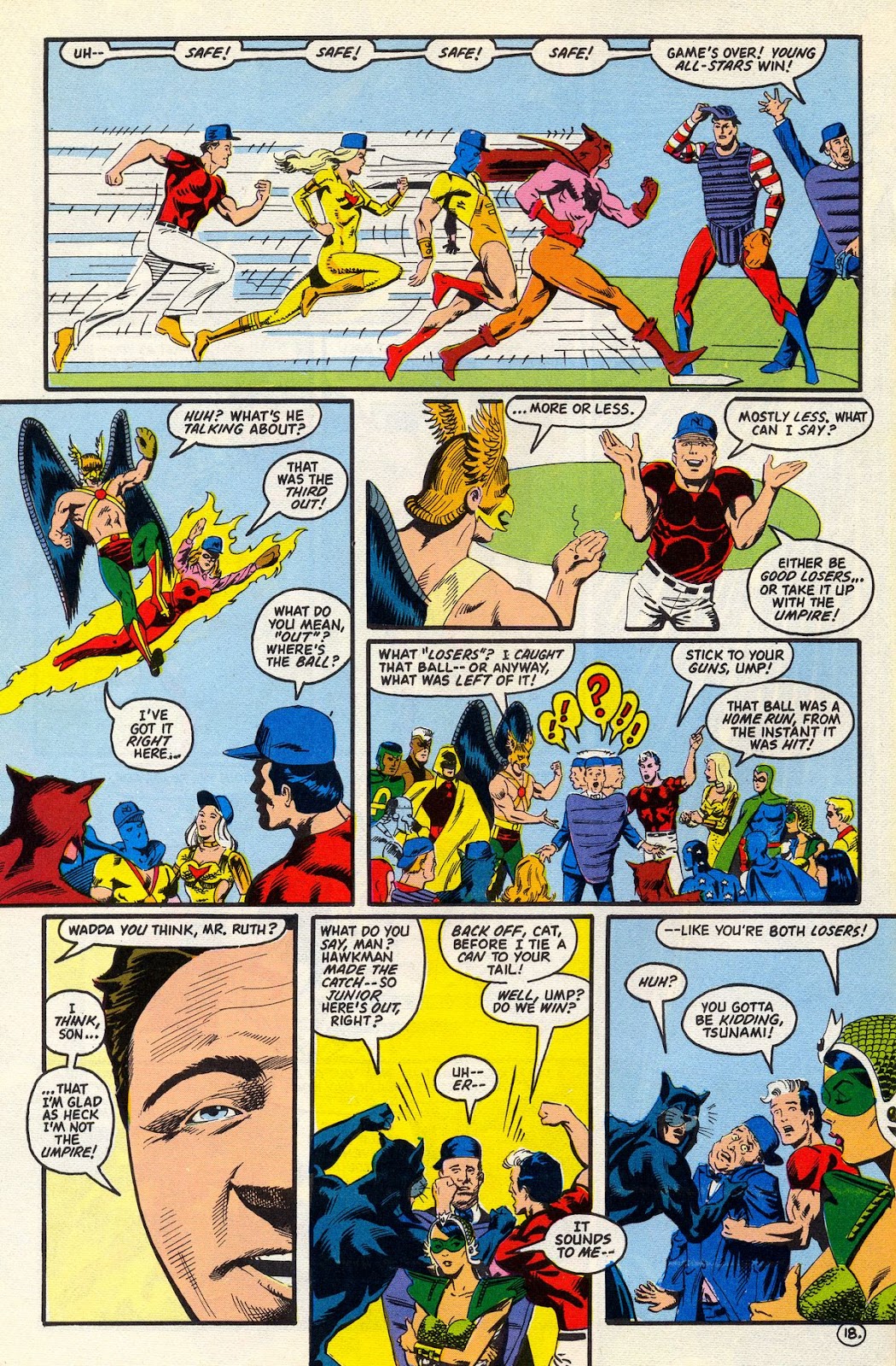 He caught what remained of the ball (a small bit of the core) and the arguments fly, with Wildcat and Arn badgering the ump, until Tsunami reminds them it is a benefit game, so who cares who wins? The rest of them grow up and concede a tie game and go off to celebrate, while the Young All-Stars, minus Sandy (who goes to visit Wesley Dodd in the hospital) stay to see the Yankees play. In the bottom of the 4th, an announcement goes out, asking any All-Star Squadron members still in the park to come to the manager's office. the gang heads up there and an Army officer is deflated to see that none of the adults are there. he makes do and tells the youngsters that a "pocket U-boat" is attacking a British merchant vessel, off the coast and asks them for help. They pile into a Navy staff car and head off to save the ship. Meanwhile, some cops spot Tigress lurking around and challenge her, then get their butts kicked! 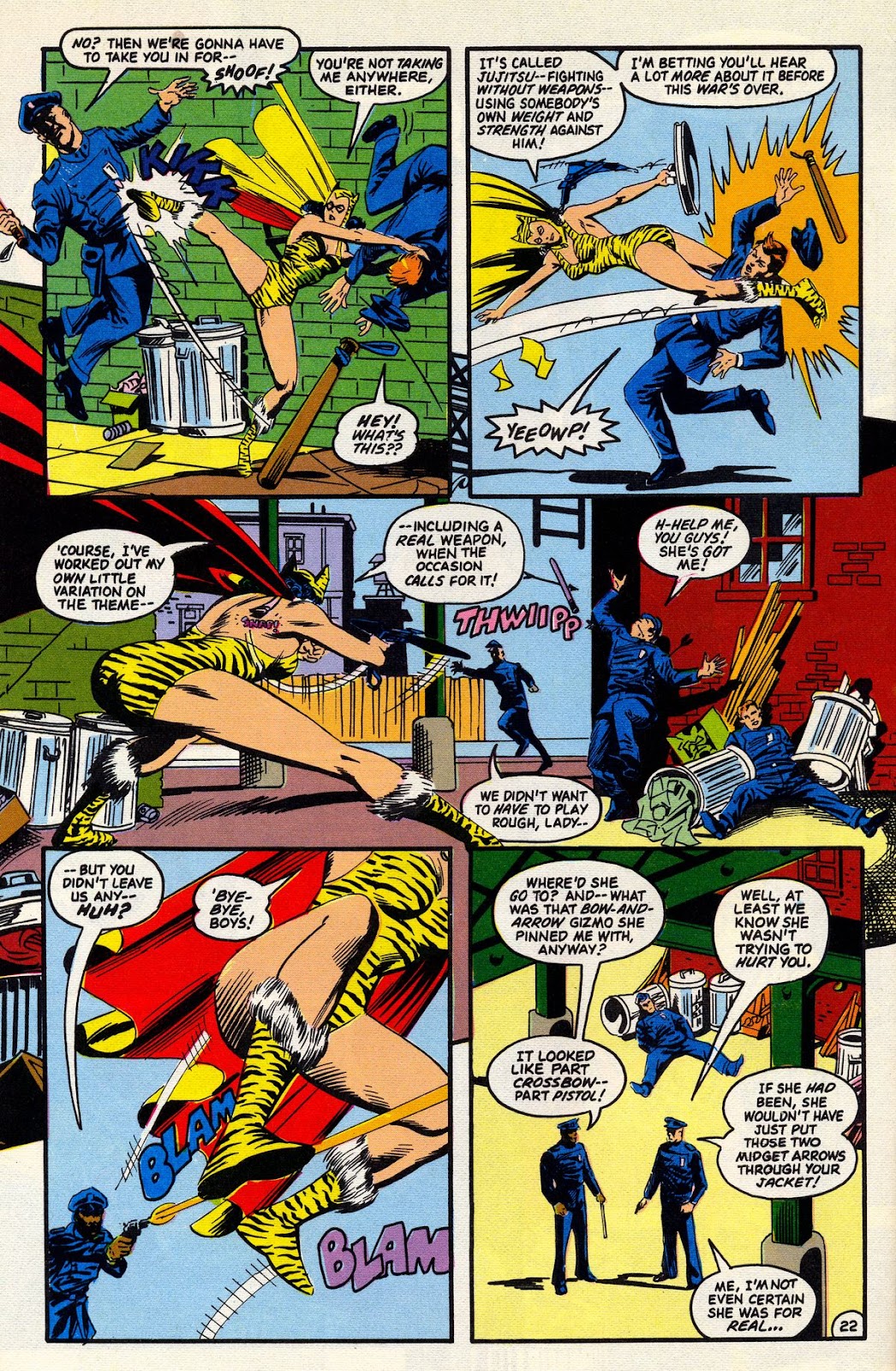 She runs off and hides, again, then the military guys wait for word from the Young All-Stars. They soon turn up, with a contribution for the scrap drive... 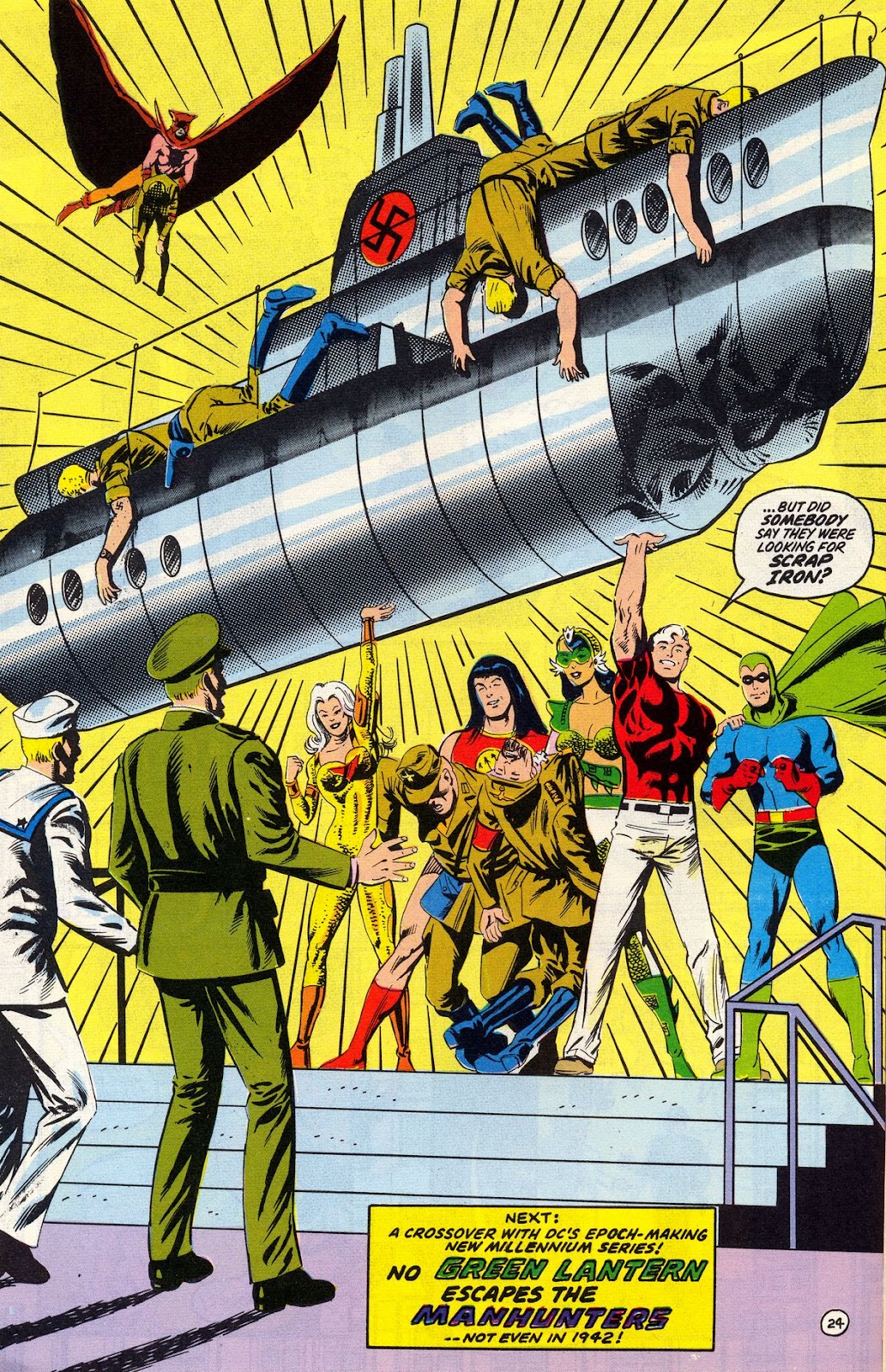 We are also warned that Millennium is going to disrupt next month's issue and we prepare ourselves for the worst! Thoughts: Fun little issue that acts as a palate cleanser, after the opening epic. X-Men playing baseball had lead to a rash of superheroes at bat, so Roy indulges, mixing in a little "Casey at the Bat." He also throws in Babe Ruth and name drops his appearance in RKO's Pride of the Yankees, with Gary Cooper, as Lou Gehrig. One of the two kids seen entering the park, at the start (after showing their metal) is wearing a bowler hat and might be intended as Brooklyn, of the Boy Commandos, though if it is, I doubt he would cheer the Yankees. We don't learn what tigress is up to, though I'm sure it will factor into the next issue. She talks about using jujitsu, but I don't recall a flying head scissor being part of the curriculum. I think she has been watching Mildred Burke (Women's world wrestling champion, in the 30s and 40s), instead of training in judo. 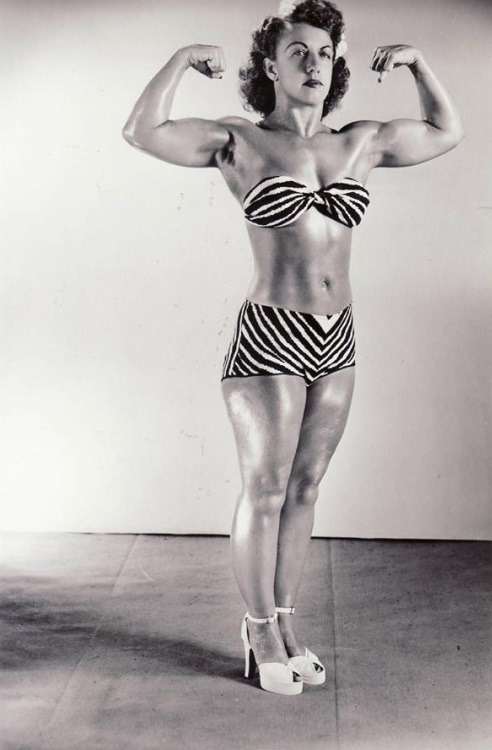 Historical Notes: Historical Notes: "Casey at the Bat" was written by Ernest Lawrence Thayer and was published in 1888, in the San Francisco Daily Examiner. The poem was an instant hint and was made famous further by vaudeville performer DeWolf Hopper. The New York Sporting Times reprinted the poem, a month later, as "Kelly at the Bat, substituting the name Kelly for Casey, and switching the locale from Mudville to Boston. My favorite version is Disney's 1946 animated short, with Jerry Colonna narrating.... Disney followed up with a sequel, Casey Bats Again, in 1954.... Pride of the Yankees was released on July 14, 1942, with Gary Cooper as Lou Gehrig, Teresa wright as wife Eleanor, and Walter Brennan as Sam Blake. Babe Ruth, Bob Meusel, Mark Koenig and Bill Dickey, all teammates of Gehrig, played themselves. The movie recounts the career of Gehrig, up to his retirement, after his diagnosis with amyotrophic lateral sclerosis (ALS), forever to be known as "Lou Gehrig's Disease." The film is noted for its honest and sincere portrayals and inspiring story, with Gehrig promising a sick boy to hit 2 homes runs in a single game, in the World series. The end of the film features the legendary scene of Gehrig's speech, upon his retirement....
|
|
|
|
Post by codystarbuck on May 18, 2021 17:21:25 GMT -5
ps The opening stanza goes:
The outlook wasn't brilliant for the Mudville nine that day;
the score stood four to two, with but one inning more to play.
And then when Cooney died at first, and Barrows did the same,
a sickly silence fell upon the patrons of the game.
A straggling few got up to go in deep despair. The rest
clung to that hope which springs eternal in the human breast;
they thought, if only Casey could get but a whack at that –
they'd put up even money, now, with Casey at the bat.
But Flynn preceded Casey, as did also Jimmy Blake,
and the former was a lulu and the latter was a cake,
so upon that stricken multitude grim melancholy sat,
for there seemed but little chance of Casey's getting to the bat.
But Flynn let drive a single, to the wonderment of all,
and Blake, the much despised, tore the cover off the ball;
and when the dust had lifted, and the men saw what had occurred,
there was Jimmy safe at second and Flynn a-hugging third.
Then from five thousand throats and more there rose a lusty yell;
it rumbled through the valley, it rattled in the dell;
it knocked upon the mountain and recoiled upon the flat,
for Casey, mighty Casey, was advancing to the bat.
There was ease in Casey's manner as he stepped into his place;
there was pride in Casey's bearing and a smile on Casey's face.
And when, responding to the cheers, he lightly doffed his hat,
no stranger in the crowd could doubt 'twas Casey at the bat.
Ten thousand eyes were on him as he rubbed his hands with dirt;
five thousand tongues applauded when he wiped them on his shirt.
Then while the writhing pitcher ground the ball into his hip,
defiance gleamed in Casey's eye, a sneer curled Casey's lip.
And now the leather-covered sphere came hurtling through the air,
and Casey stood a-watching it in haughty grandeur there.
Close by the sturdy batsman the ball unheeded sped—
"That ain't my style," said Casey. "Strike one," the umpire said.
From the benches, black with people, there went up a muffled roar,
like the beating of the storm-waves on a stern and distant shore.
"Kill him! Kill the umpire!" shouted someone on the stand;
and it's likely they'd have killed him had not Casey raised his hand.
With a smile of Christian charity great Casey's visage shone;
he stilled the rising tumult; he bade the game go on;
he signaled to the pitcher, and once more the spheroid flew;
but Casey still ignored it, and the umpire said: "Strike two."
"Fraud!" cried the maddened thousands, and Echo answered fraud;
but one scornful look from Casey and the audience was awed.
They saw his face grow stern and cold, they saw his muscles strain,
and they knew that Casey wouldn't let that ball go by again.
The sneer is gone from Casey's lip, his teeth are clenched in hate;
he pounds with cruel violence his bat upon the plate.
And now the pitcher holds the ball, and now he lets it go,
and now the air is shattered by the force of Casey's blow.
Oh, somewhere in this favored land the sun is shining bright;
the band is playing somewhere, and somewhere hearts are light,
and somewhere men are laughing, and somewhere children shout;
but there is no joy in Mudville — mighty Casey has struck out.
|
|
|
|
Post by codystarbuck on May 25, 2021 19:24:59 GMT -5
Young All-Stars #8 Oh, Kirby help us; Millennium has crashed the scene! Creative Team: Roy & Dann Thomas-writers, Brian Murray-layouts, Malcom Jones III-finishes, Jean Simek-letters, Gene D'Angelo-colors There is a special thanks to Greg Weisman, of Captain Atom (co-writer) and Gargoyles (creator) fame. Weisman, if memory serves, had a pretty sweet proposal for Blackhawk that fell through and had a Black Canary mini fall through because of Longbow Hunters. Still, Gargoyles was a pretty good tradeoff. Oh, yeah, this follows on the heels of Millennium #2. The crossover event ran weekly, with a new issue in the crossover mini-series, then events within the books that were released the same week. The crossover finds the android Manhunters acting overtly, again, after having been previously defeated by Green Lantern and the Justice League. they are out to stop the next Guardians of the Universe from ascending, while the little blue guys go off to make sweet love, down by the fire, with the Zamarons (little blue guys like their ladies to be tall). The manhunters were still ticked that the Guardians sent them to their room, without supper, after they rebelled, and have had sleeper agents placed throughout the world (and time, somehow), who were improbably revealed to be close supporting characters. It was overly convoluted and rather a narrative dud, that debuted a bunch of new characters that fans didn't seem to care about, including a gay member of the New Guardians who was given the name Extrano, which is Spanish for "strange." Yeah, that's uplifting and supportive (though visually, he looked like Dr Strange, so it was also a bit of a rib on Marvel). It also didn't help that DC would never allow him to be openly called "gay," in the mini, though it was quite obvious that was the intent. The mini-series also messed with the histories of previous Manhunters, including the original, Paul Kirk and the 1970s Kirby one, Mark Shaw, who was part of the JLA Manhunters storyline and later became the hero, the Privateer, but was secretly also the villain, Star-Tsar, who is eventually unmasked by red Tornado. Got all of that? Well, now, Roy is about to throw in the Quality Comics Manhunter, Dan Richards, as both heroes are about to meet up, in 1942. So, without further ado, we turn now to an unnamed city, where two costumed figures are sneaking around.... Synopsis: ...and enter some kind of hidden locale... 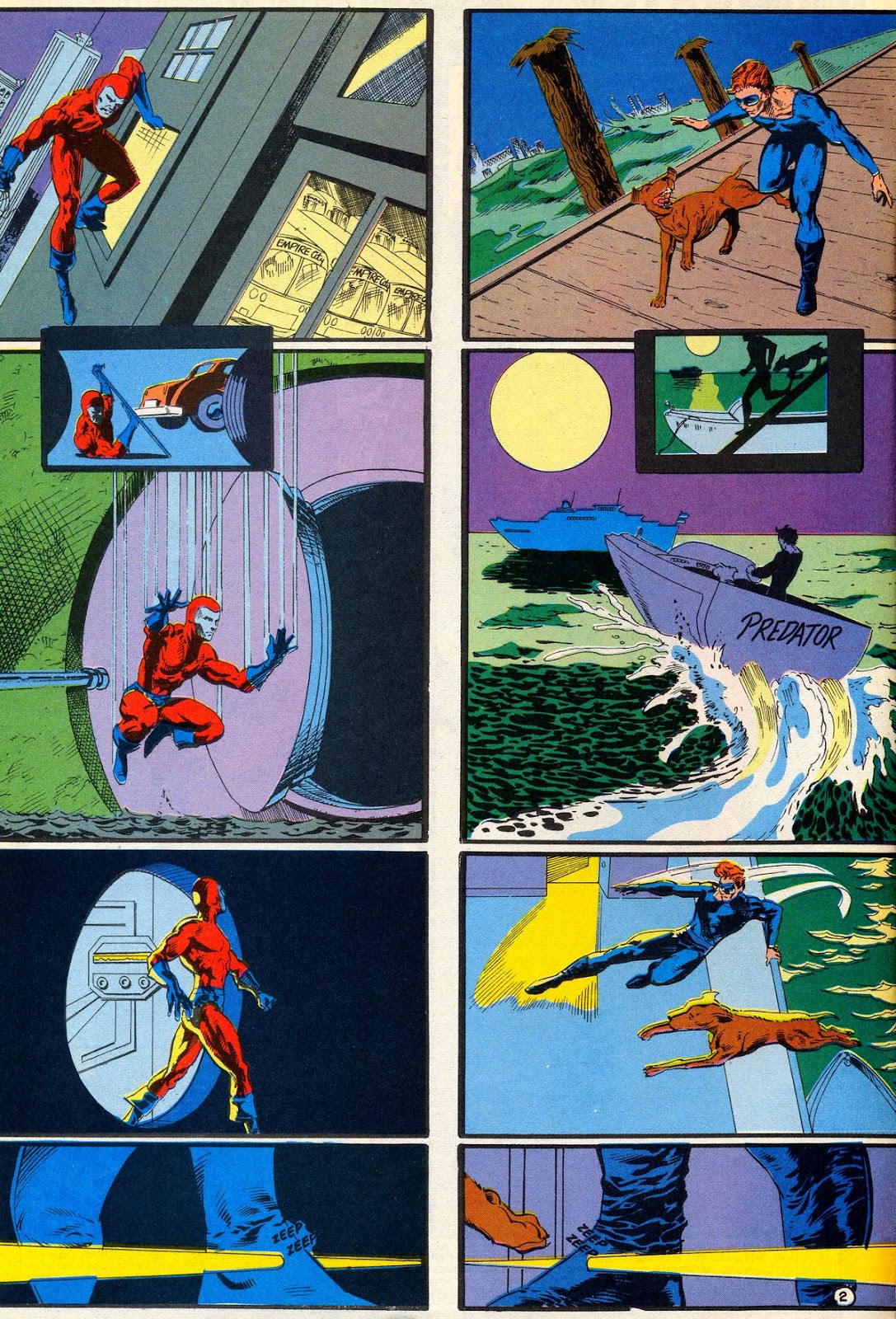 Where the two report to the Grandmaster and run into each other....... 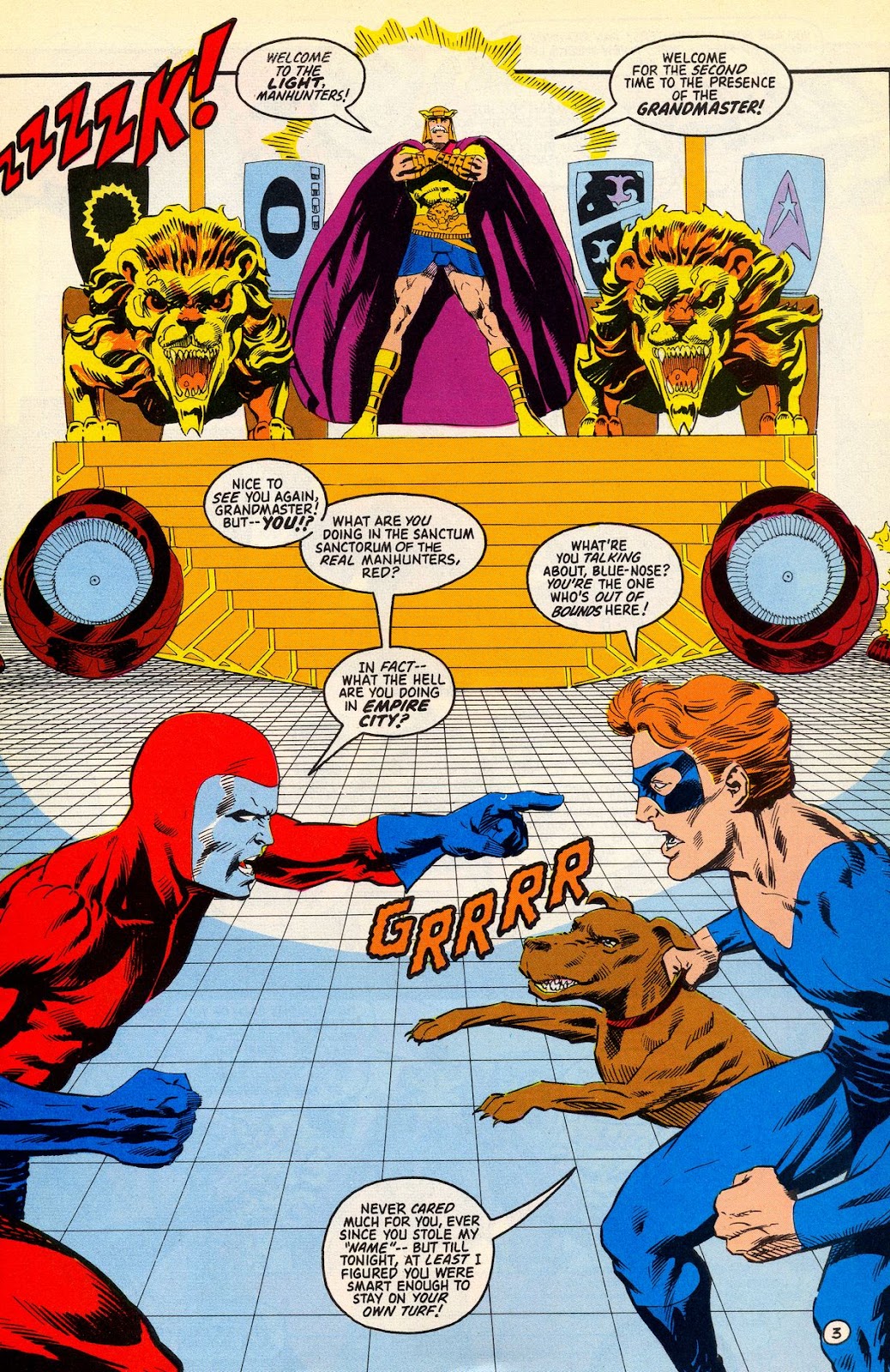 They show each other their union cards (seriously, read the first issue of Millennium, when the Manhunters have their gathering of sleeper agents and Secret origins #22, which has the origins of all of the Manhunters...it's like a labor rally!) and Grandmaster says they both have their dues paid up to date and both were teleported to Manhunter Local 60s Union Hall, to receive an assignment. they are to stop Green Lantern from aiding the Axis Powers! Dunh-dunh-duh! Meanwhile, above Times Square, Iron Munro jumps around while Flying Fox does half of his name (no, I don't mean dinging up collectible books). We learn that Fox's tribe is from an Arctic island, to somehow explain their lack of contact with the White Man (even though the Inuit had plenty of contact) and Arn avoids talking about his father, other than he only knows what his mother told him, which wasn't much. Fox convinces him to call his mother, as he sounds homesick and they rush off to the Perisphere to reach out, reach out and touch someone.... 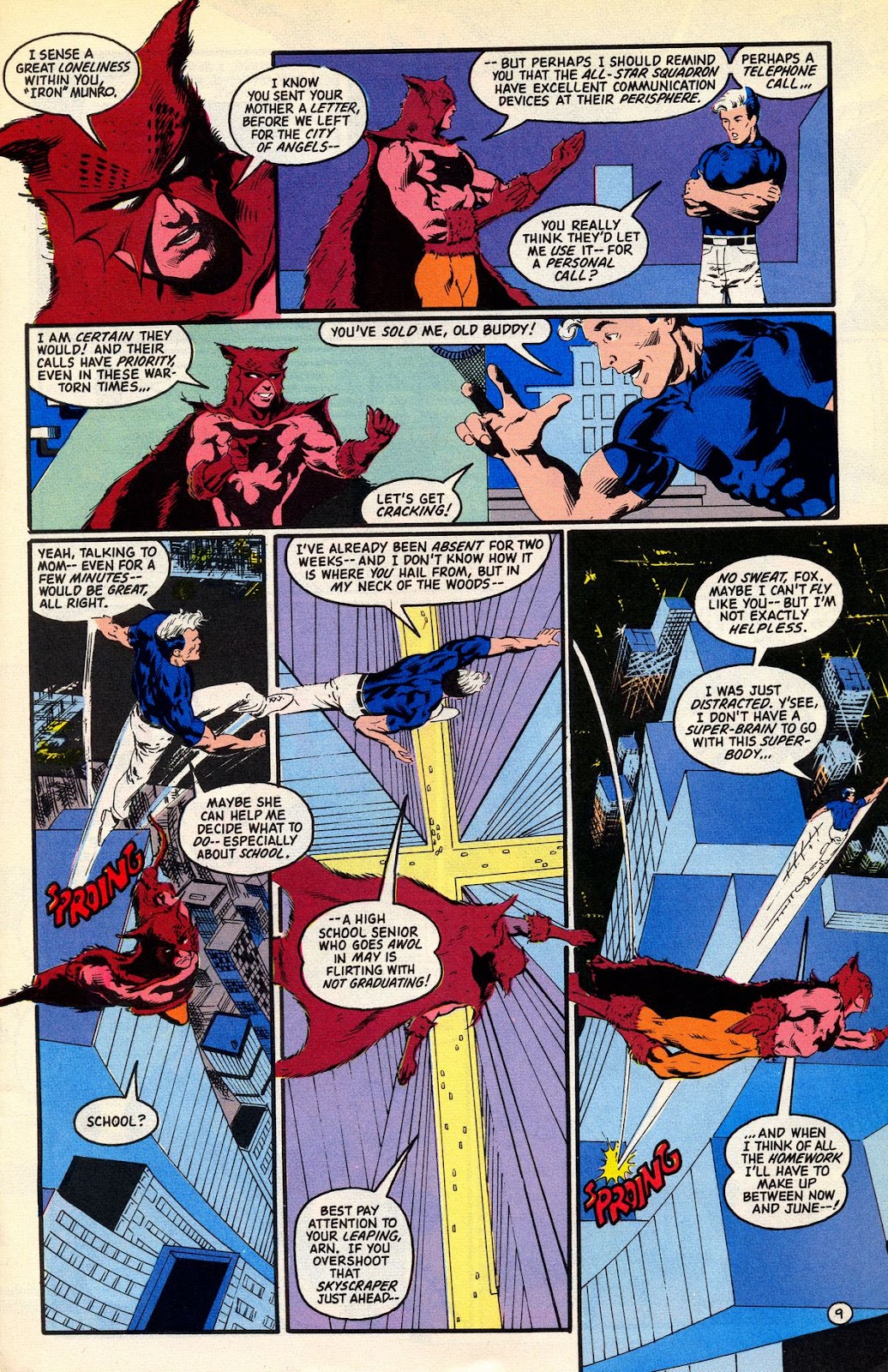 They race to the HQ and give the password to Gernsback (Sammy Reshevsky, the name of a US Chess champion, originally from Poland), then Dyna-Mite shows them the equipment. Arn makes his call and the rest give him some privacy, so that they can go down and interrupt Neptune Perkins and Tsunami, while they make out, inside a salt water tank. They banter, then Arn calls them back to the monitor room, where they have visitors... 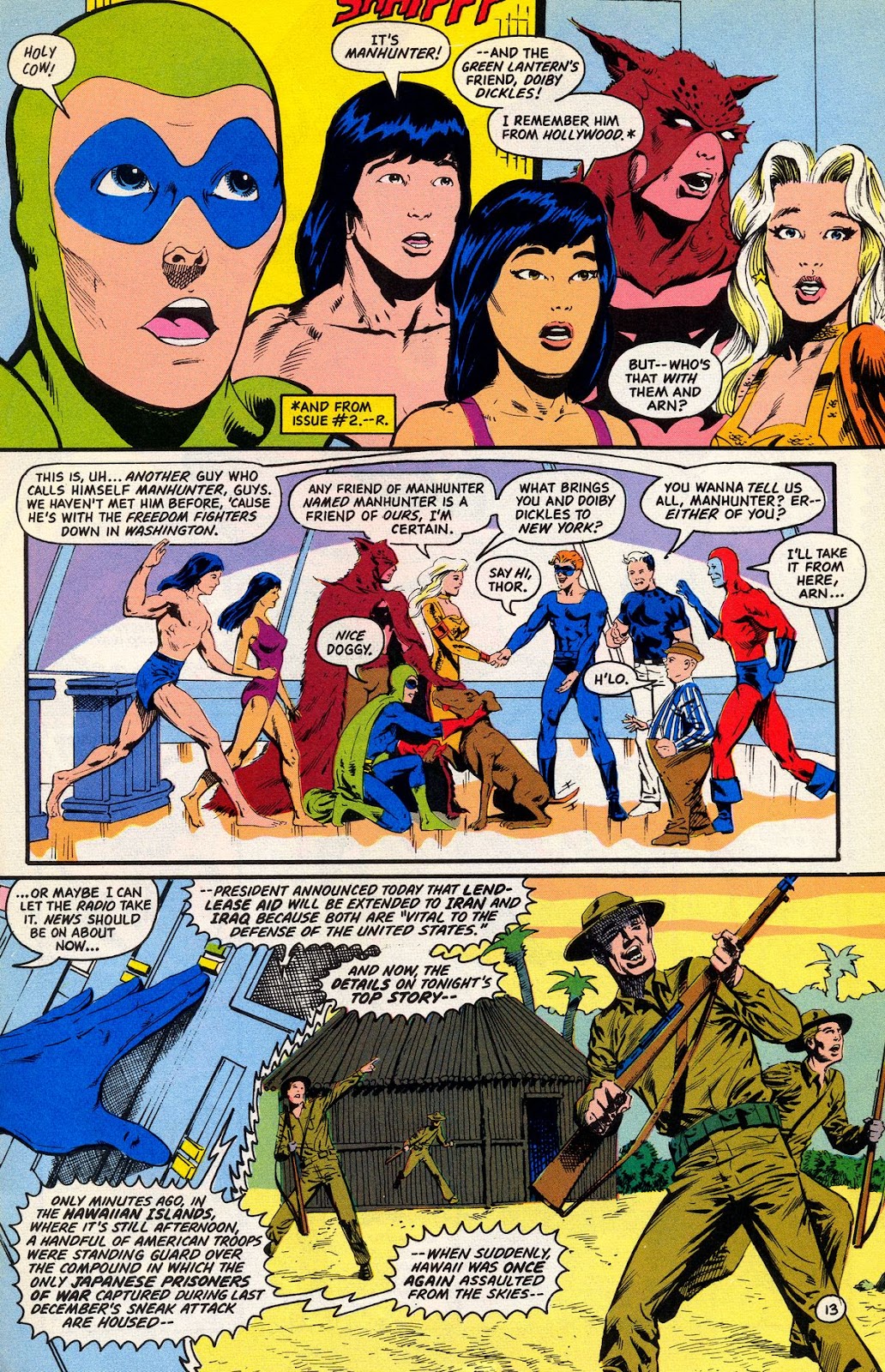 They proceed to play a recorded newsflash of Green Lantern attacking guards at a POW camp, in Hawaii, freeing some Japanese prisoners... 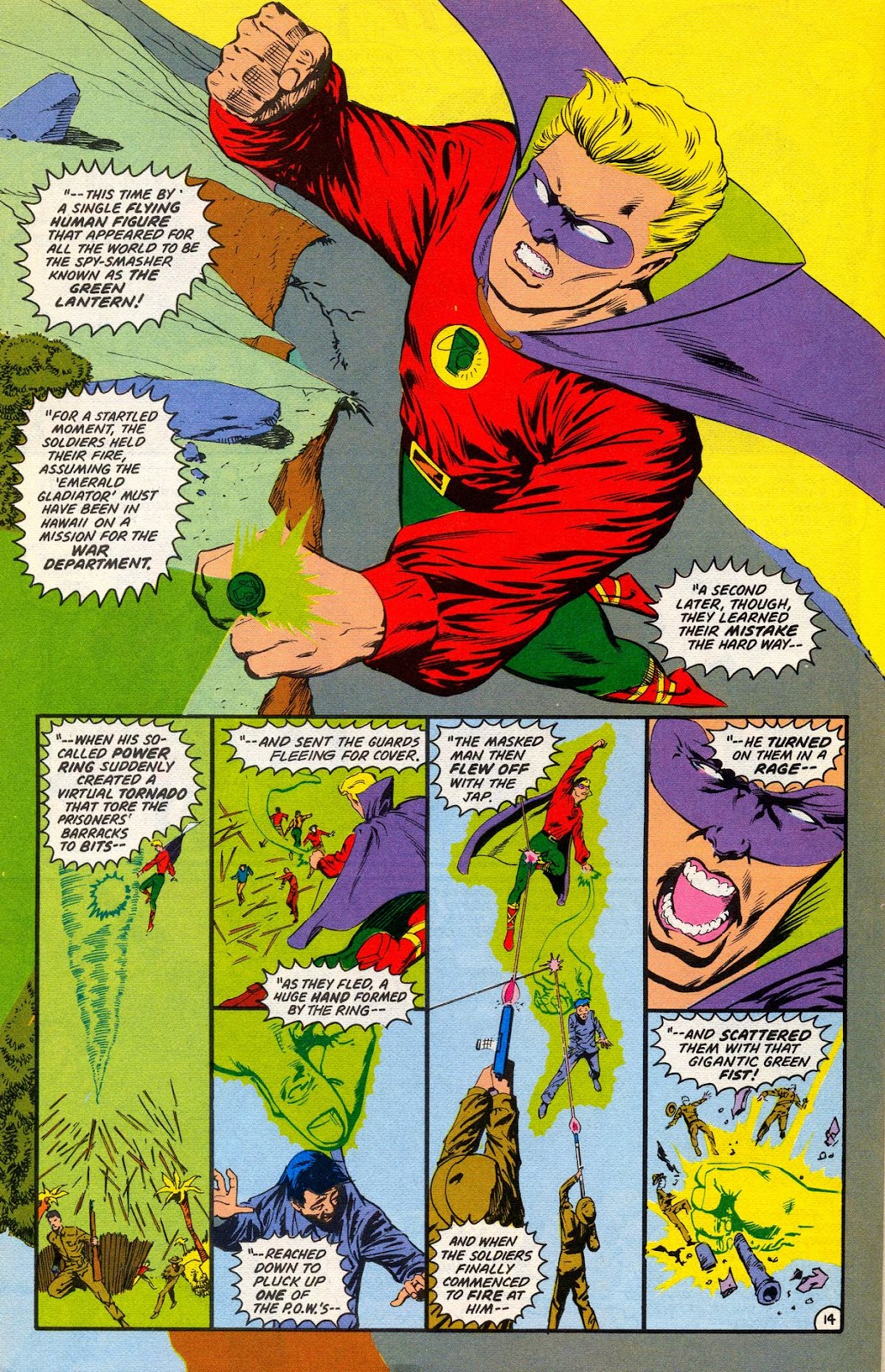 Doiby Dickles confirms some of the story and the kids are recruited to help the two Manhunters, though we get a glimpse that reveals that Doiby has a robotic eye, just like Dan Richards' dog, Thor. Doiby just happens to have a slip of paper, with latitude and longitude coordinates, which reveal where Green Lantern was headed. The first set of coordinates is Hawaii and the gang split and head for the other two locations, as Doiby stays behind to fill in any returning All-Stars. After they are gone, he self-destructs and melts into a pool. Dan Richards, Dan the Dyna-Mite, Tsunami and Flying Fox hop an Army cargo plane, flown by an aviation cadet, to Attu, in the Aleutian Islands. The pilot turns out to be one "Hop" Harrigan and as they arrive, we see a green spirit terrorizing the local populace, since the Aleuts were obviously backwards, simple people, even though they had long standing contact with whites and there were two white men, one a radio operator, living among them when the Japanese invaded, in June. 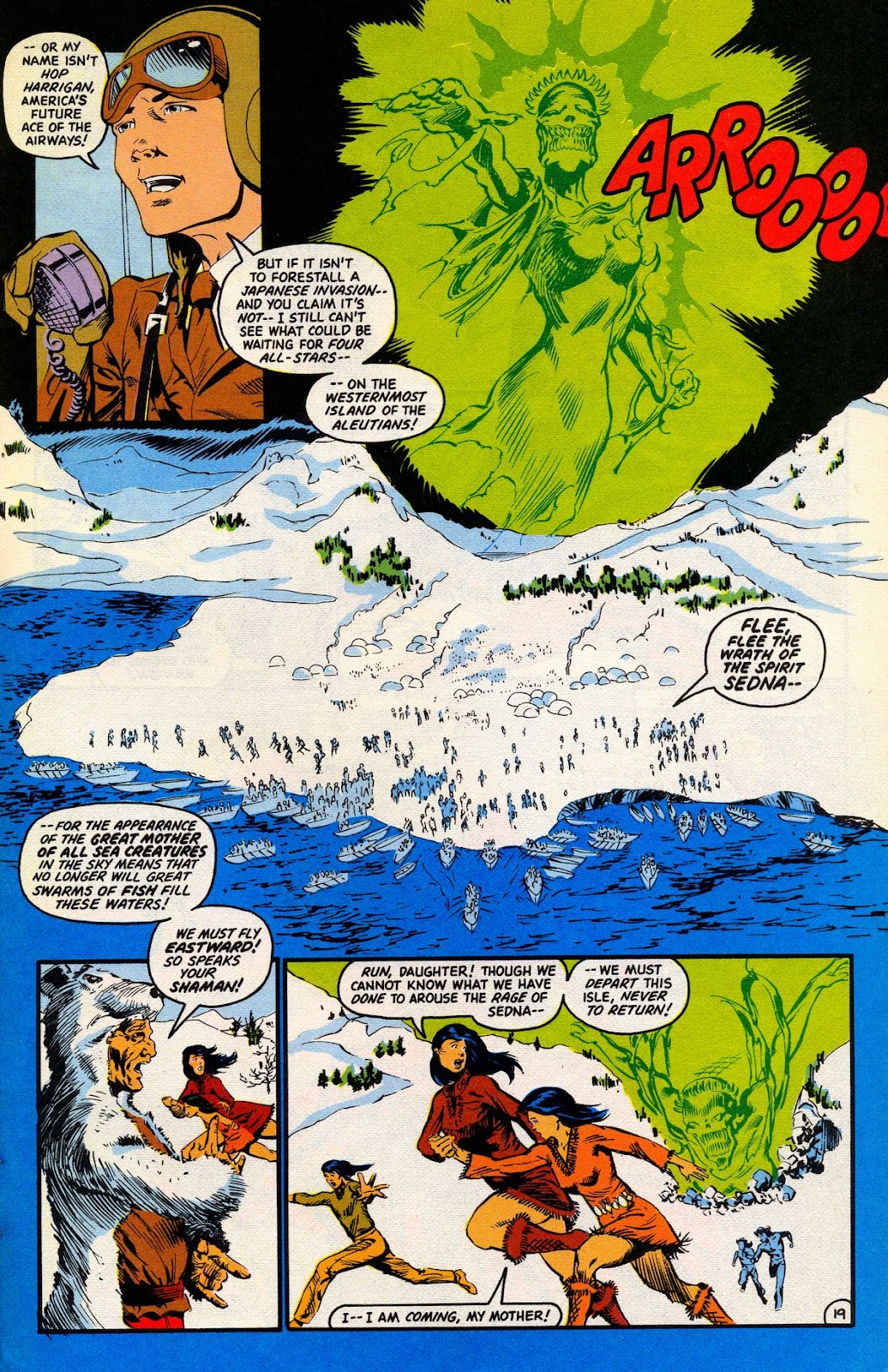 The kids try to stop him and Fox hits him with a log, seemingly knocking him unconscious. However the ring knocks them out. GL comes out of a daze, then falls right back into the spell. 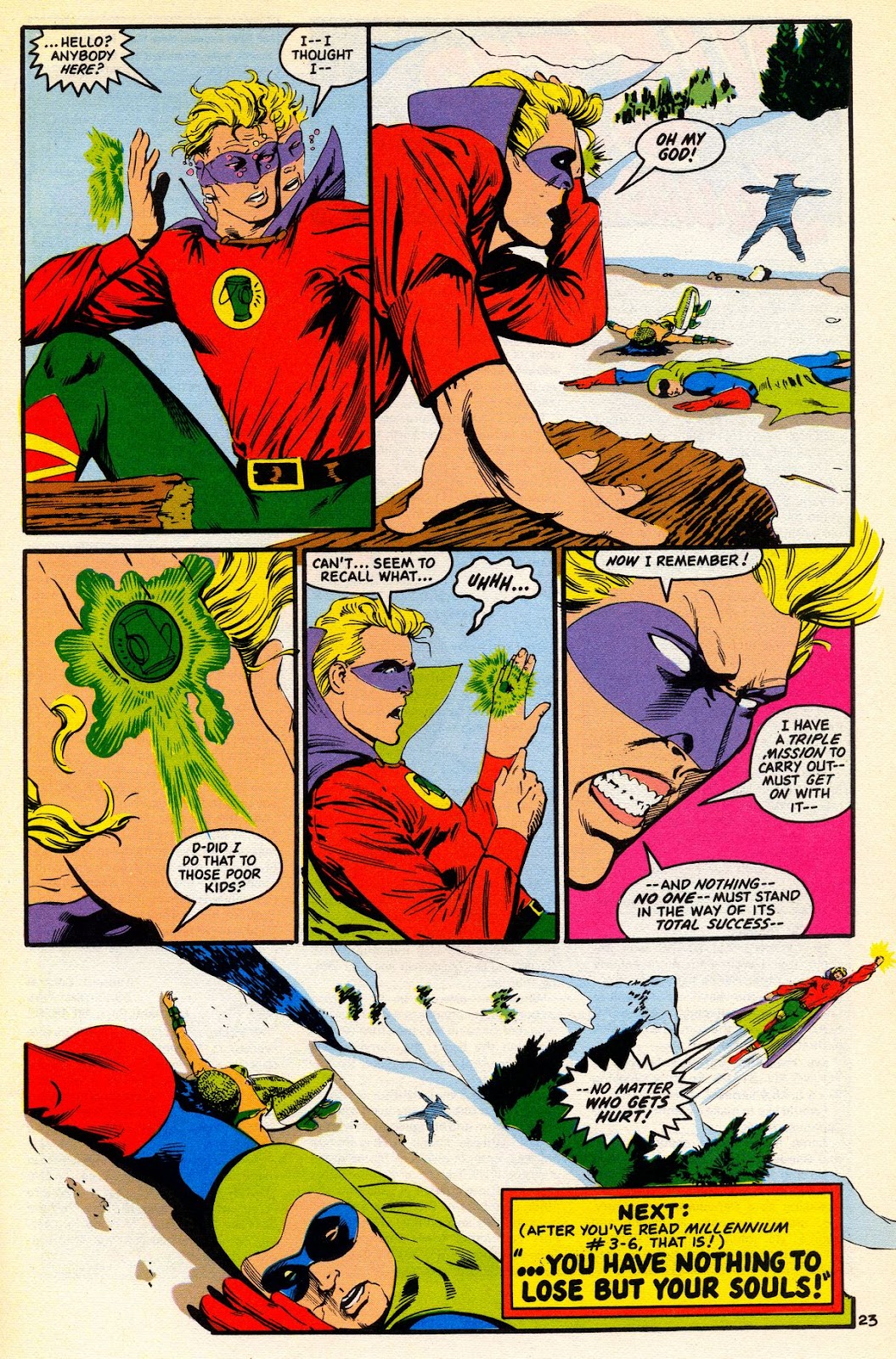 Thoughts: Thoughts: Back in 1987, Millennium sounded like a cool idea. The JLA Manhunter story was pretty good and Mark Shaw had been left to languish in jail and the Green Lanterns were in a bit of a mess, post-Crisis. Steve Englehart, who wrote the excellent JLA 2-parter was at the helm and Joe Staton was drawing the mini. Sounds good; but, when I started reading it, I was massively underwhelmed. the sleeper agents turned out to be ridiculously improbable of throwaway minor characters. The New Gardians were a rather dull bunch, with whom they threw in Tom Kalmaku (aka the insultingly named Pieface) and Harbinger. Extrano was at least interesting, even with the bad name (which was okay, even though "Pieface" was unacceptable. Yes, okay to call a gay man "Strange.") and had some nice depth to him with most of the other characters lacked. It just kind of fell flat, like a spent whoopee cushion. For me, the highlight was Week 4, in the tie-in regular series, as a disparate group of people honed in on a swamp, mixing Batman, captain Atom, the Spectre and the Suicide Squad, with interlinking covers. The Secret Origins issue was pretty decent and tried to make sense of things, as best it could, though I didn't like tying Paul Kirk to the alien Manhunters. This is why I really stopped enjoying the crossover events (Invasion wasn't bad, though I thought the resolution wasn't nearly as good as the opening and War of the Gods had Perez). Millennium just threw a giant monkey wrench into the entire line and stories just ground to a halt, while they played out the underwhelming epic. For Suicide Squad, at least, they were able to work their missions around the periphery, while rehabilitating Mark Shaw, so he could return, as the sole Manhunter, in a new series, from John Ostrander, Kim Yale and Doug Rice. it started really well, then Ostrander stopped creating action-packed stories and spent more time on Mark's relationship with his family and Doug grew bored and left the series. Those first 4 issues, though, were one of the best action-adventure storylines out there, with some really unique ideas, that didn't really play out across the series. Manhunter was supposed to be a supervillain bounty hunter and the criminals he captured would be filtered into Suicide Squad missions. That never really played out. This story is typical of things, as the Manhunters dupe heroes into doing their bidding, because everyone suddenly becomes stupid. we aren't even sure why Green Lantern is under Manhunter control, since he isn't tied to the Green Lantern Corps or the Guardians, except via the Starheart, which was the source of his ring's power. Like I said, convoluted and messy. The sequence on Attu just makes me nuts. This comic was written in 1987. It didn't take a huge amount of research to know that the Aleuts were not some simple-minded group, as in a Hollywood film, any more than the Pacific Islanders encountered in the Solomons, Marianas or Marshall Islands were, in the South pacific. They had had contact with the white man and traded, for generations. No, their societies weren't greatly integrated; but, it wasn't what we see, in 1942. At the time of the Japanese invasion, in June 7, 1942, there were only 45 inhabitants, including a white radio operator and a white school teacher, his wife. the populace lived in houses, not igloos or wigwams. It looks like Brian Murray drew igloos and Roy let it slide. Meanwhile, we are led to continue to believe that Flying Fox's people had no outside contact, until the Nazis turned up; no whaling ships, no seal hunters, no fishermen or explorers. No one turned up in inhabitable land, until 1942. Right....... Anyhoo, I really find this a distraction and it doesn't do much for the Dan Richards Manhunter, though Roy used him more in Infinity, Inc, in the present, and this acted as back story for that. Next issue will feature Paul Kirk, who was the better Manhunter, anyway (not that the Quality one was bad, though he changed his costume quite a lot, in the early stories). Paul Kirk got to be rendered by Simon & Kirby! Historical Notes: Nothing significant. I've covered the Japanese invasion of Attu and Kiska before, as well as their ejection, by US forces, the next year. Attu was actually abandoned by the garrison force, after a while, after all of the inhabitants who survived (Charles Jones, the radio operator, was killed, while his wife survived) were removed to Japan, as prisoners, with 16 of the 42 survivors dying in prison camps, in Hokkaido (Mrs Jones was held in Yokohama, along with Australian prisoners, from Rabaul and New Guinea). the Japanese garrison was withdrawn and added to strengthen Kiska, in September 1942, until late October, when 500 were restationed there. By March, 1943, there were 2900. The invasion of Attu by the US military was a mess, with vehicles unable to operate, shortage of landing craft, supplies and winter gear. the Japanese did not contest the landings, but fought hard from their positions, before launching banzai charges. they died nearly to a man, before the island was completely retaken. Attu had been trading with whites since the 1700s, when Russian traders came from Kamchatka. Aleut houses were actually dug in the ground, then covered with a roof of driftwood, thatched grass and covered with earth, to insulate them, with mats placed on the floors. Several families would live together in the 50ft by 20 ft homes. What we see in the issue are eskimo igloos and a population much larger than existed in 1945. The scene looks rather like the wildling village we see evacuated in game of Thrones, via the sea, when the Night King and his undead army come.
|
|
|
|
Post by zaku on May 26, 2021 2:47:07 GMT -5
This story is typical of things, as the Manhunters dupe heroes into doing their bidding, because everyone suddenly becomes stupid. we aren't even sure why Green Lantern is under Manhunter control, since he isn't tied to the Green Lantern Corps or the Guardians, except via the Starheart, which was the source of his ring's power. Like I said, convoluted and messy. The post-Crisis history of the Starheart has always seemed incredibly convoluted to me. Just reading a short synopsis on Wikipedia gives me a headache. But I believe that at the time its origin was the same as pre-Crisis (wild magic captured and imprisoned by the Guardians)? |
|
|
|
Post by codystarbuck on Jun 3, 2021 17:13:53 GMT -5
Young All-Stars #9 Millennium still intruding. Baron Blitkrieg having a fish fry! Creative Team: Roy & Dann Thomas-writers, Brian Murray-pencils, Malcolm Jones III-inks, Jean Simek-letters, Gene D'Angelo-colors Synopsis: May 1942, somewhere west of Jamaica. I guess that means the Caymans (which is north-west), unless Roy means the Yucatan. Not many islands west of Jamaica, anyway). A young woman goes swimming in an isolated cove and runs into a blond guy, with a scar across his right eye. She is startled, but he calms and charms her. her name is Maria and she proposes they talk outside the water, but he isn't wearing shorts. She turns her back while he gets dressed and turns around to find.... 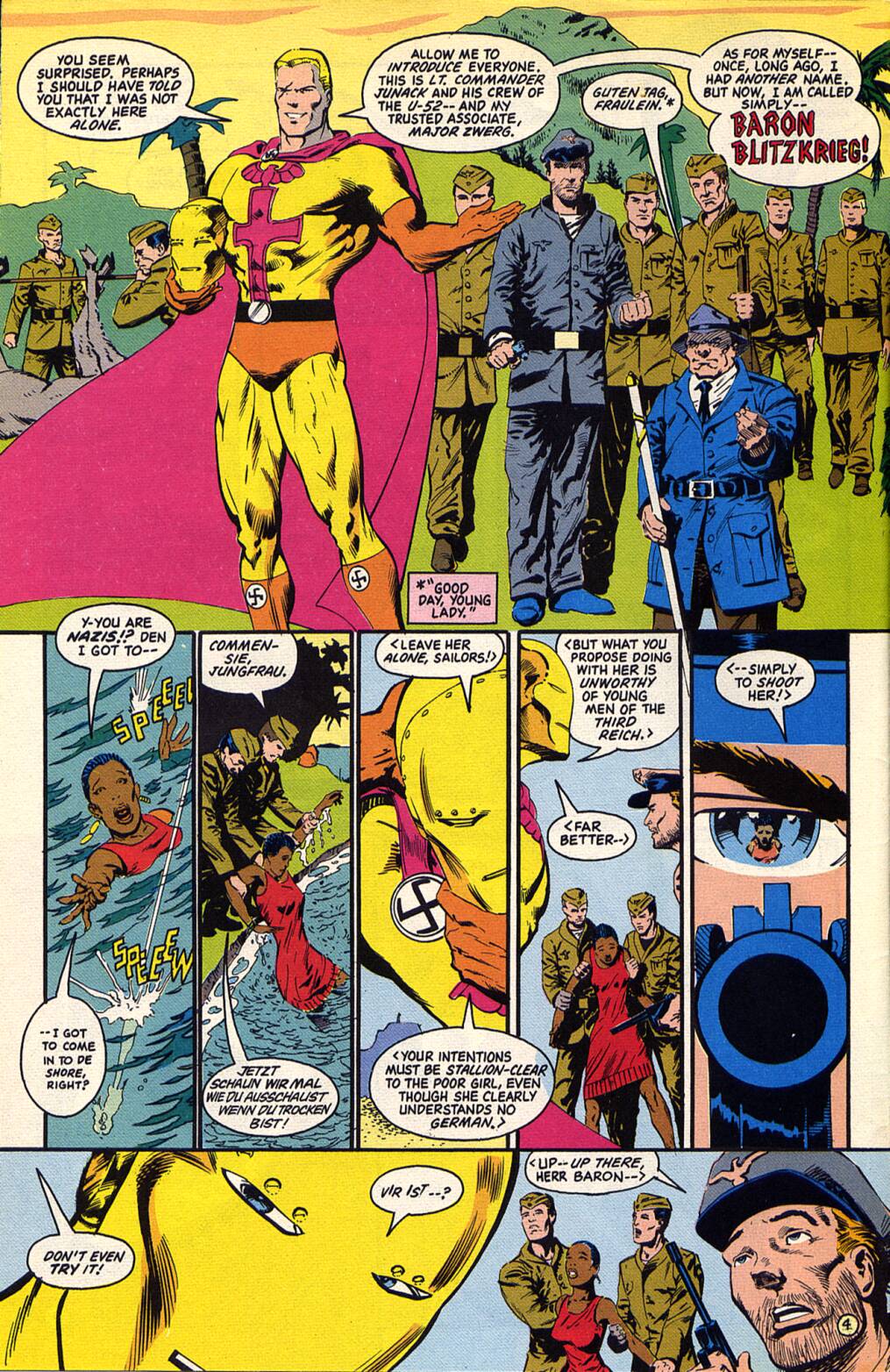 Baron Blitzkrieg and his All-Nazi Band! Zwerg looking a lot like Toht, from Raiders of the Lost Ark, there. The U-Boat sailors look a lot more like the Wehrmacht than the Kriegsmarine. Zwerg wants to shoot her, when Green Lantern turns up. He distracts the Nazis so the girl can run. the ring protects him as he kicks Heine. Then, Herr Baron fights back. The ring blocks his Nazi vision, but, GL has to concentrate so much will to do it, he is open for a sucker punch, which breaks his concentration. he still whacks the Nazi, before he hurls a Kar 98k rifle at him, with the wooden stock getting past the ring and knocking GL out. 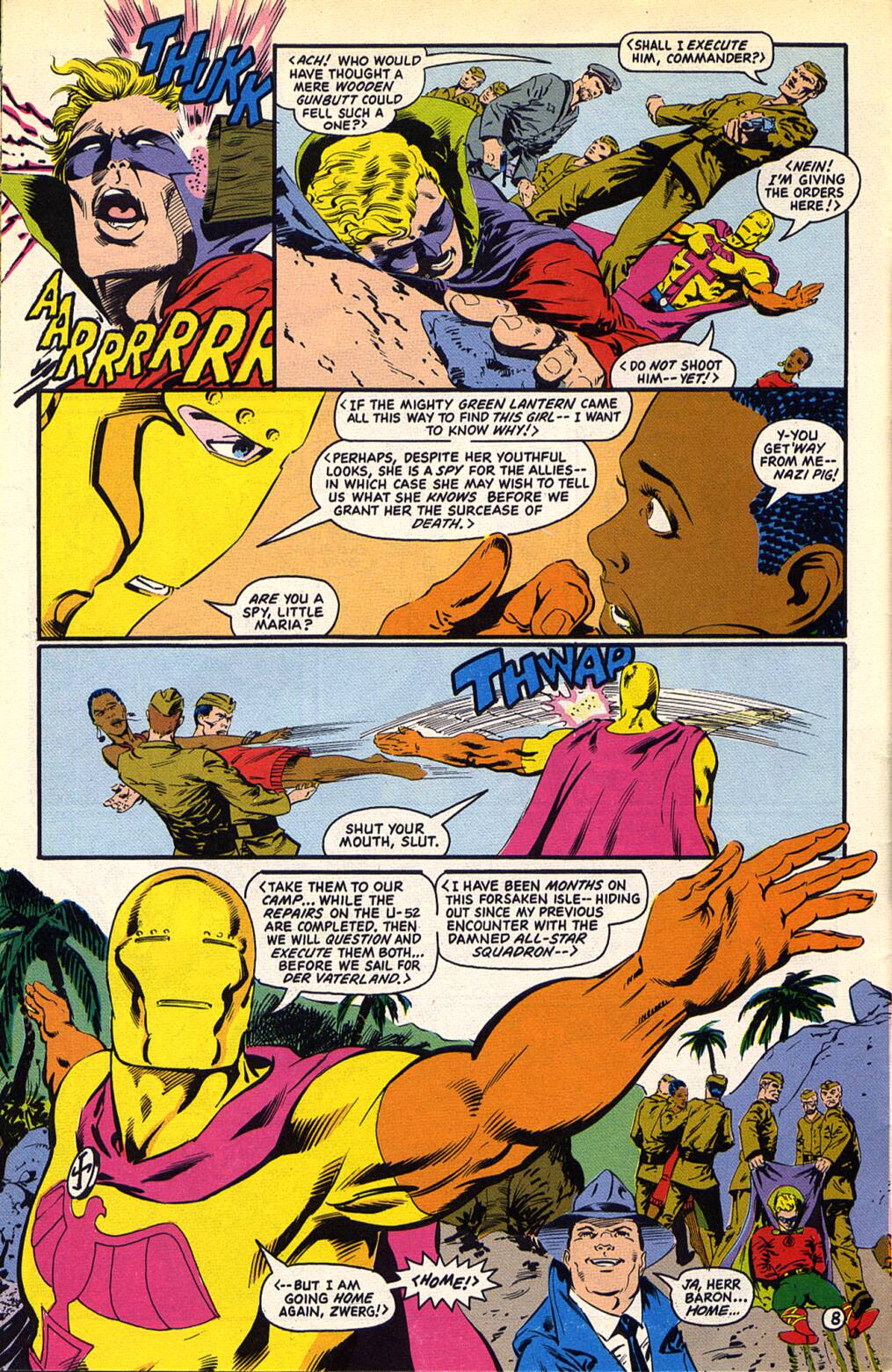 Baron B orders him and Maria to be taken to their camp, as he wants to know why GL was looking for a girl, named Maria, without singing and dancing. He first Nazi-slaps Maria, for good effect. Meanwhile, Perky, Fury, and Iron Munro are winging their way to the Caribbean, to find out what GL wanted there and Perky hears rustling in the cargo area. Fury goes to check and discovers Tigress, stowing away. She tries to hold them off with her crossbows, but Arn slugs her and then gets a chastisement from Fury. Tigress tells them to cool their jets. She reveals that she is Paula brooks and she became Tigress to get close to her crush, Paul Kirk, aka Manhunter... 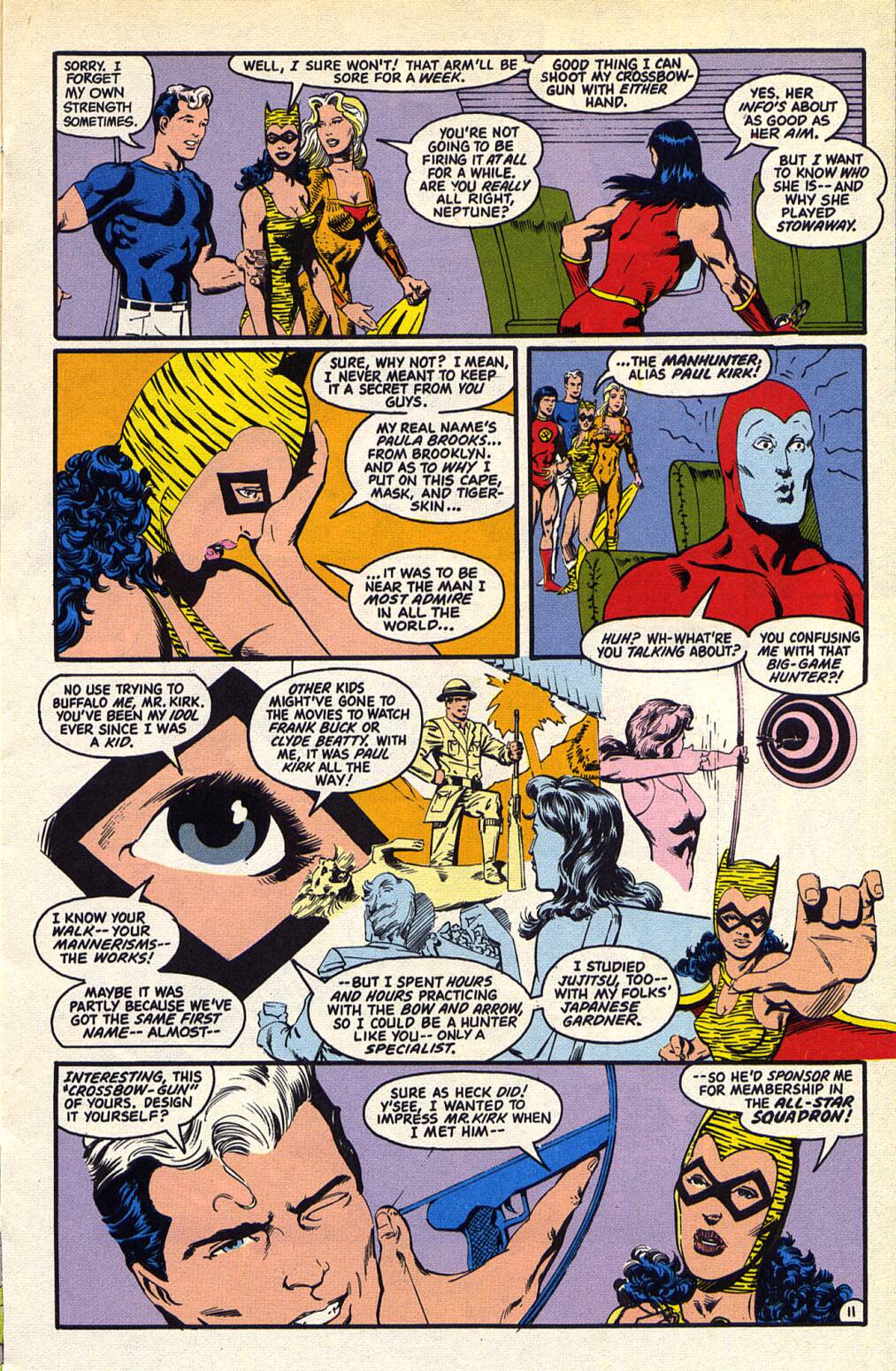 She wants to join the Squadron, as drool over Manhunter. Arn argues, but the point is moot, as they have arrived at their destination. They land at an airstrip and wonder that there aren't British soldiers around. They are met by father Hanely, from Harlem, who runs an orphanage on the island. he is looking for Maria, who is missing from the orphanage. Maria not being a white girl, the All-Stars claim too much already on their plate, until Father Hanely mentions U-Boat activity in the area. suddenly, they have time. Manhunter decides they are going to check out the coves where U-Boat crews come in for rest and refit. The Baron's crew row a wooden boat to the U-Boat, with Maria hogtied and GL trussed up to a tree hunk. But, then, dolphins attack and dump them into the ocean. 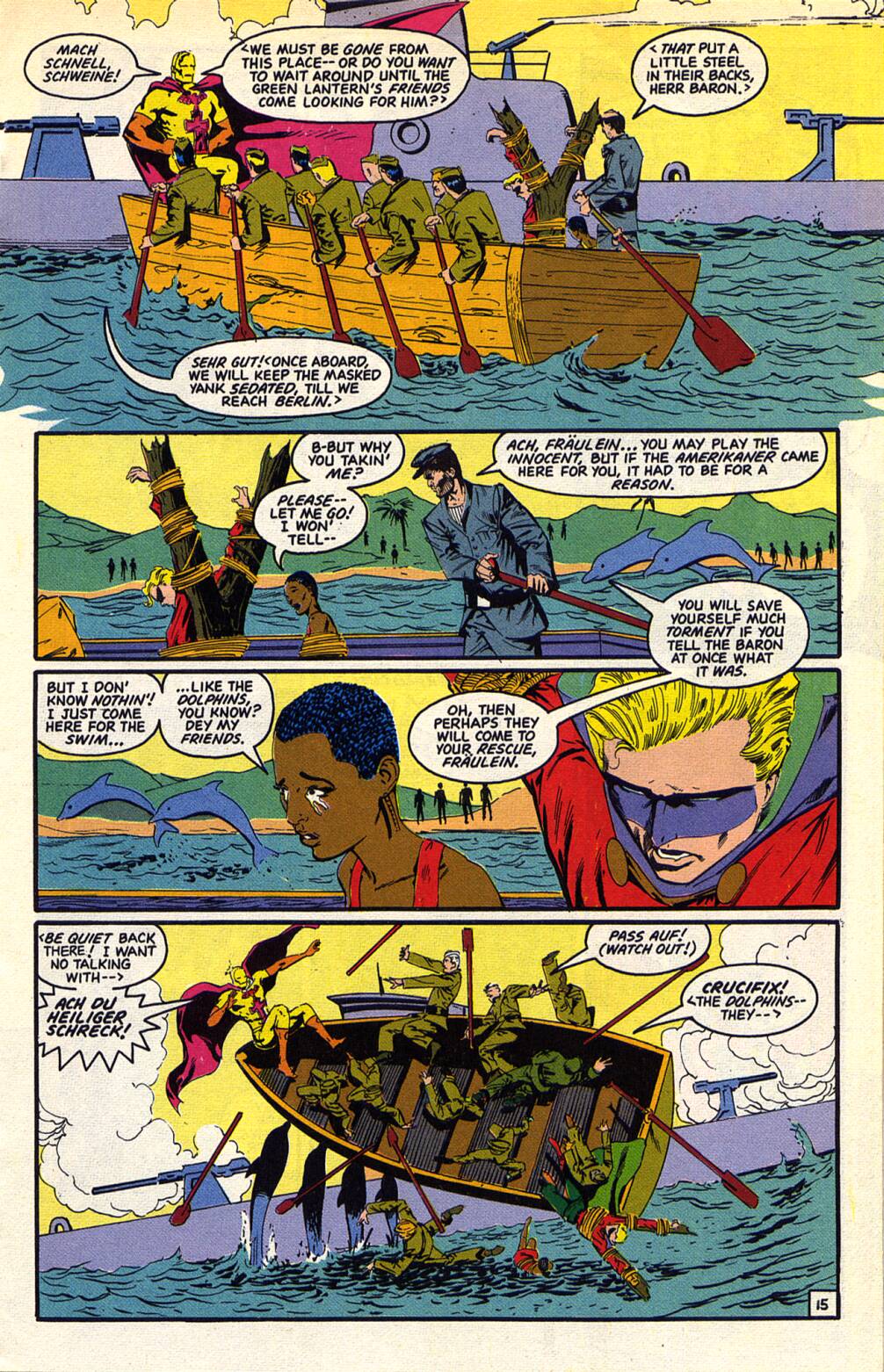 BB flies, but the dolphins push GL away from the Nazis and relieve them of weapons. We then see Perky guiding them, with powers he inherited from Aquaman, retroactively, thanks to Crisis (metaphorically speaking). While the sailors stand around on shore, sucking sausages and saurkraut, Manhunter attacks, with help from Tigress. The Nazis on the sub start shooting the dolphins and Fury and Arn turn up and start smashing Nazis. Father Hanely watches from the beach. BB swoops in for an attack and Arn hurls the deck gun at him. he melts it with his Nazi-vision. Fury gets to him first and gets knocked out, then Arn gets a fist to the mouth and then a flurry of blows. Arn recovers and delivers his own shot... 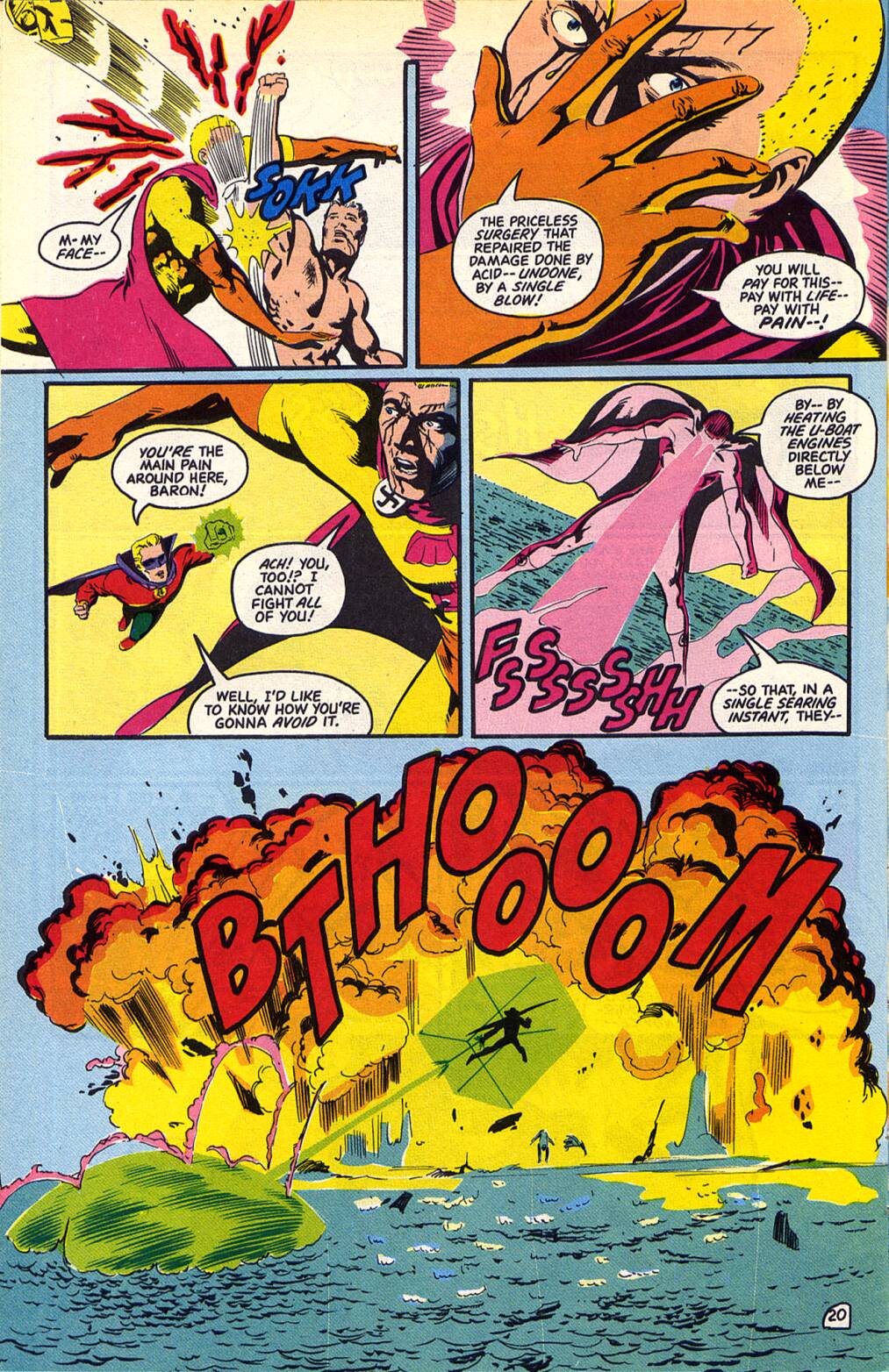 GL shows up and blocks the Nazi-vision, which them explodes the sub. They get to shore and Perky reveals he can communicate with aquatic mammals, but not fish. Maria apologizes to Father Hanely, for running off and they ask GL how he knew she was there and in trouble and he says, "Iuhnno!" They secure the sailors and take off, and Father Hanely gives Arn a briefcase with Prof Hardin's possessions, which he will understand about, in the future. In New York, GL calls a hearing to face charges for what happened and starts to hand over his ring, when the ring takes over... 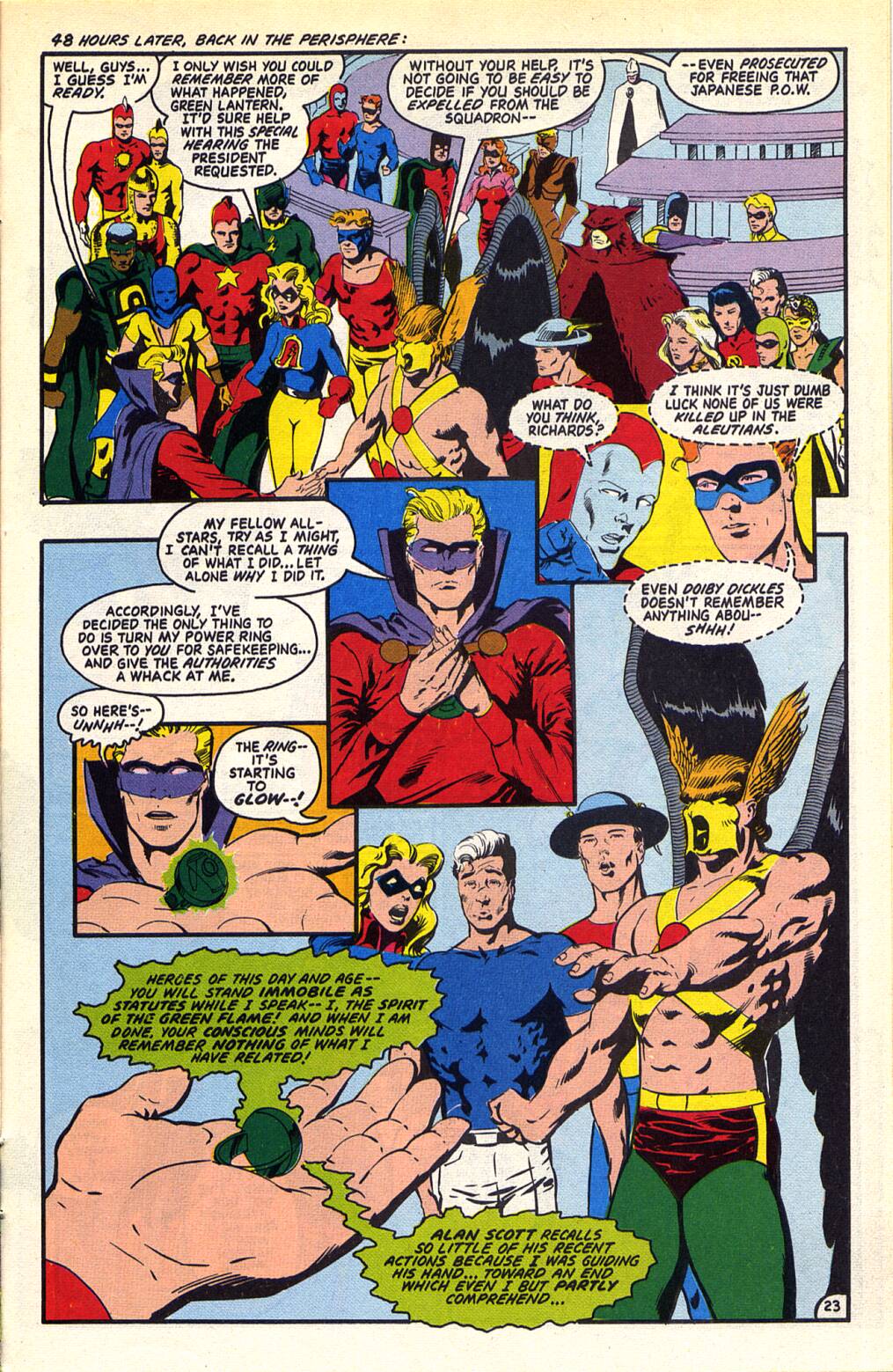 The ring reveals the end result of Millennium (bored DC readers) and then wipes everyone's mind, which makes you wonder why it bothered to tell them anything, then everyone comes out of it and dismisses the case. Tigress is put up for probationary membership and then Arn looks in the briefcase and finds the journal of Hugo Danner, his father. Thoughts: This makes about as much sense as nailing your hand to a table. It gets the job done but there is no good reason for it. Neither Paul Kirk nor Dan Richards learn they were pawns of the Manhunters (Richards knew, eventually and reveled in it, until it caused problems in the future). Green Lantern doesn't know what he was doing and it is all a waste of two issues. No idea what Baron Blitzkrieg was doing there other than to be a convenient enemy, tooling around with a U-Boat crew and no specific mission. That makes no sense. Maybe in a future issue. The art is decent; so, there is that, but the story is all over the place and the kids still need an adult All-Star to handle things. Not exactly the way to sell a new book. Historical Notes: Roy references U-Boat activity in the Caribbean, which is factual. A German maritime offensive was launched in February, 1942, aiming to disrupt the flow of oil form the Venezuelan oil filds, as well as Dutch-held Curacao. They attacked shipping throughout the region, including the sinking of two Mexican tankers, prompting Mexico to declare war on Germany. They acted with near impunity in the early months of 1942; but, by late summer, convoys had been better organized, with more escorts and air cover and the Germans redesignated their attacks on the North Atlantic sector. By 1943, technology and resources had converged to make U-Boat hunting that much easier, with more escort forces, especially anti-submarine vessels, such as Destroyer Escorts (DE), equipped with sonar and depth charges, but faster and more maneuverable than destroyers, as well as long range bombers with ASW radars and armed with depth charges. B-24s gave the range and the development of Leigh Lights allowed them to immediately illuminate a surface contact from their radar, and drop depth charges before the U-Boat crew could crash dive, resulting in higher numbers of successful attacks on German submarines. The completion of the Operation Torch landings put more ships at the disposal of convoys and merchant aircraft carriers (MAC) allowed the convoys to have fighter air support for their entire journey. Additional support came in the form of blimps, which could remain on station and conduct depth charge attacks on identified submarines. German losses rapidly mounted and U-Boats were largely neutralized before the Operation overlord landings, in 1944. With the liberation of France, the German sub pens at La Rochelle, Bordeaux, and Lorient were completely out of the picture.
|
|
|
|
Post by codystarbuck on Jun 8, 2021 14:58:24 GMT -5
Young All-Stars #10 The story of Hugo Danner! Creative Team: Roy & Dann Thomas-writers/adapters, Brina Murray-art, Jean Simek-letters, Gene D'Angelo-colors Adapted from Philip Wylie's novel, Gladiator. Okay, this is actually Roy's second go-round with adapting Gladiator. The first was in Marvel Preview #9....  ...with Tony DeZuniga. However, Roy never finished the story, as part 2 was never published. Roy only took the story to World War 1. There is more that follows. I covered Marvel Preview #9, in my Land of the Misfit Stories thread. That was in a black & white magazine and not subject to the Code. This is, though times had changed and the suggestion of nookie was okay, so long as you didn't get overly detailed. I'm not going to spend a lot of time rehashing the story; so, I will just broadly summarize things and focus more on the new stuff Roy adds and the latter part of the story. Synopsis: The Rookies are going to be headed to Arn's home state, Colorado, for a war bond rally, in the morning. Tonight, Arn is going to read his father's diary, given to him by the priest, last issue. 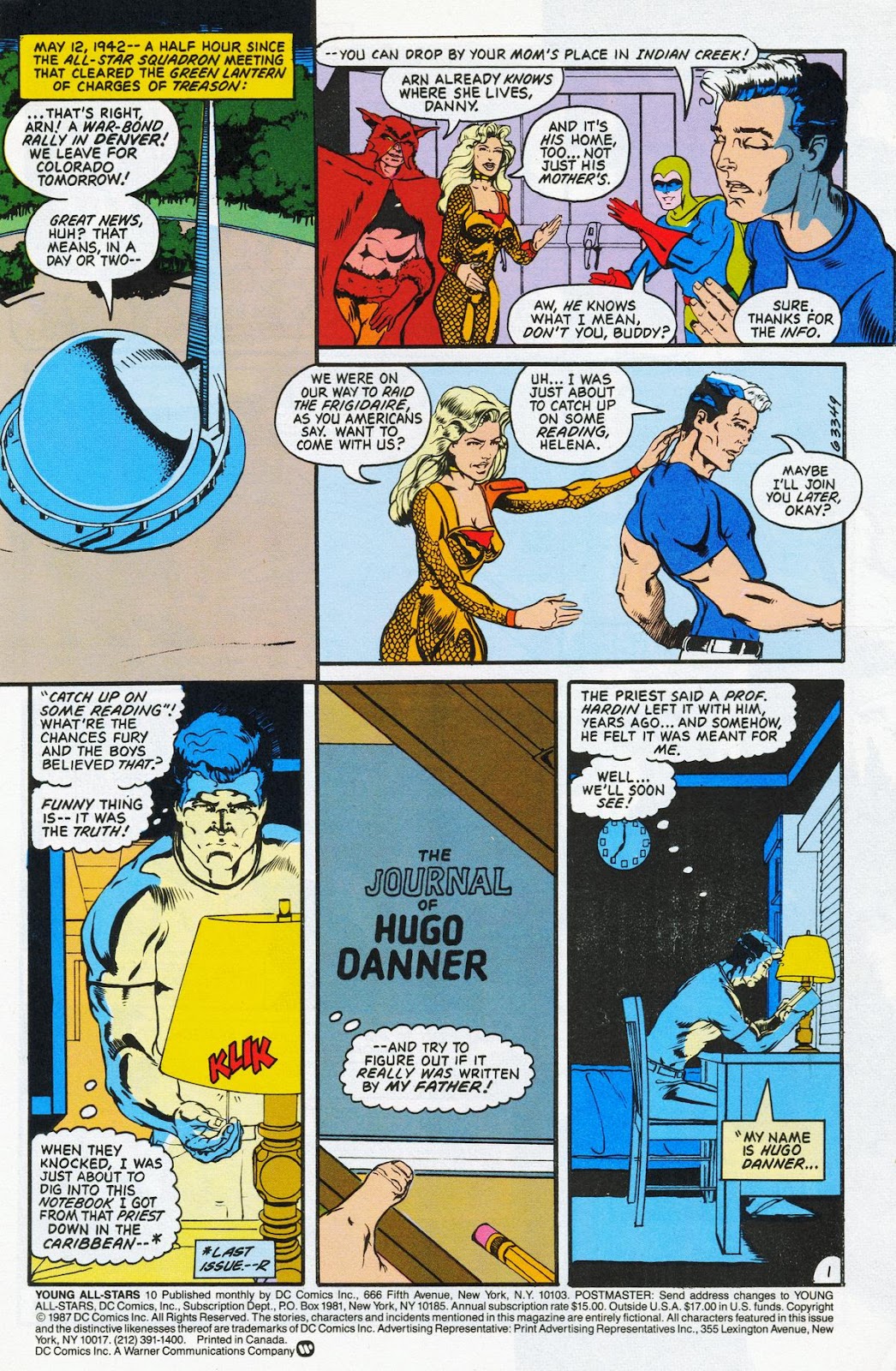 Hugo Danner was born in Indian Creek, CO; the son of biology professor Abednego (as in Shadrach, Meshach & Abednego, from the Book of Daniel) Danner and his wife Matilda. Abednego was on the hen-pecked side, while he experimented with alkaline radicals, leading to a serum he injected into a pregnant cat. The catr produced an offspring that could kill a holstein cow and survive a gunshot, but wasn't impervious to poison. Abednego saw the dangers of his serum and buried the secret with the cat. Then his wife got pregnant and he dug it back up and injected it into her, without her knowledge or consent (after slipping her a mickey). She figured it out when she couldn't pry the baby out of his crib and she smacked the old man a good one, though he started in on a eugenics rant and that she would be proud of him. He grows and has a voracious appetite and is counselled about his strength. At school he is bullied and while under the influence of impressing a girl, he fights back and nearly kills the kid. As time progresses, he experiments with his strength and speed in the woods, and gets busy with Anna Blake, the girl he was trying to impress.... 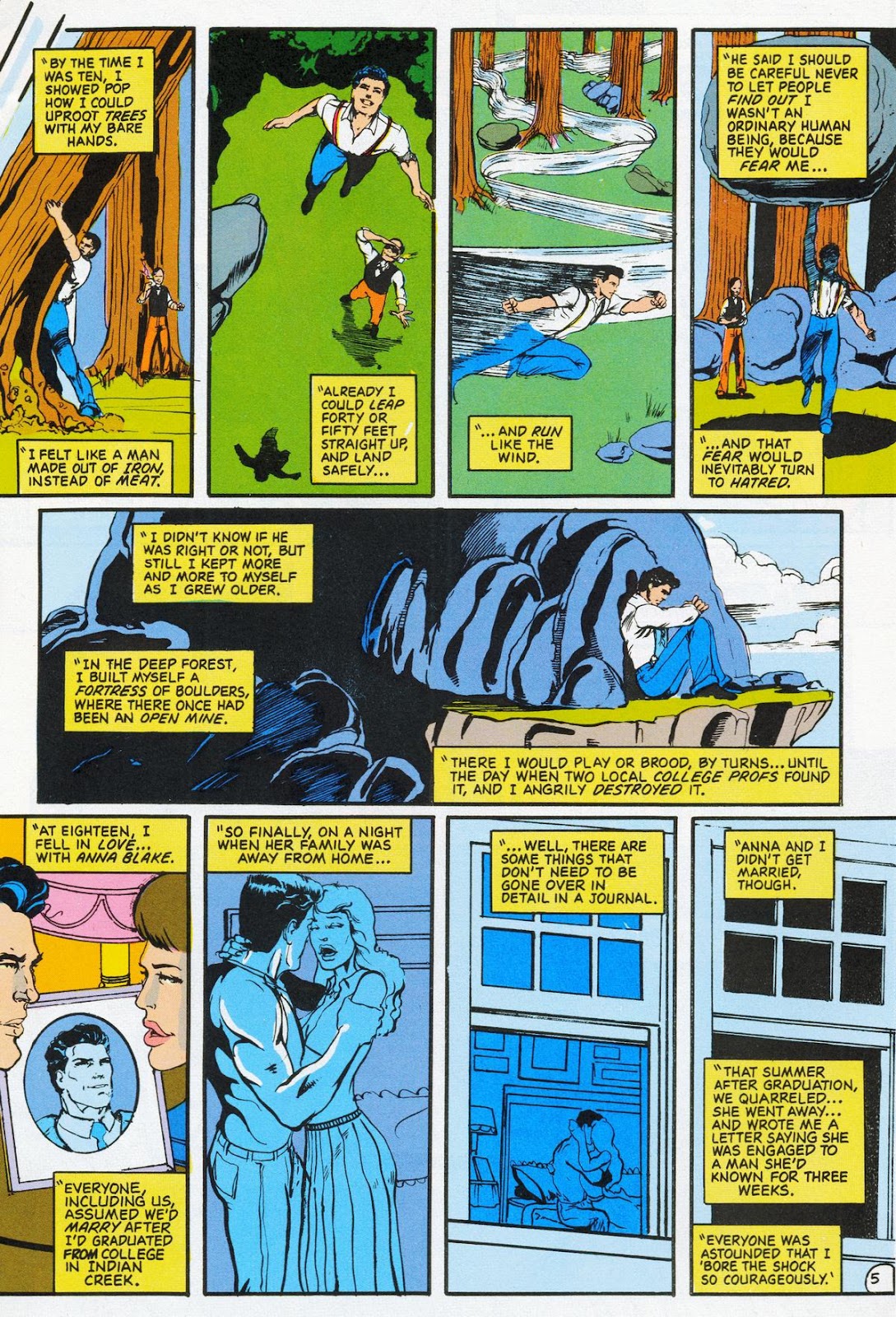 ...They don't marry and goes off to college and becomes a football hero and beds an older socialite, after promising to win the game. he goes off to New York, but has no trade. He gets taken by a hooker (Roy says dancer, but, she's pretty much a hooker in the novel and Marvel Preview). he is about to steal a diamond ring, but stops himself. he earns money in a carnival prize fight and then becomes the strongman there. he meets and falls for a woman, named Charlotte, who leaves him for a friend. Hugo goes back to school and football, but he overdoes it and kills an opposing player in a game and that is that. Hugo travels on a ship, for a time, then ends up in Marseilles, when the war breaks out. He joins the French Foreign Legion and fights in the trenches; but, when a friend is killed, he loses it and becomes a One Man Army Corps.....  He slaughters the German trench with his bare hands. He collapses after expending his energy and wakes up in a hospital. he sees one of his friends, blinded by mustard gas. he makes a vow to take the fight to the Kaiser and his generals, in berlin. He plans to take a plane into Germany and battle his way to them; But, at the aerodrome, the news of the Armistice comes. After the war, Hugo learns that a friend's father, a banker and war profiteer, invested his savings and turned it into a small fortune. Hugo sends it home to his parents. he gets a job working in a steel mill, before his friend's father convinces him to come work in one of his banks. He has few friends, but beds many female tellers. Fate intervenes, again, as a clerk gets locked in the vault and Hugo rips the door open to free him. Rather than a reward, the banker orders his arrest and the police try to beat information out of him.... 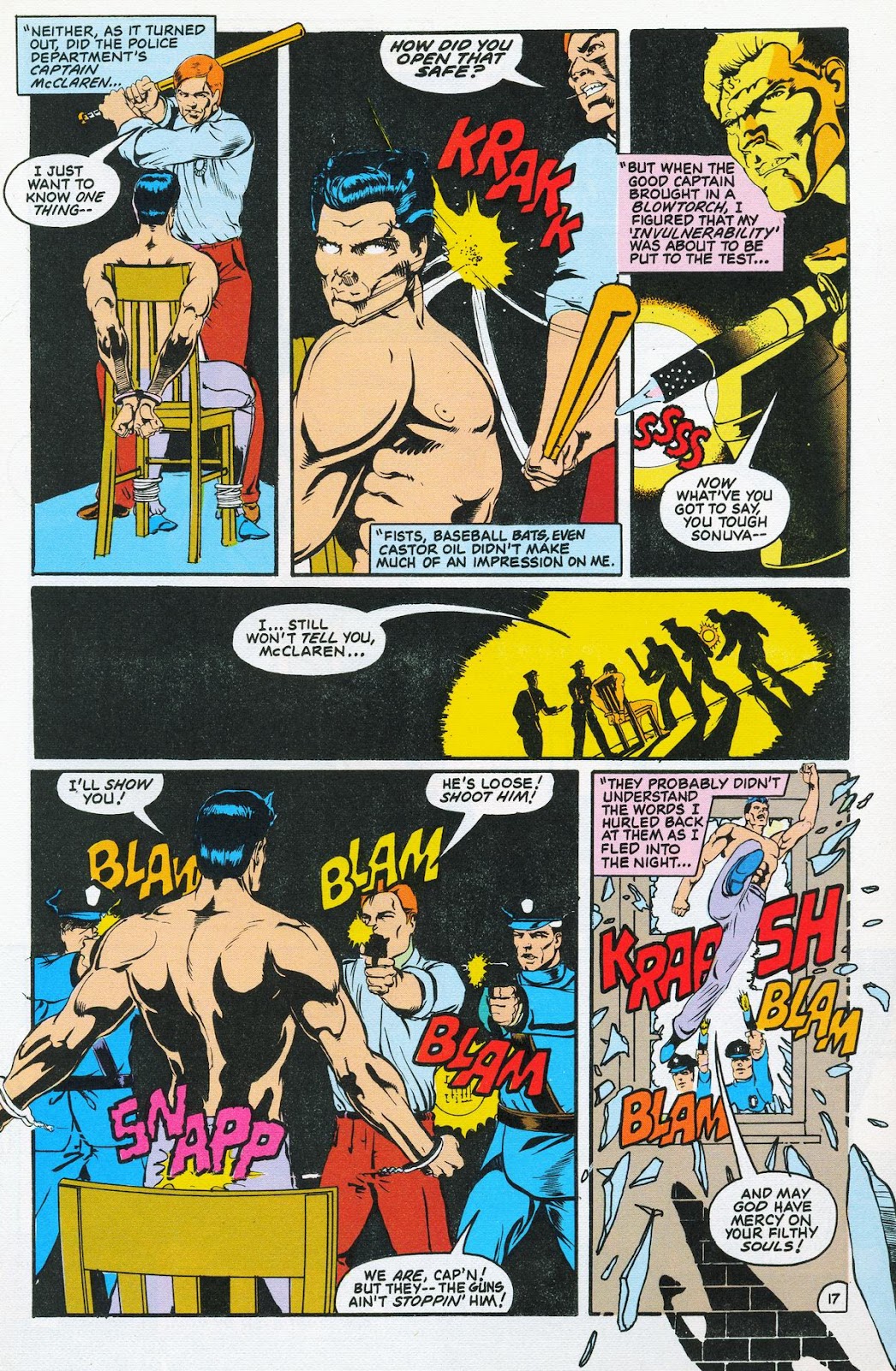 Hugo breaks loose and escapes. He returns home to visit his folks and hears that Anna Blake is now Anna Munro, married to the boy who flirted with her when Hugo left. 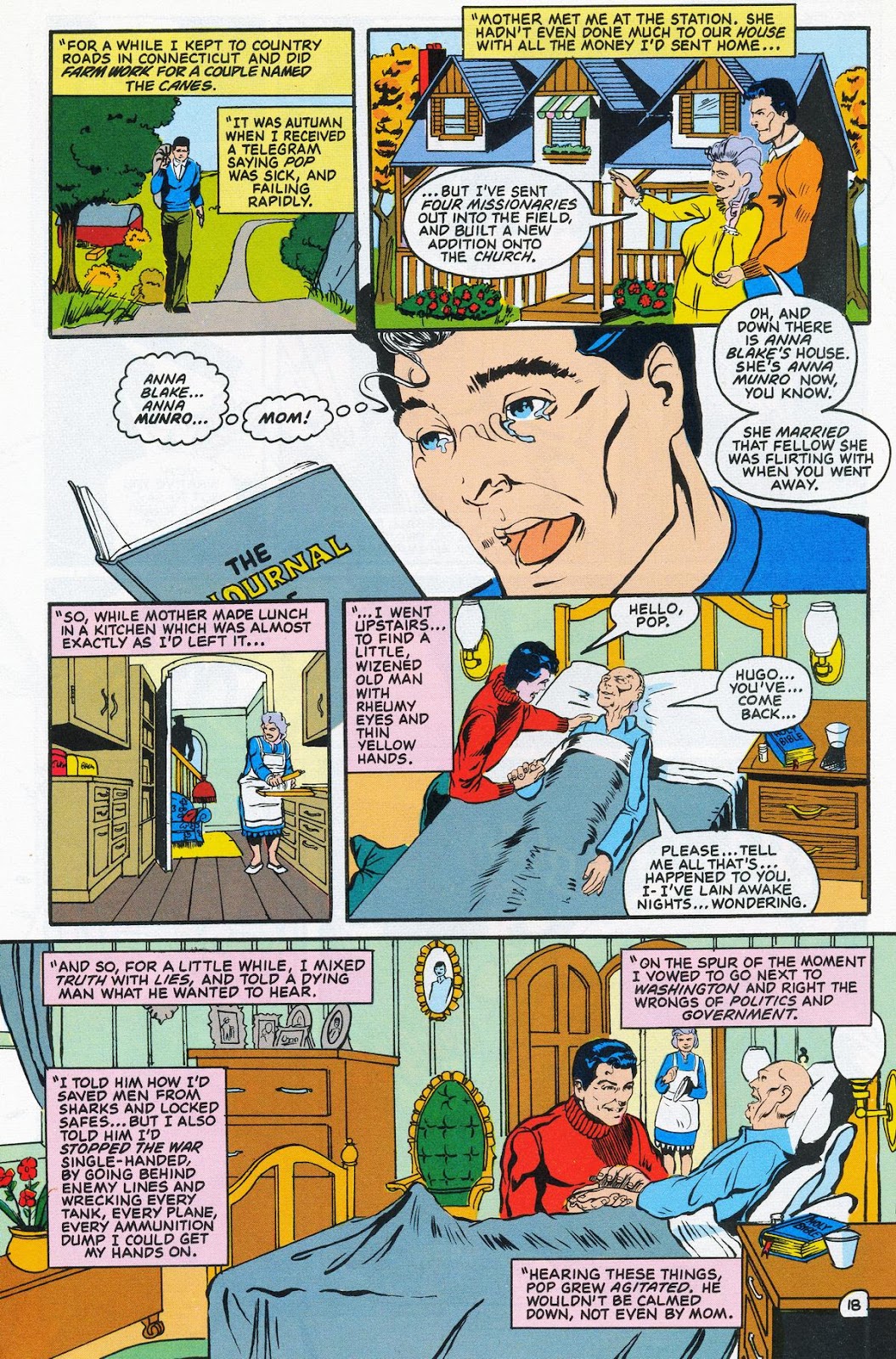 Abednego is dying and he entrusts his notebooks to Hugo, to decide if there will be more like him or not. He goes to Washington to try to fight corruption, but it is too big for him to do alone. he ends up joining an archeological expedition to the Yucatan (not put together by Dr Henry Jones Jr) and Hugo proves invaluable, cutting a path through the jungle and saving prof Hardin, the leader, from a falling slab. he dreams of others like him, but it is a nightmare of super warriors battling for supremacy, with innocents dying all around them. He says he is going off to challenge God and the diary ends. Prof Hardin adds the rest, as Hugo is struck by lightning and only charred remains are left for burial... 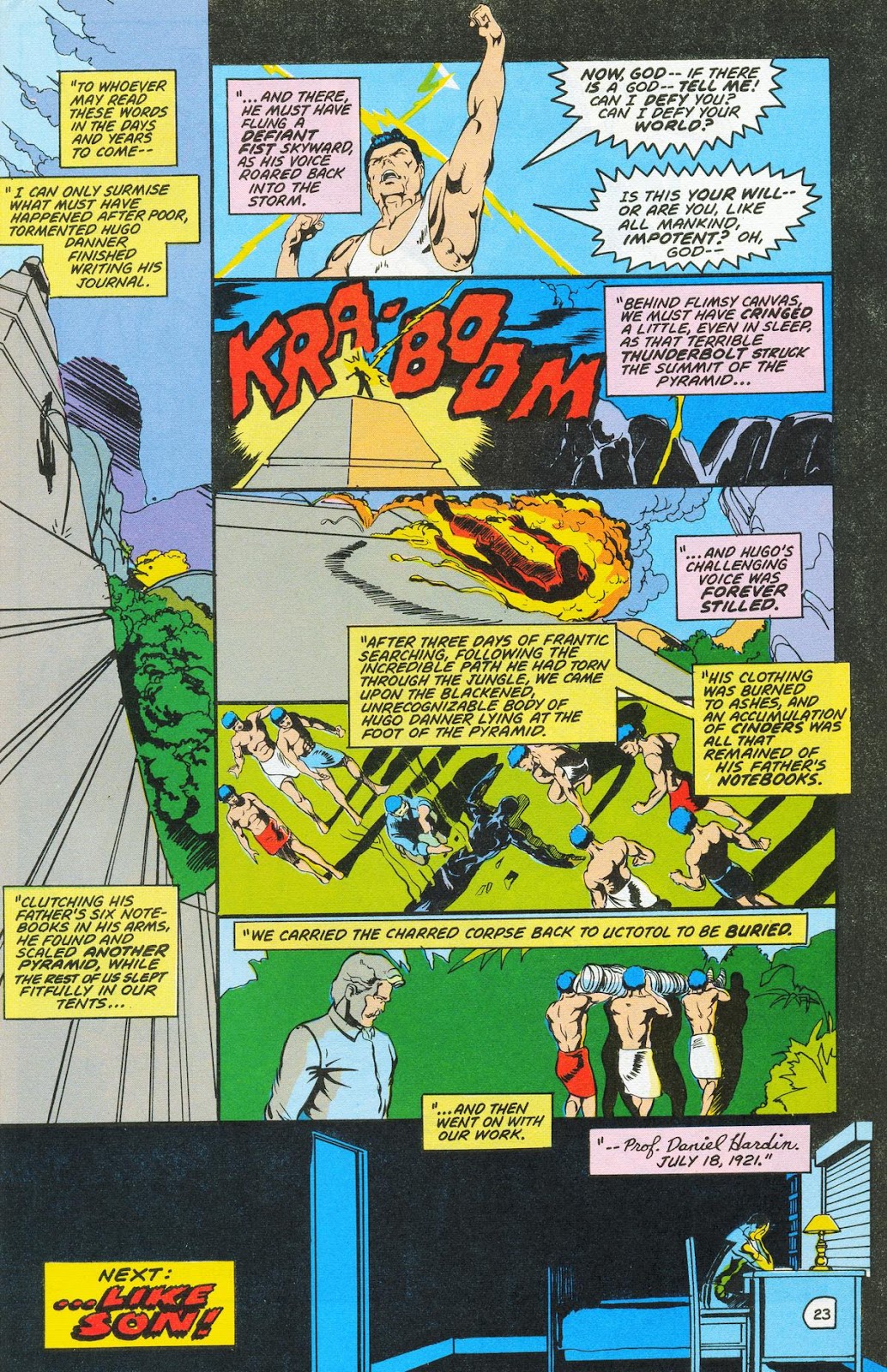 Thoughts: Thoughts: Gladiator was one of the chief inspirations for Superman (along with the works of AE Von Vogt, Edgar Rice Burroughs, SJ Byrne, Jonathan Swift and Robert Louis Stevenson) and every superhero that followed. Where it differs is in a mature depiction of a superbeing; one who is isolated from humanity by his power, rather than welcomed for it. Hugo never finds love and happiness, only sex and wealth and suspicion. Used accidentally, his strength kills. Used deliberately, it is horrifying. Others want his secret. he comes to hate his own existence and challenges God as to why he is made to suffer and is struck dead by lightning, in a rather abrupt and reality crushing conclusion. It felt like Wylie wrote himself into a corner and just miracled his way out. The rest is a nightmare vision of what Superman could have been, had Siegel and Shuster been more worldly and not starry-eyed kids. As it fits this series, we know know, for certain, that Arn "Iron" Munro is the some of Hugo Danner. I'm sure the next issue will confirm that Hugo impregnated Anna, before he left and that she married Munro to hide the paternity and the shame of conception out of wedlock (it is the early 20th century, after all). We don't know what happened to Prof Danner's notebooks and Ubermensch's knowledge of Abednego and Hugo Danner suggests they fell into the hands of the Nazis and created the Nazi Superman. Obviously, Roy will bring some kind of showdown between the two. No point in historical notes as this is all an adaptation of a work of fiction. Wylie used elements of the time (the novel was published in 1930), such as World War I, college football, athletic shows at carnivals, anarchists, stock manipulation, Washington corruption, and the like. There is as much social commentary in the novel as a rebuttal to the ideas of eugenics, as the experiments create a strong and nigh invulnerable Hugo, but he is of average intelligence. Gladiator would be adapted, in whole, in the future, by Howard Chaykin and Russ Heath, at Image, as the mini-series, Legend. The time frame is moved up to the Vietnam era, to better connect with a younger audience. Strangely, despite Hollywood's rush to churn out superhero films and even deconstructionist superhero projects, no one has touched Gladiator. Of course, to do so, someone in Hollywood would actually have to read a book, rather than get a pitch from a literary agent. Warner isn't likely to back a project that exposes Superman as a copy (something Fawcett really should have latched onto, in the lawsuit) and Disney isn't going to back something it doesn't own. Still, the book is always there, if you wish to seek it out.
|
|
|
|
Post by codystarbuck on Jun 8, 2021 15:12:08 GMT -5
Whoops, wait a minute; we got a problem here! If Hugo impregnated Anna before he left home, Arn would be in his 30s, as Hugo was born in 1894 and would have turned 18 in 1912. He fought in WW1 after leaving home and college. So, there is more to this story, then, especially if Hugo died in 1922, in the Yucatan. Arn isn't supposed to be older than about 18. Guess we have to wait for next issue!
|
|
|
|
Post by codystarbuck on Jun 14, 2021 23:02:09 GMT -5
Young All-Stars #11 Creative Team: Creative Team: Roy & Dann Thomas-writers, Michael Bair-pencils, Malcolm Jones III & Grant Miehn-inks, Augustin Mas-letters, Gene D'Angelo-colors. Elements adapted from Phillip Wylie's Gladiator. Synopsis: The gang touches down in Colorado and it looks like the whole town has turned out to greet them. Arn's mother is there and his girlfriend, Dottie, from the ill-fated date, as well as some less than happy people, upon seeing Tsunami... 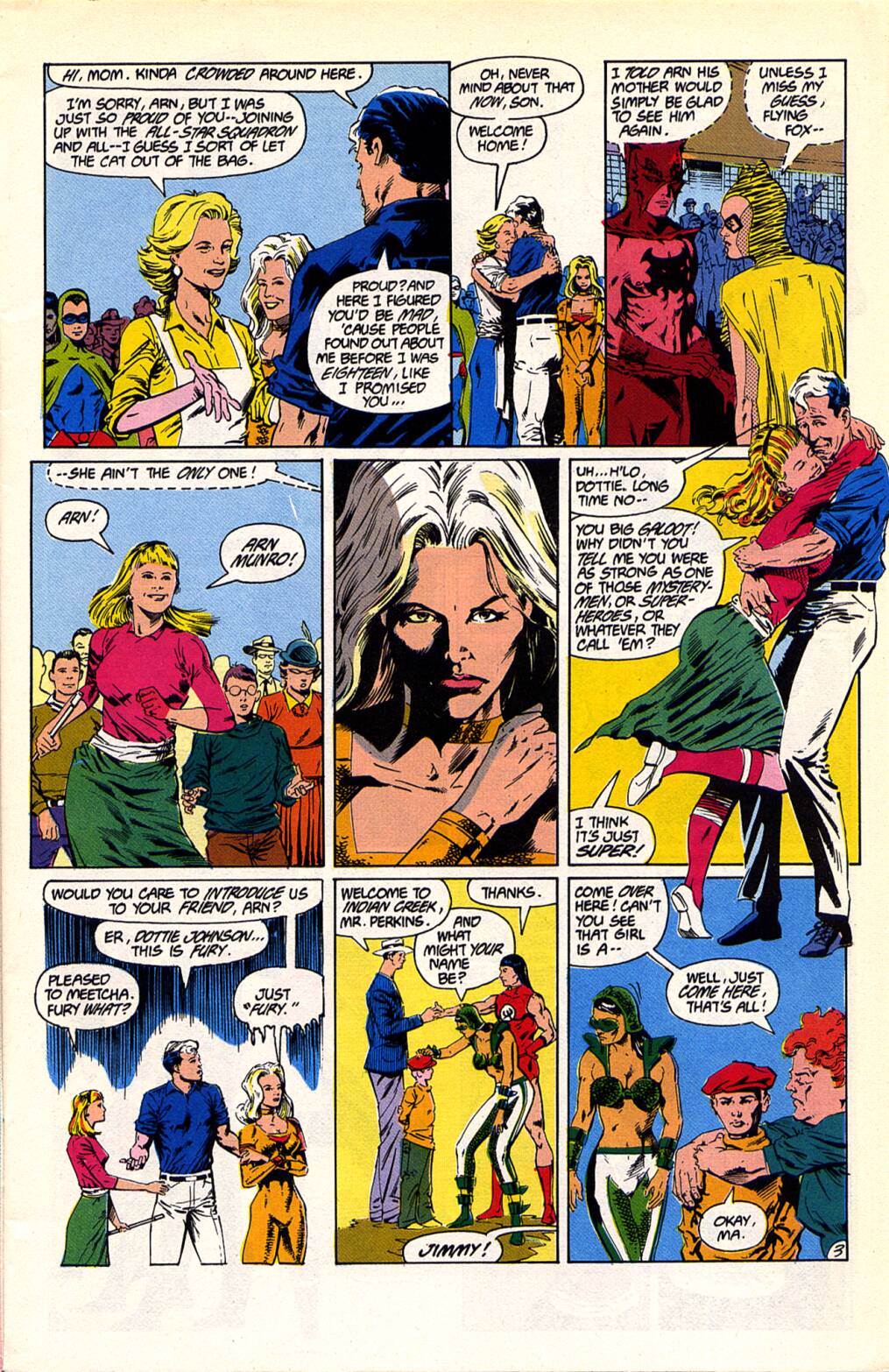 The mayor (Dottie's uncle) is about to give a speech and Fox supplies a wind to blow away his notes, before he drones on too long. Fury is not pleases to meet Dottie. They head off, after Dottie promises Arn a surprise he will like, at 9:00 pm, at the dam. Hope he followed Oscy's advice! (see The summer of '42). They head over to the Munro house and it turns out that they are related to the Bates.... 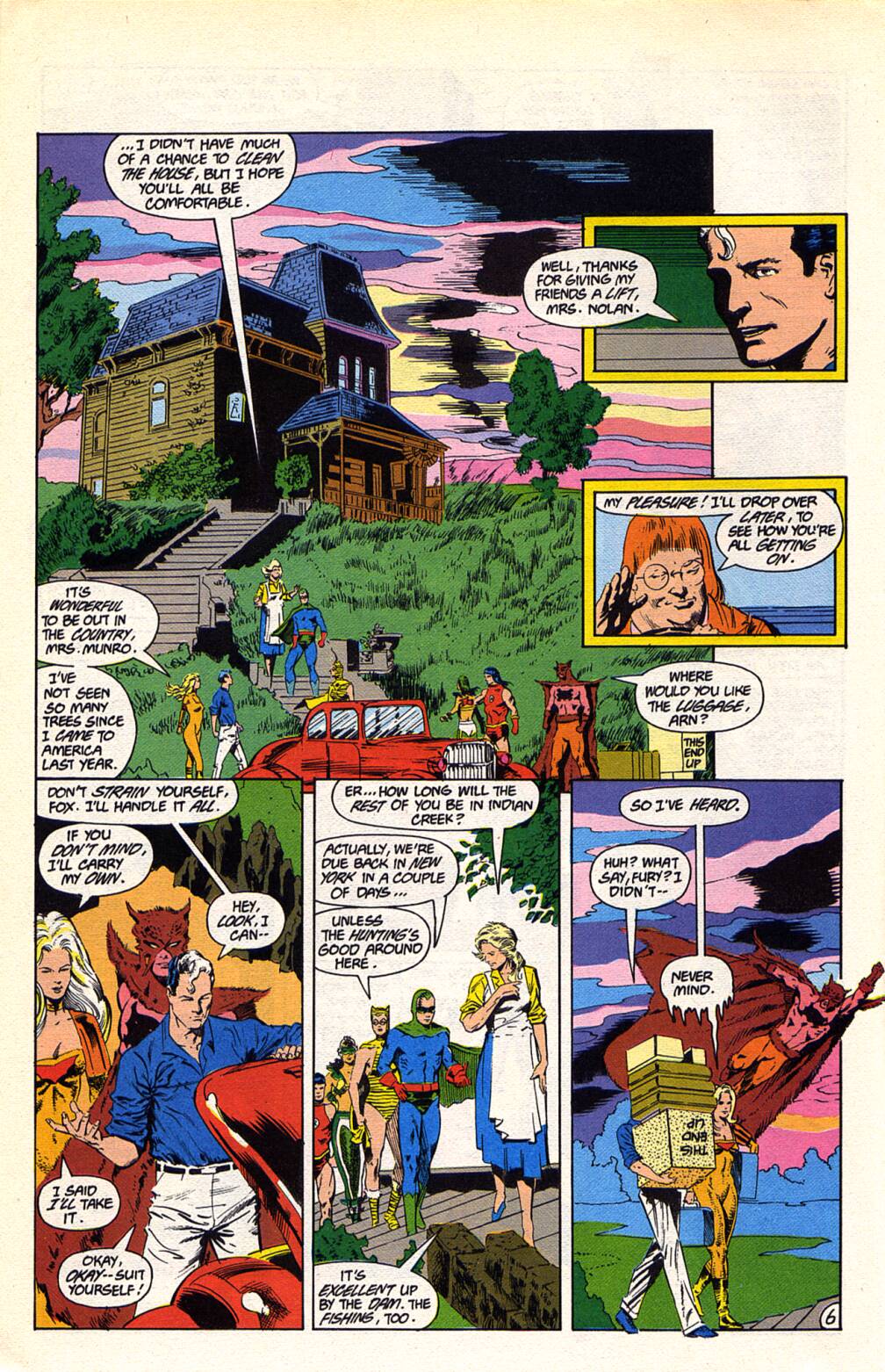 "Norman........" Fury is giving Arn the cold shoulder treatment and even his mother notices it. fury asks Arn's mother if he inherited his abilities from his father and mom quickly changes the subject. When Arn and his mother are alone, he reveals what he knows and she fills him in on the rest. They had a love affair the summer after graduation, but quarreled and parted. They wrote letters, but Anna finally let Hugo know she was going to marry John Munro. They saw each other again, at the funeral of Abednego Danner and Hugo left for his expedition to the Yucatan. John read her the news of Hugo's death. 3A few months later, Hugo's mother died and Anna went out to lay flowers on her grave and ran into Hugo, alive. She fainted. When she awoke, he was standing by her bed. he explained how he faked his death and substituted a Maya corpse. He returned to see her... 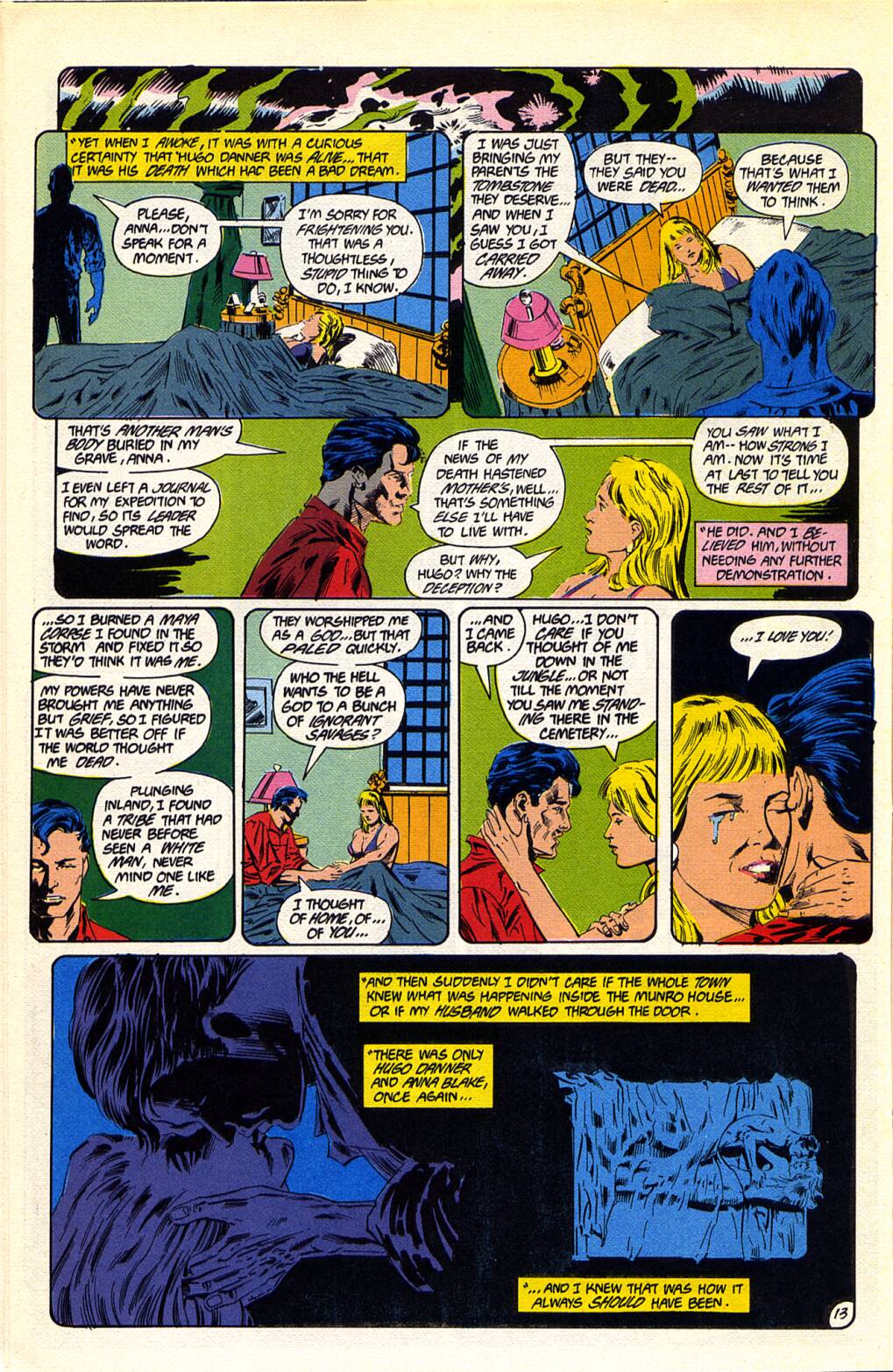 He left again and Arn was born 9 months later. They have dinner and Arn's mother relates how they discovered his abilities. They were walking home from a baseball game and some ground gave way under Arn's mother, dropping her into a crevice. Arn jumped down 40 feet, lifted her up and leapt out. They decided to hide his abilities and he held back in sports; but, it soon came out, when he leapt high in the air to catch a ball. People thought it was a fluke, but they began to look at Arn differently.... 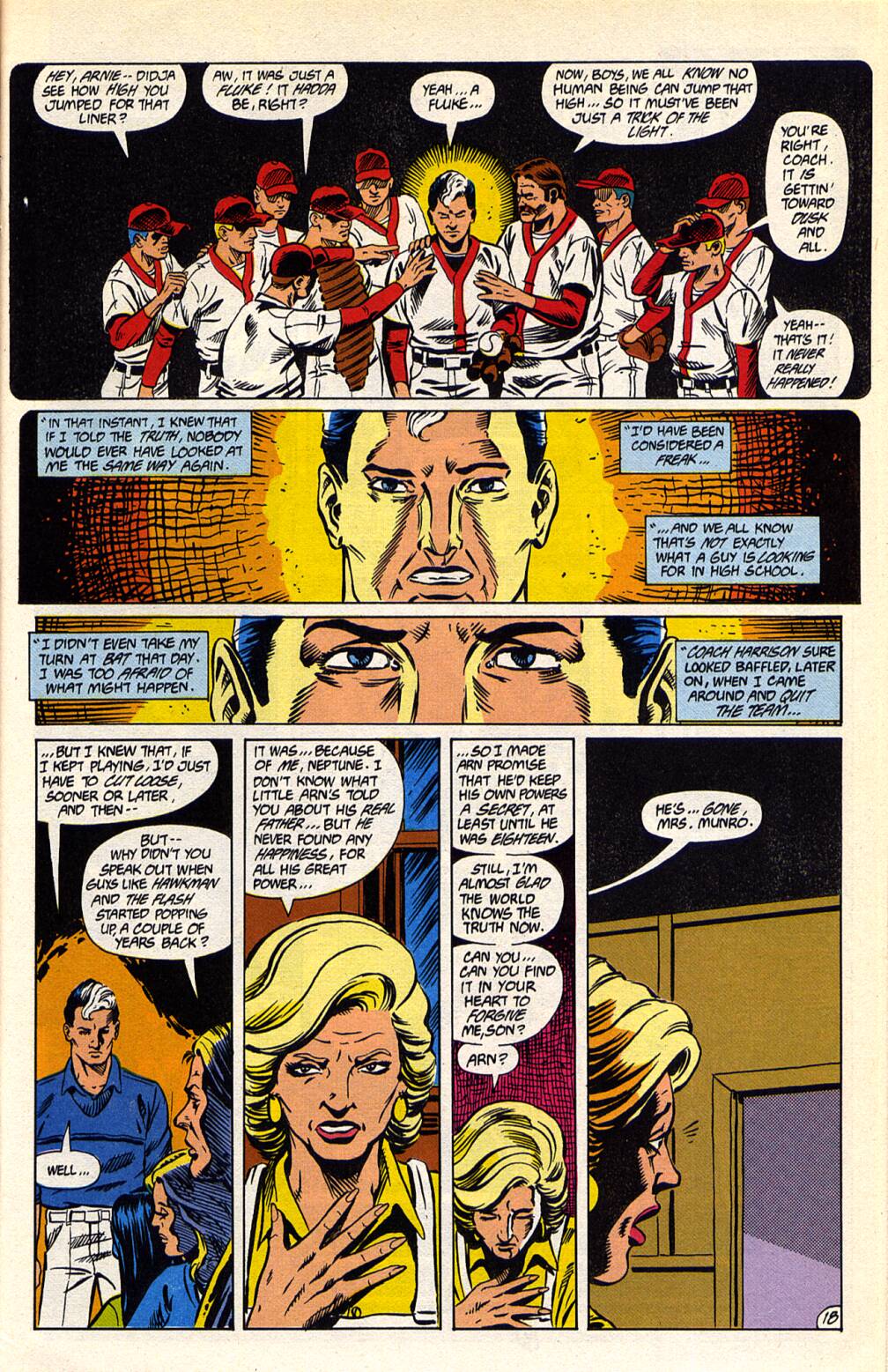 Arn hid what he could do because of his father's life. Arn goes off alone and Fury ends up following, with the mother's encouragement. She finds him on a mountain, with slabs of rock sticking out of the ground, like monoliths. It was created by Hugo Danner, as a place to be alone... 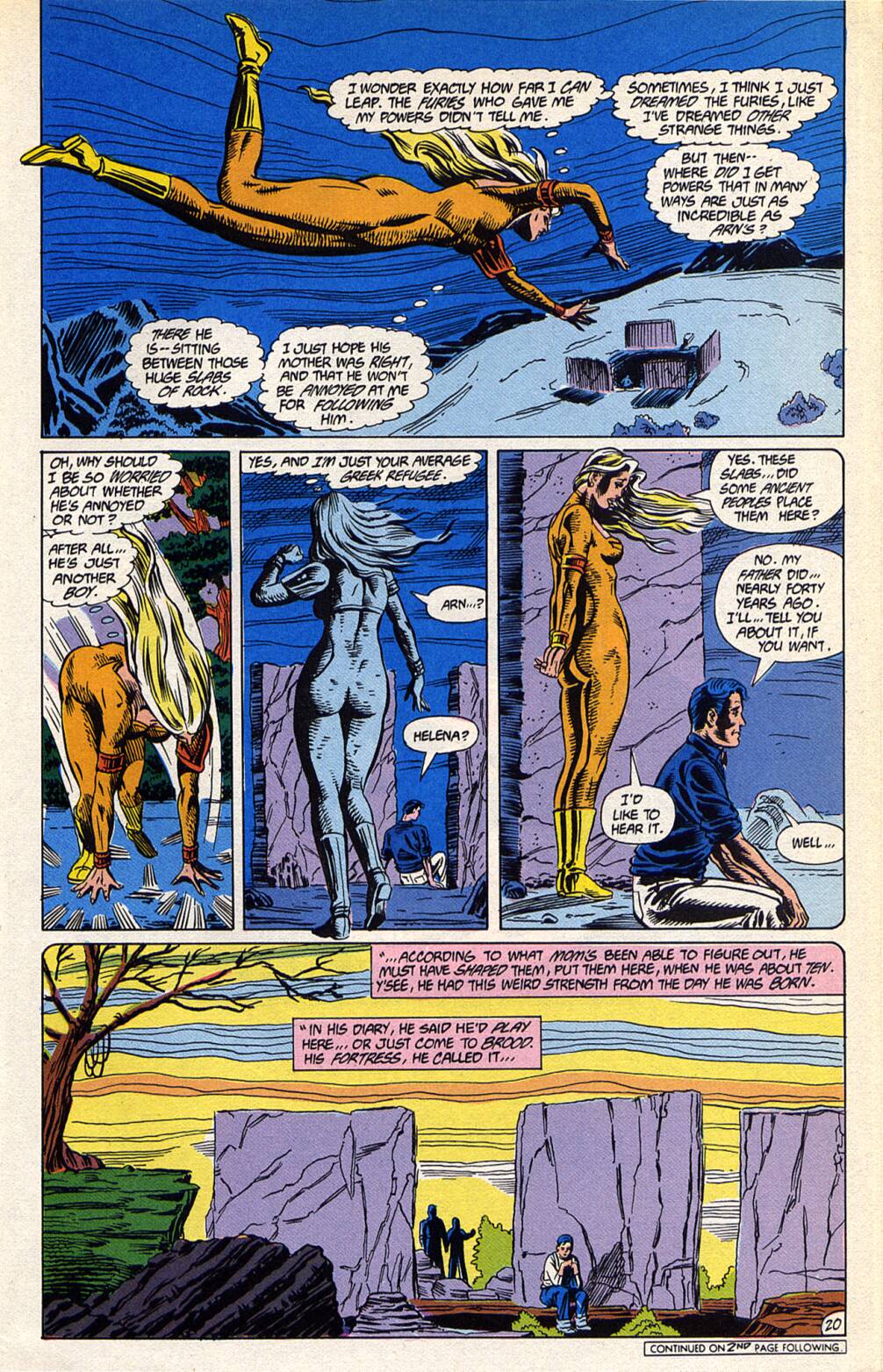 Some professors from the nearby university came there and found Hugo among the slabs, believing it to be an ancient site. When he claimed to have created it, one of them cuffed him for lying and he decked the jerk and chased them off. 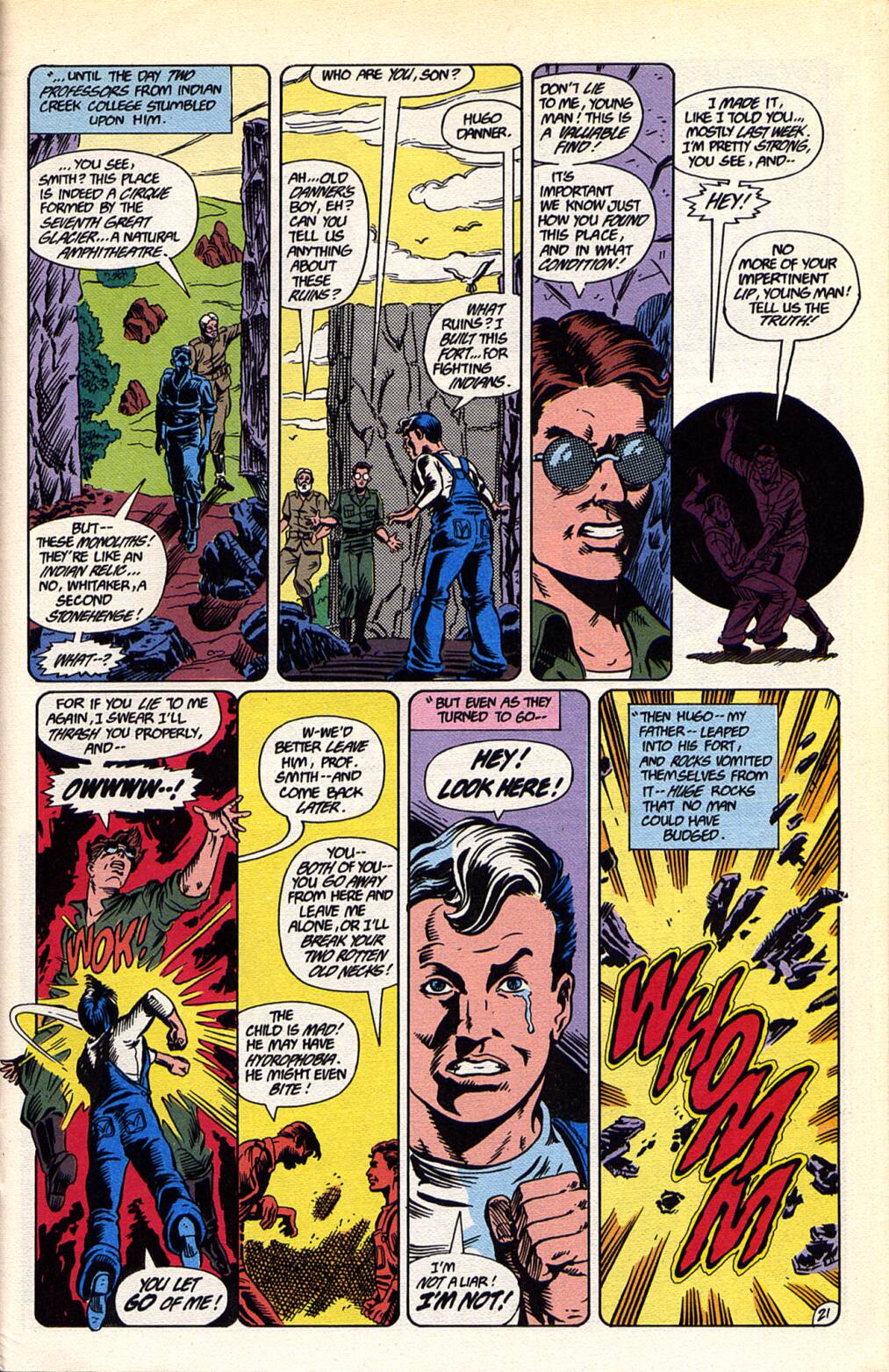 Arn relates this to Fury and theorizes that they may have known about his father and grandfather and might have been responsible for Abednego's journal's getting to Germany. There had been rumors about Hugo and the professors were from Indian Creek College, as was Abednego Danner. Arn believes they put two and two together and may have discovered the journals and taken them to Germany. he remarks that Ubermensch appeared to be about the right age to have developed from that time frame. Fury calms Arn and says she needs him and he doesn't make his date. The others go swimming or hunting at the dam and Arn and Fury join them, later and Arn reveals he will return to New York with them and they all believe they have finally become a team. Thoughts: So, Hugo Danner did not die after being struck by divine lightning and he fathered Arn while Anna was married to John Munro, after faking his own death. Arn's mother says John probably knew, but never said anything and she was always faithful, from then on. he died of a heart attack before Arn's abilities manifested. Arn's theory about the journals makes some sense, except why they would be taken to Germany, to the Kaiser's government, when neither of the professors is shown to be German. Doesn't hold up. It's been a while but I don't recall Hugo Danner creating a fortress with rock slabs, though he did test his abilities in the nearby woods. Probably Roy adding a touch to give the Superman substitute (and inspiration) a "fortress of solitude," even though that was a swipe of Doc Savage. Michael Bair makes the Munro house look like the Bates home, in Psycho, right up to the location, atop a hill. I recommend the girls just use the tub. This pretty much wraps up Arn's origin and also cements his relationship with Fury It doesn't really answer the mystery of Ubermensch and his knowledge of Hugo, nor what happened to Hugo. My guess is that info will come in the near future. Always liked Michael Bair on period stuff, though he doesn't get to depict the costumes and adventure, yet. Not sure about Grant Miehn's addition on the inking. Miehn came to DC after some work at Dark Horse, on The American, a pseudo-Captain America, created by Mark Verheiden and Chris Warner. Verheiden also came to work at DC and Miehn ended up handling the later issues of the Manhunter series and drawing The Legend of the Shield, for the Impact line, based on the Archie superheroes. This pretty much wraps up the first year of the book, and sets up future storylines. Historical Notes: the Battle of Coral sea and Operation Barbarosa get name dropped. Barbarosa was the German invasion of the USSR, after a neutrality pact secured Germany's eatsern border, allowing them to attack France, in full force. Once France was secure, Germany set its eyes on the Ukraine and other parts of Russia and Eastern Europe, for their oil fields, raw materials and farmland, to feed the German war machine and populace. It was probably Hitler's single greatest mistake, as it put Germany into a war on two fronts and pushed the suspicious Stalin into the arms of Churchill and Roosevelt. Germany would expend tons of material and thousands of life trying to conquer the USSR, to eventually be halted and then pushed back, as the Russian bear awoke from its slumber and made Germany pay for disturbing it. The Battle of the Coral Sea found the US and Australian navies confronting Japanese operations to take Port Moresby, on New Guinea. Naval signals intelligence learned of a build up and dispatched the USS Yorktown and Lexington, along with their escorts, to link up with a joint American-Australian cruiser force and attack the Japanese ships landing troops at Tulagi. The Yorktown's aircraft succeeded in sinking several ships, alerting the Japanese to the presence of an American carrier. The Japanese sought to locate and engage the carriers and destroy them, after missing them, at Pearl Harbor. Japan had 2 fleet carriers, the Shokaku and Zuikaku, plus the light carrier Shoho and sent aircraft from all three to locate and engage the US carriers. After first attacking other shipping, their air forces engaged the carriers and the US succeeded in sinking the Shoho and badly damaging the Shokaku. The Zuikaku lost many aircraft and their strike arm was badly depleted and the Japanese carrier groups withdrew. The Lexington and Yorktown were both badly damaged, though the Yorktown survived and was taken back to Pearl Harbor, where it was repaired and back underway in 72 hours, to join the Hornet and Enterprise for the Battle of Midway. The Lexington was badly damaged, but damage control parties managed to put out the fires and were making repairs, when an unattended motor set off sparks that ignited gasoline, starting new fires. They grew out of control and the order was given to abandon and scuttle the ship, creating the US Navy's first carrier loss. The Japanese loss of the Shoho and the damage to the Shokaku made them unavailable for Midway, while the Zuikaku lacked enough aircraft to sail with the Midway forces. This allowed the US to have parity during the battle, with three carriers and the aircraft compliment on Midway creating the equivalent of a 4th carrier. The Battle of the Coral Sea marked the first time two enemy fleets engaged without ever sighting one another, from ship, as the battle was carried out entirely from the air, showing that the future of naval warfare was in air power and not guns, as before. The battle was costly for the US; but proved to be advantageous and helped set up the decisive victory at Midway, which put an end to aggressive Japanese naval operations and had them revert to a defensive strategy. This led to a war of attrition the decimated Japan's experienced air crews, leading to successive inexperienced replacements, with greater damage at each turnover. Japan could replace their planes, but they lost experienced leaders at a rapid pace and their air crews became more and more ineffective, while the US gained more and more experience and applied the lessons learned, leading to things like the Marians Turkey Shoot, the Battle of Leyte Gulf and the ultimate push towards Japan. On minor historical quibble with the issue; Anna is depicted wearing blue jeans on the day she is reunited with the living Hugo Danner. This is around 1923-24. Very few women of that era would be wearing blue jeans to lay flowers on a grave. It was generally considered unseemly for a woman to wear trousers, apart from practical considerations, such as horseback riding (and that depended a lot on the locale and social status. No horse is seen to justify things and it is far more likely that Anna would be wearing a dress. One of those little details that makes period comics a difficult thing to pull off, with out research and attention. Roy is self-editing, which means he missed the point.
|
|
|
|
Post by codystarbuck on Jun 14, 2021 23:04:09 GMT -5
ps The Bates home, for comparison...  |
|
|
|
Post by codystarbuck on Jun 27, 2021 17:52:35 GMT -5
Young All-Stars #12 Creative Team: Creative Team: Roy & Dann Thomas-writers, Howard Simpson-pencils, Malcolm Jones III-inks, Jean Simek-letters, Gene D'Angelo-colors Special thanks for Randy and Jean-Marc Lofficier Roy doesn't elaborate what that means, in this issue. Synopsis: Arn has himself a new union suit.... 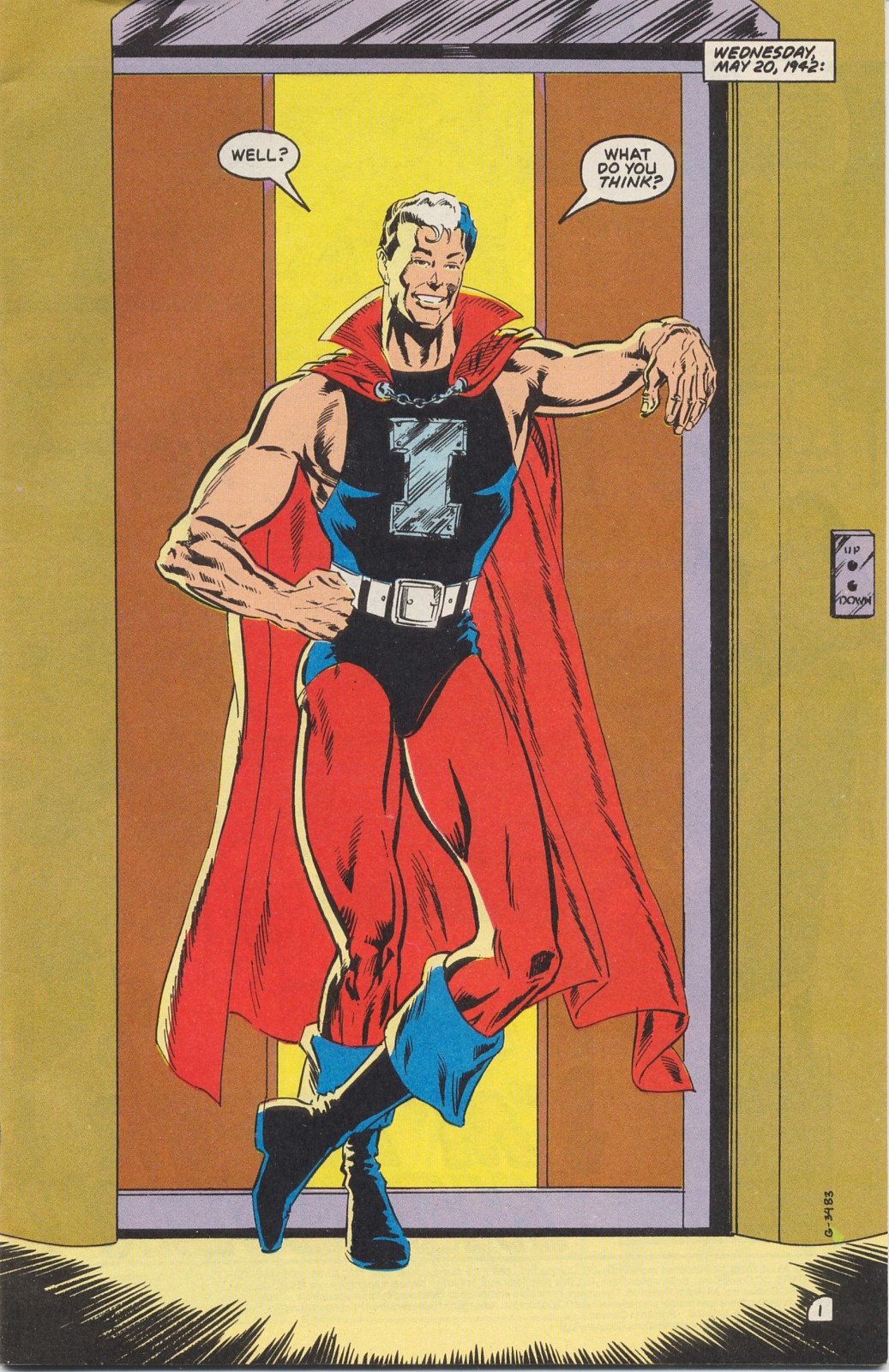 Yeesh.....I've seen better mid-card pro wrestling costumes than that! The rest of the team isn't exactly wowed, especially Fury and when Arn makes a crack about "peekaboo armor," she runs off in a huff. Tsunami says she will calm down when he apologizes, while tigress makes a play for Arn, who has been shown, in past, to think somewhere south of his head. Dyna-Mite starts to stick up for Arn, remarking of how he helped subdue Tisiphone, and Arn says they agreed that they wouldn't tell her, he doesn't want her knowing that she probably killed her own brother. Arn feels like a heel for the crack about Fury's armor, since she had no control over any part of becoming Fury. he goes off to apologize and Danny is still lost. Arn catches up to Fury and apologizes, but gets the silent treatment. However, it isn't deliberate. Fury is frozen, staring straight ahead, but, we soon find out why... 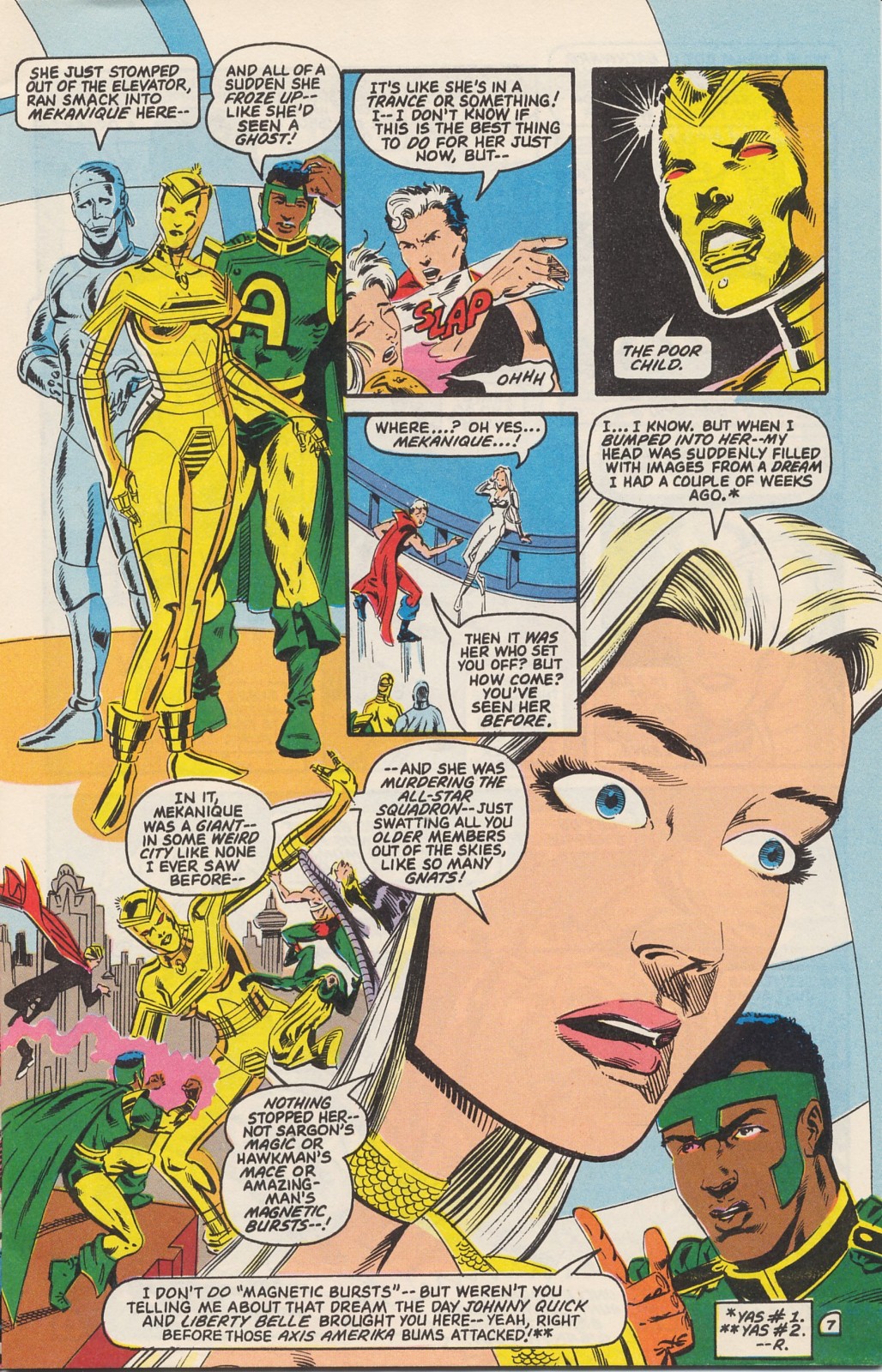 Fury recalled her dreams of Mekanique destroying the All-Stars, in her future, after bumping into her and Robotman, coming off the elevator. She relates the dream to Amazing Man, who is puzzled, since he doesn't have magnetic powers. Robotman is rather miffed that Mekanique seems to be accused of being a threat and pushes the point when Arn sugegsts he back off when he puts a bit too much pressure on Fury. Amazing Man plays peacemaker and dismisses it as a dream, where anything can happen. Fury apologizes to Mekanique, who offers her a hug, which pulls more visions into her head and Tisiphone is released... 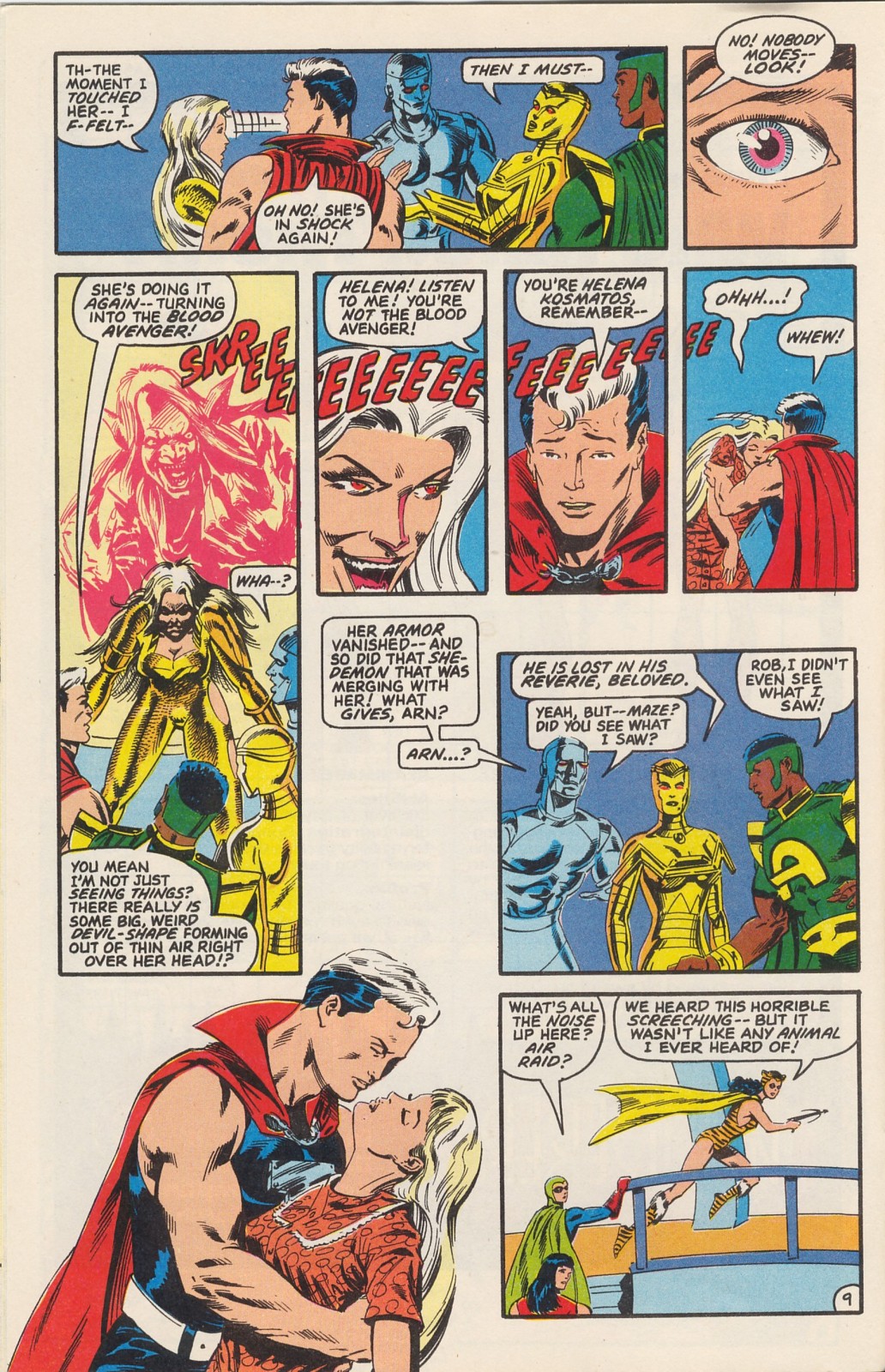 Arn talks her down and suddenly Tisiphone is gone, leaving Fury in average clothing, as Helena Kosmatos, who feints into unconsciousness. The rookies all turn up and asks "What up, dude?" and get the 411, like the kids say, and Arn gives them the wikipedia version. Tigress gets catty (not a joke, just an observation), making cracks about threats closer to home than Baron Blitzkrieg and escaped POWs. Arn explains and wishes someone could help Helena. Robotman says maybe Project M could...M for Monster. Arn doesn't like the name, but agrees, but tells Robotman to back off when he tries to lift Helena. Robotman gives him a warning that if he shoves him again, he might not make allowances. Mekanique adds another needle to the situation... 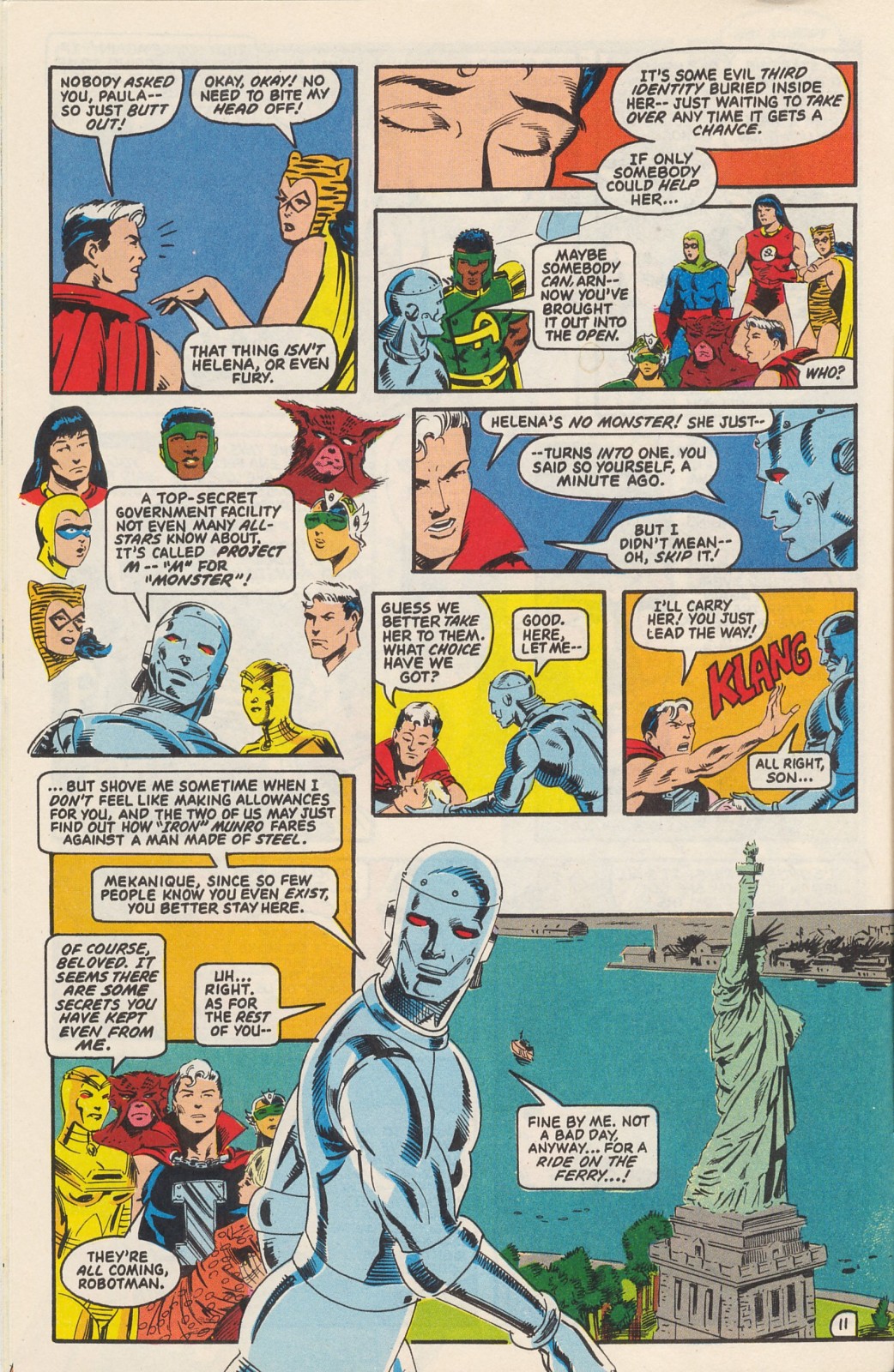 They go out to Liberty Island,(or Bedloe's Island, as it was until 1956, when it was renamed) and to a particular park bench, with a wet paint sign on it. Robotman presses two particular bolts on the back of the bench and a hatch opens in the ground. Flying Fax uses his powers to cast an illusion, to mask them from a passerby. They descend steps below the ground and come upon guards. Robotman gives the password, "Ish Kabbibble" and someone calls for Prof Mazursky. Mazursky is head of project M and he basically tells the sentries to tell the group to push off, until Chuck Grayson shows up and tells them to bring Helena to his section. he reveals that Mazursky isn't in as big a position of authority as he thinks. Meanwhile, in the background, Per Degaton sneaks off. Uh, oh! Chuck gives them a tour of the facility, underneath the Statue of Liberty, where the Creature Commandos were born... 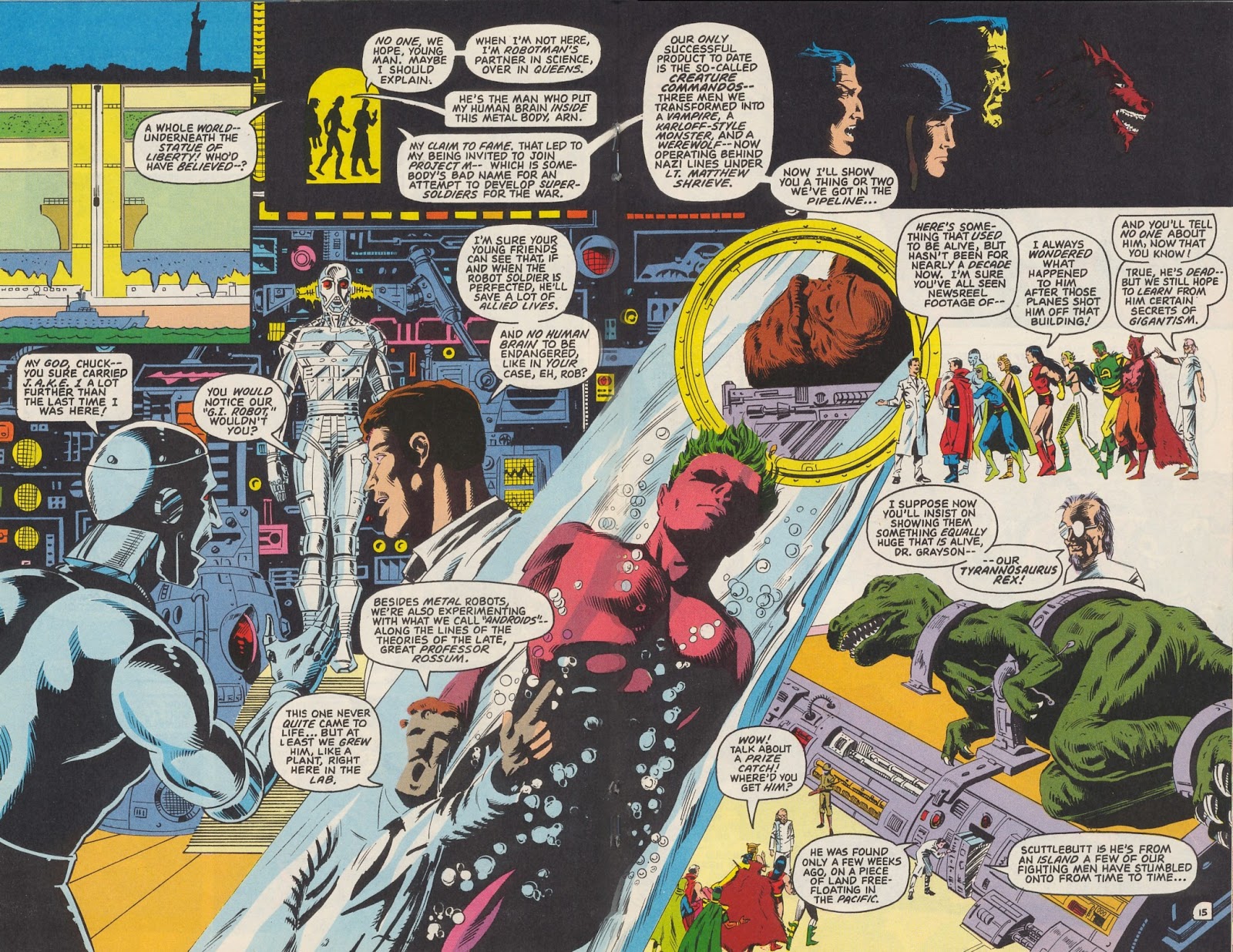 The project seeks to create super soldiers (sounds familiar...) for the fight against the Nazis; but, so far, the Creature Commandos are their only success. Chuck is working on JAKE 1, aka GI Robot, a robot solder. There is an android, grown in the lab, who looks familiar. They see a dead giant ape and Neptune Perkins remarks he wondered what happened to him, after the planes shot him off the building. Next, they see a live tyrannosaurus rex, captured on a remote island, in the Pacific. They also see the unconscious form of Miss America, of the Freedom Fighters, who was discovered off the coast of Oahu, comatose. They attend to Helena. Grayson scans her brainwaves and finds more than one set. Arn explains her backstory and then Dyna-Mite asks if Chuck can help. He tries an electrical therapy, which may be able to stop the episodes, but also may prevent her from being Fury. Of course, it is delicate and anything that disturbs it could prove fatal. Well, wouldn't you know it? Per Degaton sneaks down a tunnel to meet a bathysphere that docks and out of it comes.... 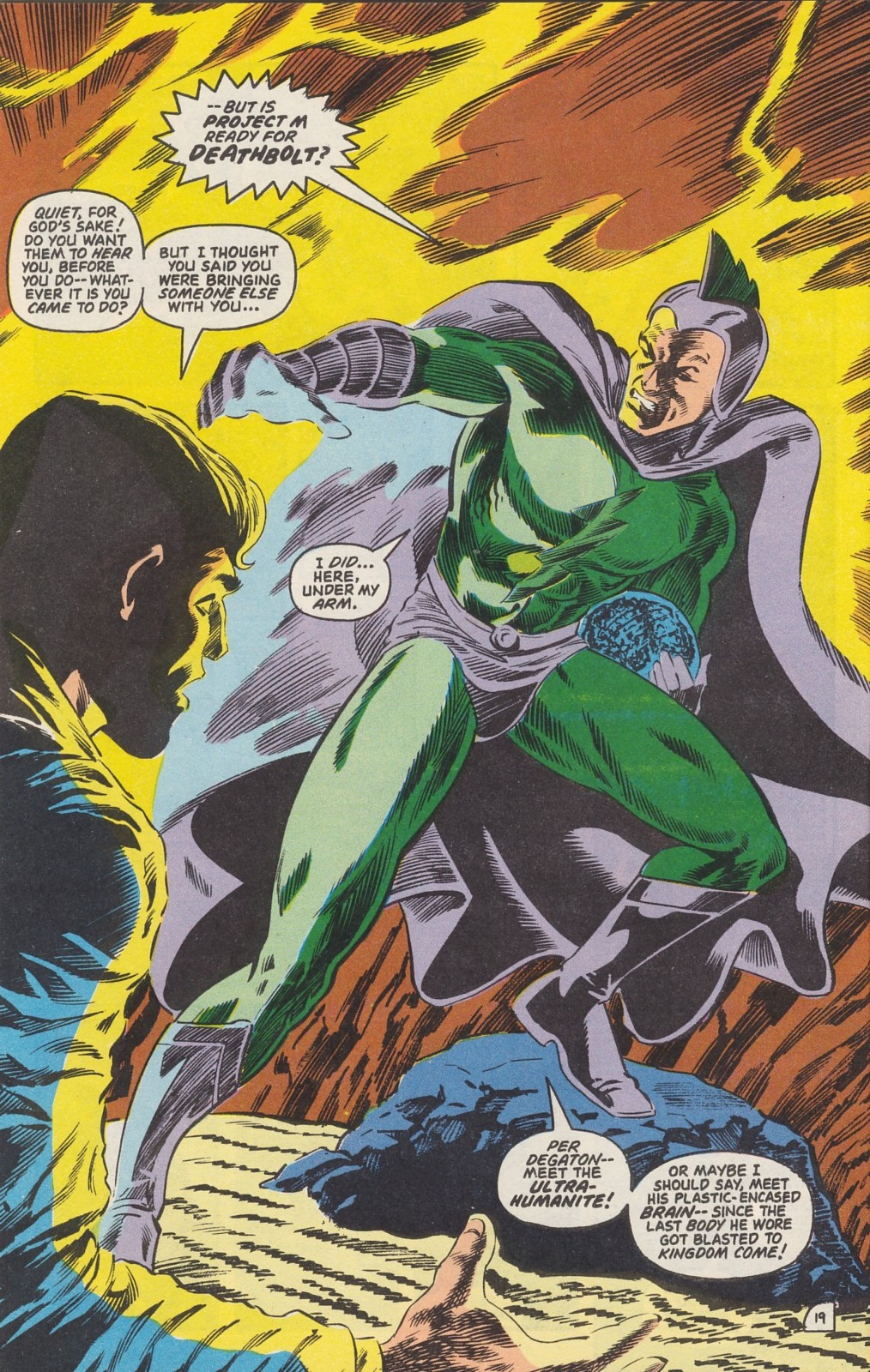 Deathbolt and the Brain of the Ultra-Humanite! Sounds like a Republic Serial! Deathbolt pulled his consciousness back from the explosion created by Cyclotron, to one of his labs, where he survived. he can communicate telepathically and it's all a bit above Degaton. Deathbolt remarks that the kid won't amount to much and Humanite agrees. They move on and Deathbolt kills sentries. Flying Fox senses something is up and goes off to check and runs into DB and UH and they scrap. Fox uses his illusion powers to fustigate DB, and Humanite guides his attacks, but Fox has DB outclassed, because he believes the illusions. He decides to close his eyes and he drops Humanite to cover them, and his brain sphere (like The Bowler's skull of her father, in a lucite bowling ball, except it is a brain, not a skull) rolls away. DB uncovers his eyes when he can't find Humanite and Fox suckers him with an illusion and he grasps a piece of equipment that sucks the lectrical energy from him... 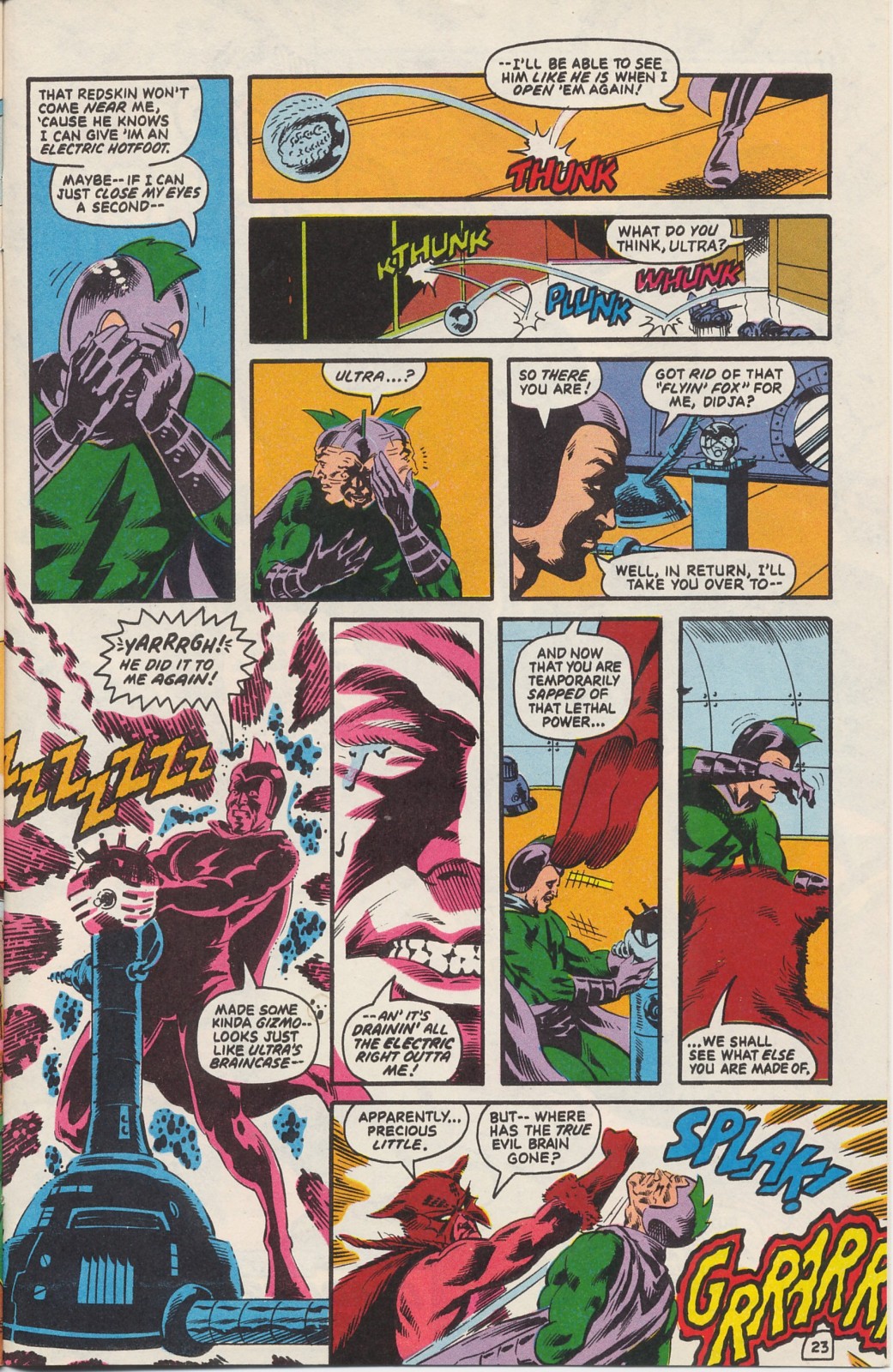 That's all well and good, until Humanite inhabits the body of the T-Rex and attacks. Thoughts: Well, that's some issue! We are now addressing Fury's "split personality", while also bringing Project M into the story. We also continue the relationship with Arn and Helena. Further seeds are planted with Tigress as a manhunter in more ways than one (never trust a girl in a tiger-stripe bathing suit) and Mekanique and her hold over Robotman, which seems to tie into Fury's dreams. Then, Deathbolt and Ultra-Humanite return, with an assist from Per Degaton, before his time travelling exploits. Lot of stuff going on here. Too bad it looks so amateurish. Howard Simpson is pretty green in the ways of comics and his staging isn't bad, nor his storytelling; but, his figure work varies quite a bit. Malcolm Jones is holding it together and there's some spectacular stuff and some excellent action; but, it still has a bit of a fanzine look to it, compared to other books of the period, which is one of the things that held this series back. We haven't had a really polished penciller for a long, consistent period and we are at the end of a year. Michael Bair had the most polish, but did the fewest issues. Bryan Murray and Howard Simpson are good artists, but they weren't as experienced and need some polishing at the edges. This smacks of old DC, where good inkers were paired with weak pencillers and vice versa, rather than the best person for the job. It's not necessarily a bad system, so long as one elevates the other; but, over the long haul, unless you see the weak one really grow, you start to lose interest. The strength of this book is decidedly in the writing. That also became the truth of the All-Star Squadron and Infinity, Inc, as Roy worked more with either newer talent or less stylistic artists. Infinity started out with Jerry Ordway and was about to transition to Don Newton, when he passed away from a heart attack. All-Star struggled from the moment Ordway left until the end, though Arvell Jones did fine work. It just wasn't as distinctive and didn't pull in the crowd, though Roy's stories were losing some of the pizzazz, too. Infinity got lucky, for a time, with Todd McFarlane, who didn't translate to sales, but livened up the look of things, plus, seem to inspire Roy to some new characters. Then, Crisis threw a big monkey wrench into everything Roy was doing and it jest continued from there. I keep feeling like the work is okay, because the story is good; but, I wish it were more spectacular, to match the story. I have to think that is part of why this never really grabbed a fan base. Leaving that aside, Project M makes for a bit of fun and I believe this is part of where the Lofficier's contributions come in. For the unitiated, they are a husband and wife combo who write and edit comics and prose fiction, including work for their own Black Coat Books. They are also experts on pulp literature and film, particularly French and other European countries (Jean-Marc is French, Randy is an American). They have been active participants in the literary Wold Newton Universe, based on concepts created by Phillip Jose Farmer, starting in his Tarzan Alive, a fictional biography of the hero, based on the original Burroughs stories. There, he created the concept that a meteor crash, near the village of Wold Newton, in England, was the source of abilities of various extraordinary figures in literature, including Sir Percy Blakeny (The Scarlet Pimpernel), Fu Manchu, the ancestors of Sherlock Holmes and Doc Savage, and many others, linking various characters from across literature. The Lofficiers expanded this into French pulp literature, bringing in characters like the Nyctalope,, Fantomas, Arsene Lupin, Irma Vep, the Black Coats, Dr Omega, Doc Ardan, and Judex, highlighting many antecedents to later American pulp heroes and comic book characters. Judex was a cloaked avenger from a silent movie serial, that predates the Shadow by 2 decades (though is greatly inspired by Dumas' The Count of Monte Cristo). Dr Omega was a time travelling older scientist, with companions, who bears a strong resemblance to the much later Doctor Who. Project M gives us King Kong, dead, but being dissected to find the secret of his size and power. The dinosaur is from the War That Time Forgot, from Star-Spangled War, where American GIs fight against dinosaurs, on a Pacific Island. Of course, the Godzilla series also later added elements to discoveries during the war that led to the awakening of Godzilla, after atomic testing (though much later in the series). This parallels to the newer Monsterverse franchise, with the Toho monsters, fueled by Godzilla and Kong. I also assume the android is intended to be Jim Hammond, aka The Human Torch, given Roy's fondness for the character. He also name drops Prof Rossum, the figure from Karel Capek's play, RUR (Rossum's Universal Robots), about a factory that creates artificial people (and popularized the term "robot"). The play features a scientist, named Rossum, who discovers a protoplasm that can be used to grow artificial beings. A nephew creates a factory to churn out artificial servants, who eventually rebel against their masters. The play was hugely popular in both Europe and America and influenced much science fiction writing that followed, including the Human Torch and the androids of Phillip K Dick's Do Androids Dream of Electric Sheep and the film adaptation Blade Runner, with its replicants. Per Degaton didn't appear until after WW2, so this is yet another past version. His history is that he murders Prof Zee, the inventor of a time machine (and Per's boss) and steals the invention to use modern weapons to conquer the ancient past and became ruler of the world. Deggie was there at the beginning of the All-Star Squadron and turned up again for the big JLA/JSA/All-Star Squadron Crossover. However, he usually ends up back in the past, with no memory of what occurred, back toiling away in Prof Zee's lab. Here, he is working at Project M, as a paid plant by Deathbolt and Humanite. No mention here of how he got in, but we can assume Prof Zee may be the connection. Maybe this will liven things up, as Ultra-Humanites little band of powerful villains made a pretty good enemy for the original All-Stars and livened up that book (aided by Ordway's renditions of the band). I will say that I do miss Humanite in female form, if for no other reason than his touchiness about the subject added a layer to the character. That and the fact that Humanite dressed his female form in some pretty daring attire for the period, which says a lot about his psyche. I have a sneaking suspicion that Roy is using this to set up Humanite getting his ape body that was seen when he was reintroduced, in the pages of JLA, during the George Perez-drawn (mostly) JLA/JSA battle with the Secret Society of Super-Villains (Lodge 413). Roy does remind us that we have to have read Secret Origins to understand why Miss America is there. Roy was also writing Golden Age stories for Secret Origins (and editing) and he was tying things into his other books, occasionally. The then-current issue, #26, included the origin of Miss America, who had become the substitute foster mother for Fury, of infinity, Inc and replacement for the Golden Age Wonder Woman and her spot as the JSA "secretary" (she had more of the outfit for it). In the story, reporter Joan Dale gets a message to go to Bledloe's Island and a park bench, with a wet paint sign, to get the inside scoop on a secret project. She does and sits down (after checking the paint and finding it dry) and waits, then falls asleep. He has a vision of The Statue of Liberty coming to life and granting her power. she awakes from the dream and finds she can transmute matter. This comes in handy when she stops some bundists and stumbles into a spy ring. She gets caught and locked in a trunk and thrown off a bridge (very republic Pictures story here) but survives and has transmuted her clothes into her Miss America costume, though she sticks with a rather short skirt and high heeled pumps for her fighting gear. Fashion over practicality. She is recruited by Uncle Sam and is part of his team that tries to fight the Japanese attack on Pearl Harbor. Only Miss America, Uncle Sam and Hourman survive. Hourman is hauled off by a Japanese sub (to tie back into the All-Star story of the birth of the Freedom Fighters) and Miss America and Uncle Sam are picked up by an American sub, under direction of a shadowy figure. She is taken to project M, where it turns out that they were the ones who secretly gave her the power, without her consent. This then leads into her being there, when Robotman and the rookies arrive.
|
|
|
|
Post by codystarbuck on Jul 9, 2021 16:59:53 GMT -5
Young All-Stars #13 Creative Team: Creative Team: Roy & Dann Thomas-writers, Howard Simpson-pencils, Malcolm Jones III-inks, Jean Simek-letters, Gene D'Angelo-colors, Mark Waid-associate editor Synopsis: At Project M, deep below the Statue of Liberty, Ultra-Humanite has inhabited the body of a T-Rex (Taken from Dinosaur Island) and is attacking the All-Stars. The group counter-atatcks, while Arn guards the machine providing Helena with electrotherapy. Dyna-Mite lets off a blast that topples Humanite... 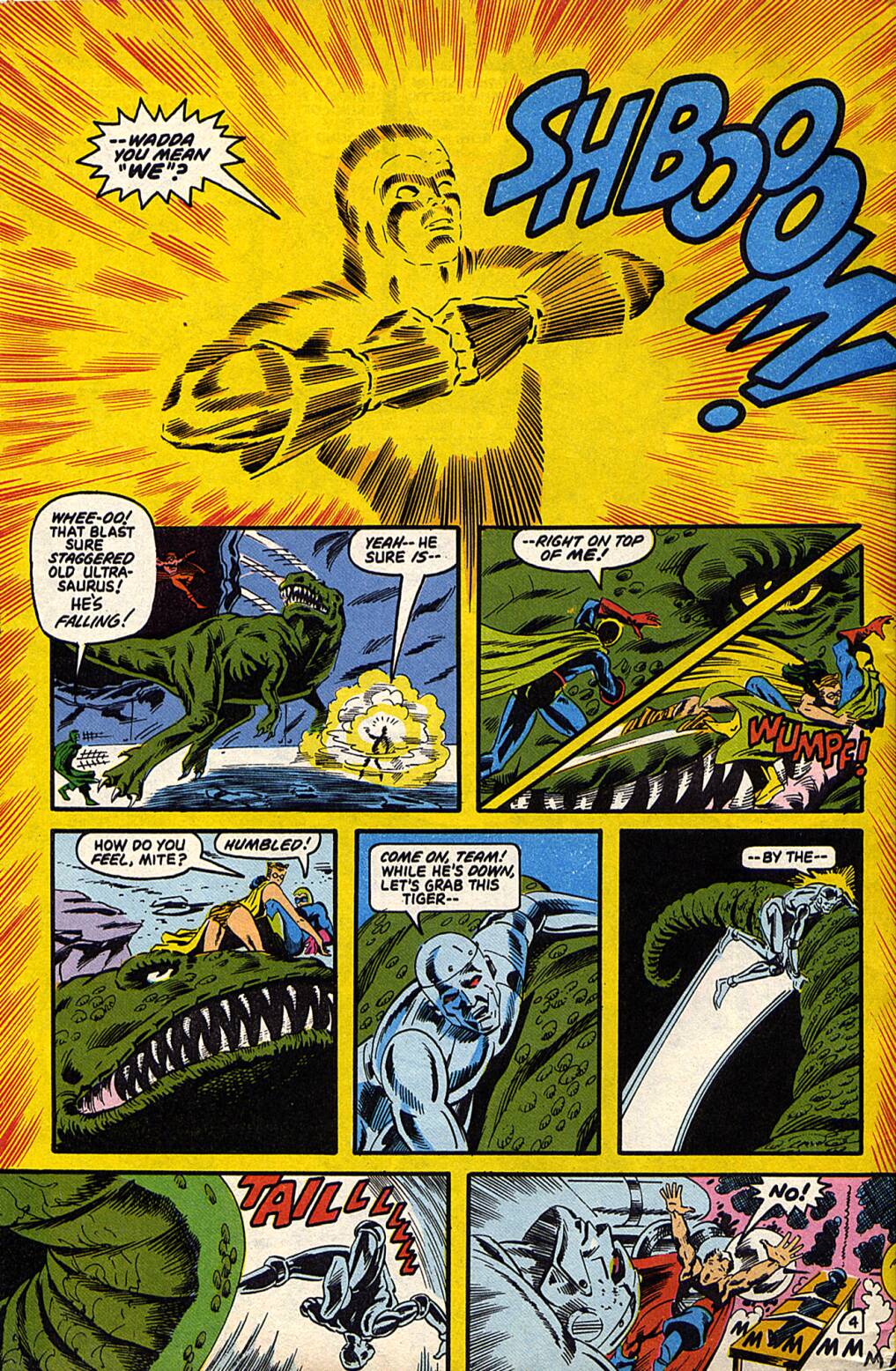 Robotman is hurled into Arn and the machine, and it is destroyed. Tisiphone is awakened and attacks the dinosaur. Ultra runs off and Tisiphone isn't returning Helena, so it is on. Tisiphone leaves the building and Arn chases her down, while Per Degaton does a lot of fast talking to hide his part in getting Deathbolt inside the project. Tisiphone corners Arn and they fight, but the Blood Avenger leaves him laying.... 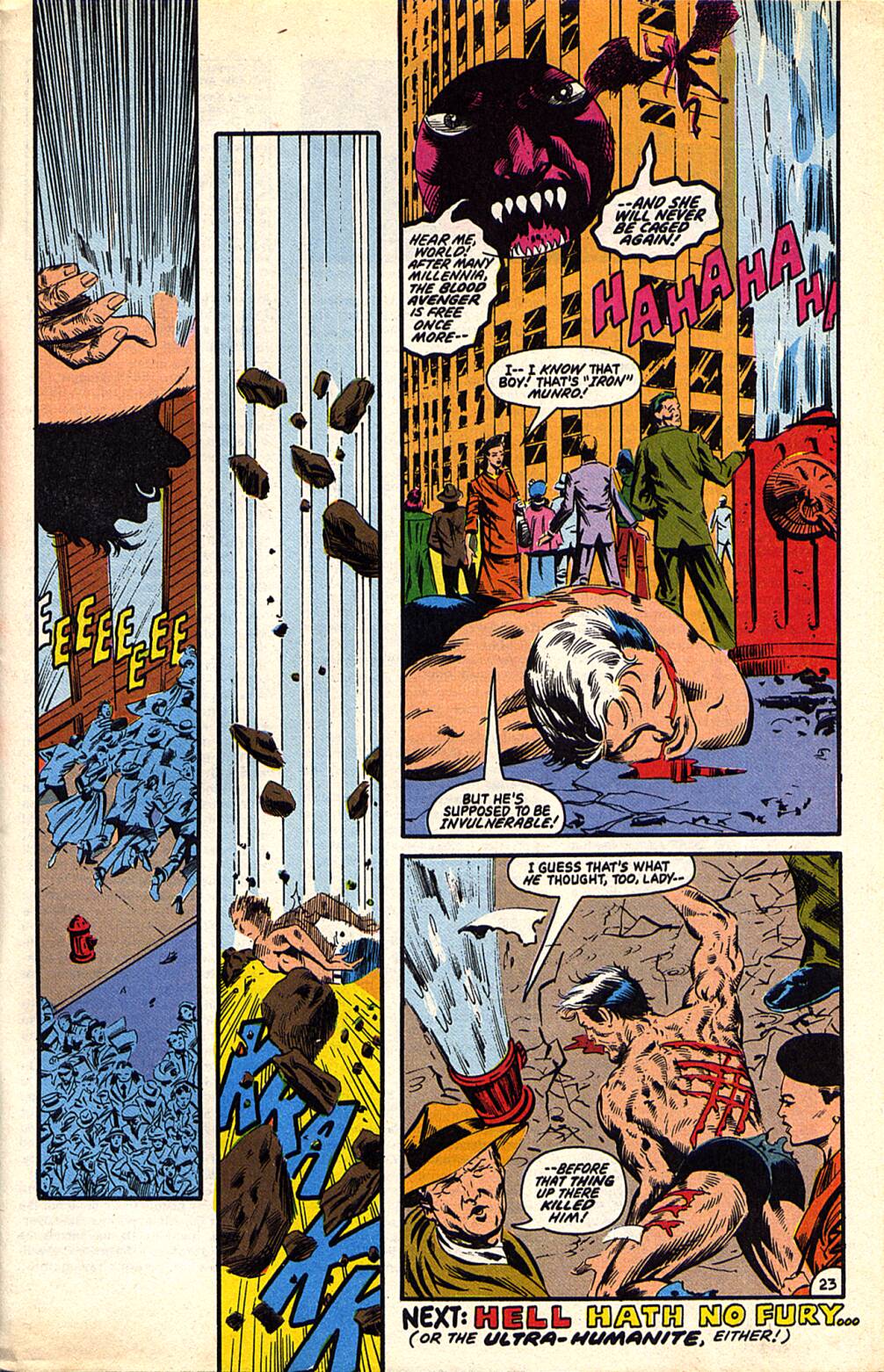 Thoughts: Thoughts: I'm not overly enthused with this issue. I described the high points, though fights cover a few pages and the rest of the time we have characters standing around talking and it doesn't amount to a great issue. I'll admit I'm swiftly losing my interest in this title and it wasn't that great, to begin with. The art isn't enough to elevate the weak characters and Roy isn't doing a lot to make this series that interesting. I'm not tapping out; but, if things don't start picking up, I might just start reviewing several issues at once to get it over with. Ultra is back for more, next issue; so, hopefully business will pick up.
|
|
|
|
Post by brutalis on Jul 9, 2021 19:42:29 GMT -5
You are a better man than me Gunga Din. I stopped following after issue 11. Remember flipping through 12 and 13, maybe even 14 and going mmmmnnnnnnnaaaaaahh, nothing for me anymore. Really laughed out loud too in seeing Munro's new outfit.
|
|



